









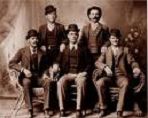



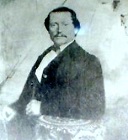





















TLW's American Westscope™ (American West Historyscope) |
By T.L. Winslow (TLW), the Historyscoper™ |
© Copyright by T.L. Winslow. All Rights Reserved. |
Original Pub. Date: Jan. 12, 2018. Last Update: Mar. 29, 2022. |


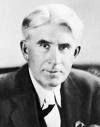

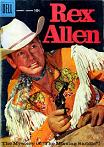

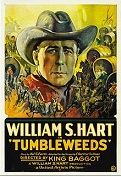
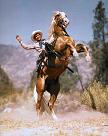





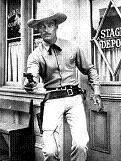




Westerners are not only known as history ignoramuses, but double dumbass history ignoramuses when it comes to the American West and American West history. Since I'm the one-and-only Historyscoper (tm), let me quickly bring you up to speed before you dive into my Master Historyscope.


Welcome to Hurricane Country? In Apr. 1528 the Narvaez (Narváez) Expedition, led by 1-eyed Spanish explorer Panfilo de Narvaez (Pánfilo de Narváez) (1470-1528) sails from Cuba with 300 soldiers and colonists in an attempt to colonize Florida (Fla.) (Sp. "land of flowers"), and lands on Apr. 14 near Cape Corrientes after discovering Pensacola Bay in the Fla. Panhandle; after exploring a dismal swampland filled with people who don't want them they end up in Tallahassee, and on Sept. 22 they set sail in five crude barges and try to reach the Panuco River, but get shipwrecked in Nov. on the Texas coast, where he tells his men "every man to himself - Spain ends here"; too bad, the Apalachee Indians kick his butt, and he barely escapes to the Mississippi River before being killed in Nov.; on Nov. 6 after surviving a storm at the mouth of the Mississippi River, his treasurer Alvar Nunez (Álvar Núñez) Cabeza de Vaca (1490-1557) (Sp. "cow head") and three others, incl. African (Moroccan) slave Esteban Dorantes (Estevanico) (1500-39) (first African to set foot in the future U.S.?) land on Galveston Island in Texas, and run into the Karankawa (Carancahua) coastal Indians, who take pity and feed them, showing them giant oyster beds and how to eat cattail "nuts"; Cow Head ends up separated from the other survivors, enslaved and taken to the mainland next spring, and spends eight years walking to the Spanish colony in Mexico while getting kicked around and meeting the indigenous pop. incl. the peyote-smoking Coahuiltecans (pr. cal-TEK-ans), becoming the first Euro to view Am. bison (buffaloes); he also later reports seeing "a devilish thing, and it is that I saw one man married to another"; when Estevanico returns to New Spain, he tells about hearing of the Seven Golden Cities of Cibola.

Don't just take your family on a vacation, take them on an adventure? Whitey finally reaches the far side, and it's gone in a flash? On Feb. 23, 1540 Francisco Vazquez (Vázquez) de Coronado (1510-54), gov. of Nueva Galicia leads an expedition of 400 men plus 1.3K-2K Indios, four Franciscan monks, and several slaves from Compostela, Mexico, exploring N Texas and invading New Mexico and conquering the Zunis (Zuñis); on Sept. 8 they establish winter HQ at the Indian pueblos of Kuau and Puaray, using it as a base for vain searches for the riches of Quivira; in 1934 archaeologists unearth ancient paintings of Indian god-demons behind 85 layers of adobe plaster; on May 9 Spanish navigator Hernando de Alarcon (Alarcón) leaves Coronado's party, goes by sea to the Gulf of Calif., then completes the explorations of Francisco de Ulloa the preceding year, satisfying himself that there is no open water passage between the gulf and the South Sea (Pacific Ocean); he then travels up the Colorado River (which he names the Buena Guia), becoming the first Euro to navigate it, viewing Am. bison (buffalo) ("tatanka"); Garcia Lopez de Cardenas (García López de Cárdenas) leaves Coronado's party and discovers the Grand Canyon and the Colorado River in modern-day Ariz.; another lt. of Coronado reaches the pueblos of the Hopi (Moqui); Capt. Hernando de Alvarado leaves Coronado's party and explores the Rio Grande River, stopping halfway at Isleta Pueblo (S of modern-day Albuquerque), which becomes a stopping place for every future Spanish explorer in New Mexico.

On May 8, 1541 after failing to find the fabled Mayan city of Yupaha (discovered in 2011 near Brasstown Bald Mt. in Ga.?), and reaching Mobile Bay in Ala., then fighting fierce Choctaw chief Tuscaloosa ("black warrior") (-1540), Spanish conquistador Hernando de Soto (1496-1542) and his 400 men discover the Mississippi River (2nd longest river in the U.S. after the Missouri River), and cross it near Randolph, Tenn., then explore Ark., becoming the first Euros to see Hot Springs, then Okla. and Tex.
In 1541 Francisco Vazquez de Coronado sets out from New Mexico on a 2K-mi. expedition across N Tex., the Okla. Panhandle, and E Kan. in search of the fabled rich Seven Cities of Cibola, esp. the city of Quivira (ends 1542); he carves his name and the date on a rock while searching for gold near the Cimarron River 20 mi. from modern-day Kenton, Okla. where the Santa Fe Trail later crosses the river, returning to Mexico City next spring with empty saddlebags after failing to find the fabled Seven Cities of Cibola; meanwhile Hernando de Soto explores the E border of Okla.
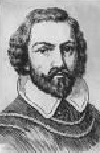
On Sept. 28, 1542 Portuguese navigator Juan Rodriguez Cabrillo (-1543), sent by New Spain viceroy Antonio de Mendoza in search of a northern strait discovers California (Calif.), landing at modern-day San Diego, and continuing N, discovering Monterey Bay on Nov. 16, and naming it Bahia de los Pinos because of the forest of pine trees; too bad, colonization is slow, and the first Spanish mission isn't founded until 1769 - why not call it Cabrillofornia? In 1544 Cabrillo dies of gangrene on Santa Catalina Island, and his pilot Bartolome (Bartolomé) Ferrelo (1499-1550) continues the expedition, exploring the Pacific coast as far as Oregon.
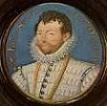
In Nov. 1577 not-yet-sir Francis Drake (1543-96), after being presented to the queen and sponsored by Hatton sets out from England with five ships to circumnavigate (not circumcize?) the world via Cape Horn while sacking Spanish towns and harrying Spanish ships that had been attacking English ships ("So it is that I would be revenged on the king of Spain for divers injuries that I have received" - Elizabeth I); his own ship is the Pelican, which he renames the Golden Hind (Hinde) as he enters the Strait of Magellan in honor of Hatton, whose coat of arms is a golden female deer; he completes his epedition in 1580, and is knighted in 1581. In Sept. 1578 English explorer and freebooter sure-to-be-Sir Francis Drake (1543-96) discovers the 400-mi.-wide Drake Passage between Cape Horn and the South Shetland Islands, rounding the Horn in 17 easy days, easily sailing past the lethal Four Evangelists and Desolation Island at the W end; in 1579 he is chased by the Spaniards up the coast of Calif., hoping to escape by the fabled Northwest Passage, and lands at Laguna Beach (Drake's Bay) near modern-day San Francisco, where the local aborigines mistake the fair English for gods and offer them their entire country, which he accepts, leaving a metal plate announcing the new English country of New Albion (N Calif.) "by the grace of God and in the name of her majesty Queen Elizabeth of England". Luck be a lady tonight, stick with me baby I'm a fellow you can win with, in 1936 San Fran store clerk Beryle Shinn discovers the plate while hunting pheasant, and it ends up on display at the U. of Calif. Of course, the Spanish pooh-pooh Drake's claims, and claim all of California for themselves, although maybe Portugal should be given San Diego for equity, ask the pope, oh yes, he already decided that question, and Cabrillo was working for the Spanish anyway. On Sept. 26, 1580 after crossing the Pacific to the East Indies, Drake arrives in Plymouth, England, becoming the 2nd man to lead a round-the-world voyage (36K mi.) (began 1577); the queen gives him a green silk scarf, but rumors of his pirate habits eventually take the shine off, and the queen keeps 20% of his £800K treasure haul.
On July 5, 1595 Portuguese explorer Sebastiao Rodrigues Soromeno (Sebastián Rodríguez Cermeño) (1560-1602) sails from Manila in the San Agustin, reaching land between Point St. George and Trinidad Head in Calif. on Nov. 4, then S to Drakes Bay on Nov. 7, where Native Ams. greet him, but aren't as wowed as when they saw Sir Francis Drake in 1579; after a storm blows them N, their ship sinks, and they switch to a launch named the San Buenaventure, then leave on Dec. 8, heading S as fast as they can, failing to notice San Francisco Gay, er, Bay, discovering Monterey Bay on Dec. 10 and naming it Bahia de San Pedro in honor of St. Peter Martyr, and arriving at Puerta de Chacata, Mexico on Jan. 17.


In July 1673 Ft. Frontenac is founded on the mouth of the Cataraqui River on the St. Lawrence River near modern-day Kingston, Ontario, Canada by Rene-Robert Cavalier, Sieur de La Salle (1643-87), who gave away his father's fortune to join the Jesuits and sailed for New France in spring 1666, hoping to find a western passage to China; in Sept. 1679 after building Fort Conti at the mouth of the Niagara River on Lake Ontario early in the year, then building the 7-gun 45-ton barque Le Griffon, he sails with Father Louis Hennepin (1626-1705) to Lake Erie, Lake Huron, and Michillmackinac, discovering Niagara Falls, then sails through the Detroit River to Green Bay, ditching the barque and switching to canoes, paddling down the W shore of Lake Michigan to the mouth of the Miami (St. Joseph) River, building Fort Miami on the shores of Lake Superior near modern-day Duluth, Minn. in Jan. 1680, and leaving on Dec. 3, reaching modern-day South Bend, Ind., then crossing the Kankakee River to the Illinois River, building Fort Crevecoeur near modern-day Peoria, Ill., surviving a mutiny and canoeing down the Mississippi River in 1682, naming Louisiana after Louis XIV and claiming the entire territory for him, then building Fort Saint Louis at Starved Rock on the Illinois River to replace Fort Crevecoeur before leaving for France, returning on July 24, 1684 with a large expedition incl. four ships and 300 colonists, founding Fort Saint Louis on Garcitas Creek in modern-day Victoria, Tex., claiming Texas for France; too bad, while searching for the mouth of the Mississippi River, La Salle is ambushed and killed on Mar. 19, 1687 by Pierre Duhaunt in modern-day Navasota, Tex.; his fort on the Illinois River is later taken over by John Jacob Astor's fur trading co.

The Indians finally yuck it up on the Conquistadors? On Aug. 10, 1680 after a decade of drought, white man's diseases, and suppression of their medicine men, the Pueblo (Po'pay's) (Pope's) (Popé's) Revolt (ends 1692) begins in Pueblo of Isleta in New Mexico 13 mi. S of Albuquerque against the Spanish, led by pagan Tewa religious leader Po'pay Pope (Popé) (1630-88) ("pumpkin mountain"), who stages a blitzkrieg attack, killing 380 Spaniards, incl. 21 of 40 Franciscans, followed by a siege of Santa Fe, causing Spanish settlers to flee S on Aug. 21 to El Paso del Norte (until 1691), closing El Camino Real and becoming the most successful Indian revolt in history, after which Po'pay sets himself up in the governor's palace and orders all vestiges of Roman Catholicism destroyed, washing Catholic converts in yucca juice to get rid of the yucky white man's stink; El Paso (modern-day pop. 650K/1M) is founded near El Paso del Norte (modern-day Ciudad Juarez) as a temporary capital of the New Mexico territory until Santa Fe is reconquered in 1692, remaining the largest settlement in N.M. until 1848, when it becomes part of Tex., after whch it is incorporated in 1873; meanwhile in 1682 Spanish fugitives from the revolt, joined by Tigua (Tiwa) Indians found La Purisima del Socorro Mission (Nuestra Senora de la Concepcion del Soccoro) halfway between Santa Fe and El Paso, waiting for the various Pueblo tribes to begin infighting and play into their hands, and Spanish fugitives found the Ysleta Mission in El Paso.
In 1689 Spanish explorers discover the remains of Fort Saint Louis, and meet reps of the Caddo people who live between the Trinity and Red Rivers, claiming they are eager to learn about Christianity, causing Alonso De Leon (1639-91) AKA El Mozo to establish a Roman Catholic mission in May 1690 in East Tex. near the Hasinai village of Nabedaches, holding its first Mass on June 1; too bad, after floods and an epidemic kill half the pop., the people turn on the missionaries, causing them on Oct. 25, 1693 to burn the mission, bury the bell, and flee to Mexico, returning on July 3, 1716 to establish Nuestro Padre San Francisco de los Tejas, which in 1721 is renamed Mission San Francisco de los Neches, and moved in 1731 to San Antonio, Tex. under the name Mission San Francisco de la Espada; meanwhile in Sept. 1690 Mission Santisimo Nombre de Maria is established in East Tex. 6 mi. NE of Mission San Francisco; it is destroyed by a flood in 1692.
In 1716 Spain begins establishing Roman Catholic missions in East Tex., starting with Mission Senora de la Purisima Concepcion de los Ainais on the Angelina River, serving the Ainais tribe until the French threat causes them to close it and reopen it in 1721, then move it to Austin, Tex. in 1730 followed by San Antonio, Tex. in 1731 as Mission Nuestra Senora de la Purisima Concepcion de Acuna; in 1716 Mission San Jose de los Nazonis is established near modern-day Cushing, Tex., moving in 1730 to San Antonio as San Juan Capistrano; in 1716 Mission Nuestra Senora de Guadalupe de los Nacogdoches is established in East Tex. to serve the Nacogdoche tribe, later becoming the town of Nacogdoches, Tex.; in 1716-17 Mission San Miguel de Linares de los Adaes is established 20 mi. W of the French fort at Natchitoches, La. to serve the Adaes tribe; in 1717 Mission Nuestra Senora de los Dolores de los Ais is established near modern-day San Augustine, Tex. to serve the Ais tribe, moving to San Antonio in 1719; on May 1, 1718 Mission San Antonio de Valero is established on the San Antonio River by Father Antonio de Olivares and New Spain viceroy Marquis de Valero as the first of a mission chain for Christianizing Indians, becoming known as the Alamo in 1744; on May 5 Gov. Martin Alarcon founds Villa de Bejar 3/4 league upstream at the headwaters of San Pedro Creek, which becomes the capital of the New Spain province of Tejas, the northernmost settlement in the Valley of Mexico; the mission is abandoned in 1793, becoming a military depot and fortress until 1836, when it becomes the Alamo, "Cradle of Texas Liberty".
In 1733 Cape Girardeau, Mo. (modern-day pop. 38K/134K) at a rocky promontory overlooking the Mississippi River is founded as a trading post by French soldier Jean Baptiste de Giardot in Kaskaskia in the French colony of La Louisiane; in 1793 after it becomes kaput, French-Canadian trader Louis Lorimier establishes another trading post there; at the same time Baron Carondelet grants land to the Black Bob Band of the Hathawekela Shawnee, who are removed by the U.S. govt. in 1833; in 1799 Am. settlers found the first English school W of the Mississippi River there at Mt. Tabor; the town is incorporated in 1818, after which it becomes the biggest port on the Mississippi River between St. Louis and Memphis.


On Feb. 10, 1763 after House of Commons leader (since 1762) Sir Henry Fox bribes, intimidates and persuades the House to approve it (and is raised to the peerage for it, becoming 1st Baron Holland), the 1763 Treaty of Paris between Britain, France, Spain, and Portugal, negotiated for France by foreign minister Cesar Gabriel de Choiseul, Duc de Praslin (1712-85) ends the French and Indian War along with the Seven Years' War (begun 1756), giving Britain's ally Frederick II the Great of Prussia a V; "Half a continent... changed hands at the scratch of a pen" (Francis Parkman); French imperialist dreams are dashed bigtime, and in return for the #1 sugar island of Guadalupe, France cedes to Britain all claims to Acadia, Canada (Quebec), Cape Breton, Louisiana E of the Mighty Mississippi except Orleans Island, plus all of India; Spain cedes Florida to Britain in return for British evacuation of Havana (to prevent Britain from going on to swallow up Mexico), and receives Louisiana from France, which is resisted locally by French colonists; St. Vincent Island is ceded to Britain (until 1779), along with Dominica Island; displaced Acadians begin to head for Louisiana, where they become known as Cajuns, while Spanish colonists leave Florida for Havana, and British colonists with their slaves head for Florida; Spain regains Cuba and the Philippines, while Portugal regains Colonia and Rio Grande do Sul; the Spanish begin transforming Havana into the most heavily fortified city in the New World, building the Fortress of San Carlos de la Cabana over 11 years, becoming the biggest Spanish fortification in the New World, equipped with cannons made in Barcelona; France is allowed to keep a trading post in Bengal, India, and to keep Guadeloupe Martinique, Belle Isle, Maria Galante and St. Lucia, and also to have fishing rights on the Newfoundland Banks, with the small islands of St. Pierre and Miquelon for fish curing, otherwise the French empire in America is, er, history?; Britain keeps one of the French posts on the coast of Guinea and loses the other; Britain recovers Minorca; France is bankrupt, and its navy a wreck, but war secy. (Cesar's cousin) Etienne Francois, Duc de Choiseul (1719-85) predicts that the British Am. colonies will rebel, and begins rebuilding the French navy to take advantage of it?; Britain is now numero uno, but the British Parliament then proceeds to fart away its American colonies via a series of dumbass Acts?; Lord Newcastle tries to organize an opposition to the Treaty of Paris and fails, finding that all who vote against it soon lose any offices or pensions they hold from the crown as punishment; by using this power the king gradually builds up a group in the House of Commons known as the King's Friends - if you look like a tree he'll talk to you?

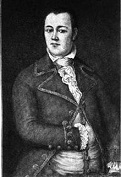
On Feb. 14, 1764 (Valentine's Day) the river town of St. Louis (modern-day pop. 311K/2.9M) on the W bank of the Mississippi River in modern-day Mo. on the border with modern-day Ill. 18 mi. downstream from the confluence of the Missouri River is founded by French fur traders Pierre Laclede (Laclède) (1729-78) and his stepson (common law wife's son) Rene (René) Auguste Chouteau Jr. (1749-1829), and named after French king Louis IX; in 1803 it becomes U.S. territory; it is incorporated in 1822, becoming the 4th largest U.S. city by 1870.
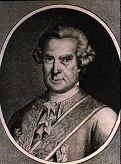


On Jan. 10, 1769 after getting concerned about Russian incursions along the Pacific coast from their base in Alaska, Spanish minister Jose de Galvez (José de Gálvez) y Gallardo, Marqués de Sonora (1720-87) sends the dual land-sea Portola (Portolá ) Expedition, led by Gaspar de Portola (Portolà) i Rovira (1716-86) to explore and settle Alta Calif. with a system of presidios (military forts) and Franciscan missions, starting with the San Carlos sailing from La Paz, followed on Feb. 15 by the San Antonio sailing from Cabo San Lucas, while the land epedition leaves Velicata on Mar. 25; on July 16 Franciscan Father Miguel Jose "Junipero" Serra y Ferrer (1713-84) ("Apostle of Calif.") founds the first of 21 Catholic missions in Calif. at Mission San Diego de Alcala (Alcalá), becoming the start of El Camino Real (the Royal Road), which becomes an Indian Roman Catholic conversion factory as well as an agricultural estate; the super climate produces early crops of grapes, oranges and olives; over the next 50 years the Franciscans build 20 more missions spaced a day's journey apart along the coast all the way to San Francisco.
On Aug. 5, 1775 Spanish Lt. Juan Manuel de Ayala (1745-97) (who left Monterey on July 26) becomes the first Euro explorer to sail through the Golden Gate of San Francisco Bay in Calif., naming three islands incl. Alcatraz (Sp. "pelican") Island and anchoring his packet ship Punta de San Carlos (which he takes command of by luck after captain Don Miguel Manrique goes mad?) at Angel Island (Isla de Los Angeles) to wait for the overland expedition of Capt. Juan Bautista de Anza, then on Sept. 18 returns to San Blas via Monterey, telling them how the harbor beats Monterey for having less fog, and how friendly the natives are.
In 1775 after being sent by Antonio Maria Bucareli y Ursua, viceroy of New Spain to explore N Calif. to see if there are Russian settlements, Spanish explorer Bruno de Heceta (Hezeta) y Dudagoitia (1743-1807) discovers the Columbia River in W N. Am.; New England ship captain Robert Gray names it in 1792.
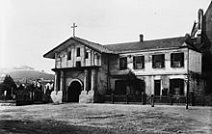
In Mar. 1776 Spanish Capt. Juan Bautista de Anza Bezerra Nieto (1736-88), Lt. Jose Joaquin de la Santisima Trinidad Moraga (1741-85), and Franciscan priest Friar Pedro Font (1737-81) arrive at the tip of San Francisco, and De Anza plants a cross at what is now Ft. Point, becoming the start of the city of San Francisco, Calif. (named after St. Francis of Assisi) (modern pop. 3M/750K). Meanwhile, on the other side of the North American continent? On June 17 Lt. Jose Joaquin Moraga leads a band of colonists from Monterey Presidio 125 mi. NW to San Francisco, and on Sept. 17 they found the Presidio of Yerba Buena (Sp. "good herb") (later the Presidio of San Francisco); on Oct. 9 a group of Spanish Franciscan missionaries arrives led by Father Junipero Serra's companion Father Francisco Palou (1722-90) and founds Mission San Francisco de Asis (Dolores) (#6 of 21).
On Sept. 4, 1781 Spanish gov. of Calif. (1777-82) Felipe de Neve (1724-84) along with the Franciscans found El Pueblo de la Reina de Los Angeles (Town of the Queen of the Angels) (modern-day pop. 3.8M/18.6M) from an Indian village named Yangma; 29 of the first 44 Spanish settlers (Los Pobladores) are of African ancestry.
The Great American White-Is-Right Dream begins with the Father of the Country? On Mar. 26, 1790 Pres. Washington signs the U.S. Naturalization Act of 1790, barring anyone not a "free white person" from becoming a U.S. citizen; when Puerto Rico's citizens are allowed to become U.S. citizens in 1917, the govt. looks the other way and classifies them all as white.
On Aug. 1, 1790 the First (1st) U.S. Census, run by U.S. secy. of state Thomas Jefferson reports the total pop. as 3,929,214, in a land area of 864,746 sq. mi., for a pop. density of 4.5 per sq. mi.; that's 3,277,000 white inhabitants (80.7%), 698K slaves, and 59K freed slaves; a total of 410,636 families, of which 47,664 own slaves; 40K are Irish-born, and 160K are of Irish descent; the pop. of New York City (which had been nearly deserted in 1776) is back up to a whopping 33K; Penn. is the most populous state with 434,373 pop.; the U.S. Jewish pop. is about 2K, mainly Sephardim, although Ashkenazim from C and E Europe are beginning to arrive; Mass. is the only state to record no slaves; only 5% of the pop. lives in cities; by 2000 the pop. of Puerto Rico alone is 3.9M. The U.S. dollar this year has the same purchasing power as $19.26 in the year 2002; the English pound has the same purchasing power as 70 pounds in 2002; a fine ounce of gold costs $19.50 or £4.25; the exchange rate is English £1 for U.S. $4.55 or 23.5 French livres.
In 1791 Misson Santa Cruz is founded on the N edge of Monterey Bay in Calif. 75 mi. S of modern-day San Francisco by missionary priest Juan Crespi; in 1797 Villa de Branciforte is founded by the Spanish colonial govt. of Alta Calif. on the E bluff of the San Lorenzo River facing the mission on the other side; in 1866 the city of Santa Cruz, Calif. (modern-day pop. 64K/262K) is incorporated, and chartered in Apr. 1876; in 1905 Branciforte is annexed; in the 20th cent. it calls itself "Surf City", becoming a center of progressive liberal activism.


Might as well face it you're addicted to land? On Apr. 30, 1803 (Sat.) after the English refuse it, the 100M acre (828K sq. mi.) (2.14M sq. km.), 68M francs ($15M) Louisiana Purchase, negotiated for U.S. Pres. Thomas Jefferson by U.S. minister to France Robert R. Livingston, and surveyed by British-born Am. geologist George William Featherstonhaugh (1780-1866) is signed, reaching Washington, D.C. on July 4, doubling the size of the U.S. for less than 3 cents/acre by adding the La. Territory that stretches from the Gulf of Mexico in the S to Rupert's Land in the N, and from the Mississippi River in the E to the crest of the Rocky Mts. in the W, and prepares it for further expansion to the Pacific; it incl. the future states of Ark., Mo., Iowa, Okla., Kan., Neb., most of N.D. and S.D., Minn. W of the Mississippi River, NE N.M., N.Tex., Mont., Wyo., Colo. E of the Continental Divide, La. W of the Mississippi River (incl. New Orleans), and small portions of Alberta and Saskatchewan in Canada; on Oct. 20 the U.S. Senate ratifies it, and on Dec. 20 ownership of the territory is formally transferred from France to the U.S. in ceremonies held in Jackson Square in New Orleans (originally Plaza d'Armas); the largest state to be purchased (4th largest of the 50 states) is Montana; French privateer Jean Lafitte (1776-1854) (d. 1823?) establishes his own Kingdom of Baritaria in the swamps and bayous around New Orleans, claiming to command 3K men; too bad, aborigines aren't told they have to register ownership of their lands, allowing the federal govt. to claim them, incl. the La. Bayou, where oil cos. later make billions.



The Lewis and Clark Expedition, or, The Original Mild-Mannered Forensic Anthropologist, or, White Devils Visit the Unsuspecting Indians? On May 14, 1804 Virginians Capt. Meriwether Lewis (1774-1809) (the ugly one) and 2nd Lt. William Clark (1770-1838) (the handsome one), leading the 45-man Lewis and Clark (Corps of Discovery) Expedition (ends Sept. 1806) (named by carpenter Louis Glass) ($2.5K in expense money allotted by Congress) push their three boats carrying 30 tons of supplies into the Missouri River from Camp Wood near St. Louis, say goodbye to the cheering French village of St. Charles, and set out to explore the Am. West, looking for a water route to the Pacific; Clark is accompanied by his black slave York (1770-1831), and Lewis by his 150-lb. Newfoundland dog Seaman (purchased for $20 in Pittsburgh, Penn.); on July 7 they leave St. Joseph, Mo. along the Missouri River; when one of their boats proves too big to cross a certain point in the river, they send it back with 7 men; in Nov. after portaging the Great Falls, they stop and spend the winter in North Dakota at the Hidatsa-Mandan village winter camp (who are friendly even though suffering from white man's smallpox?) on the banks of the frozen Missouri River; they hire Hidatsa (Lemhi Shohone?) Indian interpreters Sacagawea (Sacajawea) (Sakakawea) (1788-1812) (pr. suh-KAH-guh/juh-WEE-uh) (Hidatsa "bird woman") (Shoshone "boat launcher or puller") and her fur trader husband Toussaint Charbonneau (1717-1843); her child Pompy (Jean Baptiste) goes along; they name the Nez Pierce ("pierced nose") Indians from you know what; the Arikaras try to bring bear spirits to life from clay models and call on the grizzlies to stop the white devils from destroying their way of life?
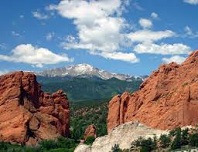


In 1805 N.J.-born Lt. Zebulon Montgomery Pike (1779-1813) explores Minnesota, and negotiates a treaty with the Sioux (Dakota) ceding 100K acres, incl. most of Mineapolis and St. Paul at the confluence of the Minnesota and Mississippi Rivers; on July 15, 1806 he leaves St. Louis to explore New Mexico looking for the sources of the Arkansas River; on Nov. 15 he sights 14,109 ft. (4,267m) pink granite Pikes Peak (El Capitan to the Spanish, which he calls Highest Peak because it's higher thany any peak in the U.S. to the E) in S Colo. (64 mi. S of Denver), but fails in an attempt to climb it, declaring that it will never be climbed (the Utes probably did it all the time to get eagle feathers?), then makes a roundabout return by way of Santa Fe after Spanish soldiers capture his party; his accounts are pub. before those of Lewis and Clark, creating the myth that the Am. West is a "Great American Desert" unfit for human habitation (and hence the place to banish Indian tribes to); in summer 1820 Vt.-born botanist Edwin P. James (1797-1861) becomes the first to climb it while working for explorer Stephen Harriman Long (1784-1864) on his expedition "from the Mississippi to the Rocky Mountains", discovering the health benefits of the mineral waters in Manitou Springs, Colo., and making the first ascent of 13,3K ft. (4,054m) James Peak.
On Mar. 23, 1806 explorers Lewis and Clark begin their return journey. In Sept. 1806 the Lewis and Clark Expedition (begun May 1804) ends after going 8K mi. and visiting 58 Indian tribes; Clark frees his slave York, who was allowed to carry a gun and whose black skin was a curiosity to every Indian tribe they met (the first black to cross the North Am. continent N of Mexico?); Sgt. Charles Floyd, the only casualty in the party dies of a burst appendix near Sioux City; Pres. Jefferson is presented with two bears, which he houses in cages in the White House; always thinking, Pres. Jefferson envisions an independent nation in NW North Am. called the Repub. of the Pacific, which survives to modern times as a proposal for the Repub. of Cascadia, consisting of British Columbia, Ore. and Wash., plus maybe parts of Idaho, N Calif., the Yukon and Alaska; in 1941-2 the State of Jefferson exists for about 10 mo. until Pearl Harbor kills it.

In 1810 the Pacific Fur Co. of America's first millionaire John Jacob Astor (1763-1848) finances the Astor Expedition (ends 1812) overland to the W from St. Louis, founding Ft. Astoria next Apr. on the Columbia River as a fur trading post, becoming the first white settlement in Ore.; in Nov. 1812 expedition member Robert Stuart discovers the 20-mi.-wide South Pass through the Rocky Mountains, becoming the basis of the Oregon Trail; too bad, the British capture Astor's trading posts during the War of 1812, renaming Ft. Astoria to Ft. George and shutting his fur biz down.
In 1811 the port city of Astoria, Ore. near the Columbia River (modern-day pop. 9.5K) is founded by the Am. Fur Co. of John Jacob Astor as Ft. Astoria, becoming the first permanent U.S. settlement on the Pacific coast, and first to have a U.S. post office W of the Rocky Mts.

On June 6, 1820 an expedition led by Maj. Stephen Harriman Long (1784-1864) goes W from the Missouri River into Neb., and along the Platte River, sighting 14,259-ft. Longs (not Long's) Peak near Estes Park, Colo. (northernmost of the 54 "fourteeners" in the Colo. Rocky Mts.) on June 13; when he returns, Long reports that the entire area between the Missouri River and the Rocky Mts. is unsuitable for farming, despite seeing fields of corn, beans, and pumpkin being cultivated by Pawnees, causing the Great Plains to become known as the "Great American Desert" for the next 50 years; by the 20th cent. it contains the largest irrigated area on Earth.

In Sept. 1821 Mo. trader William Becknell (1787-1856) leads a party up the Arkansas River on a horse-trading expedition, stumbles onto Mexican soldiers, and is told that they are welcome in Santa Fe to trade for gold, silver and furs, opening the Santa Fe Trail, a 780-mi. overland route between Independence, Mo. and Santa Fe, N.M. which takes 100-200 white merchants round-trip once a year until supplanted by a monthly stage in 1850 and the Santa Fe Railroad in 1880; on the first journey Becknell discovers Hispanic ladies smoking "seegaritos".
In 1822 St. Louis, Mo. on the Mississippi River is incorporated (modern-day pop. 311K/2.9M); river steamboats begin navigating the upper Mississippi River.
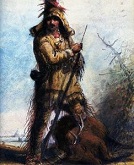
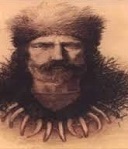
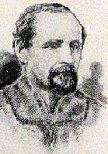



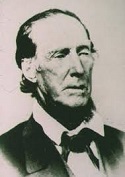
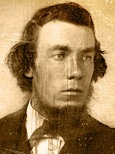
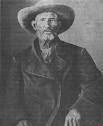
In 1822 after forming the Rocky Mt. Fur Co. with U.S. Army Maj. Andrew Henry (1775-1832), Mo. Militia Brig. Gen. William Henry Ashley (1778-1838) places an ad in the newspapers of St. Louis (W frontier of the U.S.) calling for "a company of young men, skilled with horses and firearms, to spend two to three years trapping beaver on the headwater of the Missouri River", which is still gringo-free, causing gung-ho Hugh Glass (1780-1833), Etienne Provost (1785-1850), David Edward Jackson (1788-1837), James Pierson "Jim" Beckwourth (1798-1867), Jedediah Strong Smith (1799-1831), William Lewis "Bill" Sublette (1799-1845), Milton Green Sublette (1801-37), William Lewis "Bill" Sublette (1799-1845), Thomas "Broken Hand" Fitzpatrick (1799-1854), Robert Campbell (1804-79), James Felix "Jim" Bridger (1804-81) et al. to sign up, becoming known as Ashley's Hundred, creating a generation of "mountain men" who like to chase wild beaver; the new co. sends three keelboats up the Missouri River three different times; Henry leads an expedition of 21 men, 60 horses, and one keelboat to the mouth of the Yellowstone River, building Ft. Henry; too bad, the next boat under the command of Daniel Moore sinks with $10K worth of provisions; Ashley pilots the 3rd boat, and is able to get through to Ft. Henry; in the winter of 1825-6 they bury a cache of 75 bales of furs worth $150K in Cache Valley (near modern-day Hirum in N Utah), after which the site is used many times; by 1840 the country's beavers have been trapped out, and are saved from extinction only by a fashion change from beaver to silk for men's dress hats.

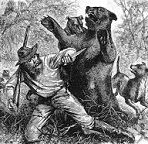
On June 2, 1823 (early a.m.) Ashley's Hundred is attacked by Arikara warriors, retreating downstream on the Missouri River and sending for help, reaching Ft. Kiowa before setting out overland to the Yellowstone River, reaching the forks of the Grand River in modern-day Perkins County, S.D. 200 mi. away, where Scranton, Penn.-born mountain man Hugh Glass (1783-1833) surprises a grizzly bear with two cubs, who badly mauls him before being killed, causing his party to carry him on a litter for two days, after which John S. Fitzgerald and "Bridges" (Jim Bridger?) volunteer to stay with him until he dies, only to abandon him after stealing his equipment, leaving him to crawl back wearing a bear hide to the Cheyenne River, where he makes a crude raft and floats downstream the rest of the way to Ft. Kiowa, taking a total of six weeks, pardoning the bozos; in early spring 1833 he is killed on the Yellowstone River by the Arikara; filmed in 2015 by Alejandro Inarritu as "The Revenant" starring Leonardo DiCaprio.
In 1823 the Texas Ranger Div. (Texas Rangers) is founded by Stephen F. Austin; in 2015 they have 162 commissioned members - upgrade to the healthier side of whitening?
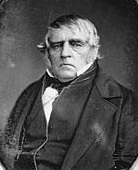
In 1824 Canadian fur trader Peter Skene Ogden (1790-1854) begins exploring the Snake River Valley (until 1830) incl. Ore., Wash., Nev., Calif., Utah, Idaho, and Wyo., incl. the Great Salt Lake, Weber River, and Ogden River; the city of Ogden, Utah is later named for him.
In 1824 Ky. frontiersmen Sylvester Pattie (1782-1828) and his son James Ohio Pattie (1804-51) lead 116 men through the Am. Southwest for six years, suffering from hardships that whittle them down to 16 men by 1827, finally reaching San Diego, Calif., only to be arrested as spies by the Mexican authorities; after Sylvester dies, James is released after producing some smallpox vaccine and vaccinating the pop., then returns to the U.S. in 1830 flat broke; in 1831 he and Timothy Flint pub. The Personal Narrative of James O. Pattie of Kentucky.
In 1825 the U.S. House Committee on Territories is established (until 1946) to decide how best to assimilate the pesky Five Civilized Tribes into the Union by distributing common property to individials; in 1871 it decides that "no Indian nation of tribe within the territory of the United States shall be acknowledged or recognized as an independent nation", dispensing with the need for formal treaties.

In 1827 Tioga County, N.Y.-born frontiersman Jedediah Strong Smith (1799-1831) becomes the first white man to cross the Great Basin incl. the Bonneville Salt Flats in NW Utah, becoming the first to make the overland round-trip to Calif.; he explores the Great Salt Lake and names it after himself, but it doesn't stick.
In summer 1828 the Sweet Lake (Bear Lake) Rendezvous on the Idaho-Utah border is attended by mountain men Philip Covington, Hugh Glass, Jim Bridger, Jim Beckwourth, Jedediah Smith, Ezekiel Abels, Black Harris, Joshua Pilcher; on Aug. 15 a party of 45-50 men on 80-90 mules depart for St. Louis, Mo. with $36M in furs incl. 7,710 lbs. of beaver pelts, arriving on Oct. 13 and making a profit of $16M.
In summer 1830 the first great Rendezvous for mountain men fur traders is held in the summer in Riverton, Wyo. at the confluence of the Big and Little Wind Rivers; in summer 1832 the Rendezvous at Pierre's Hole is held at the W foot of the Teton Mts. in Teton County, Idaho.

In 1831 French-born Am. explorer U.S. Army Capt. Benjamin Bonneville (1796-1878) of the U.S. Army heads an expedition guided by Jim Bridger (ends 1836) to explore the Intermountain West between the Rocky Mts. and Calif., and finds them not all flat; Bonneville Salt Flats are later named after him by geologist Grove Karl Gilbert.

On May 21, 1832 after 17 years in Europe, New York City-born writer Washington Irving (1783-1859) returns to New York City, and in the summer he goes on a surveying mission deep into Indian Territory (modern-day Okla.) with U.S. commissioner on Indian affairs Henry Leavitt Ellsworth, Charles La Trobe, and Count Albert-Alexandre de Pourtales, returning to pub. the bestseller A Tour on the Prairies, containing the first pub. description of the area around Stillwater, Okla., "a glorious prairie spreading out beneath the golden beams of an autumnal sun. The deep and frequent traces of buffalo, showed it to be a one of their favorite grazing grounds."
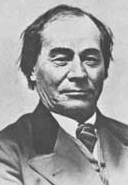
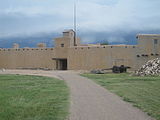
In 1833 180' x 135' x 15' adobe brick Bent's Fort (begun 1828) is built in Otero County, SE Colo. along the Santa Fe Trail by St. Louis, Mo.-born William Wells Bent (1809-69) and Ceran de Hault de Lassus de St. Vrain (1802-70) to trade with Southern Cheyenne and Arapaho Plains Indians and trappers for buffalo robes, becoming the only privately-owned fort in the Am. West, and the only major permanent white settlement on the Santa Fe Trail between Missouri and the Mexican settlements, becoming a major trading center and rendezvous point for fur trappers; it is abandoned in 1849 during a cholera epidemic among Plains Indians, and burned in 1852 by Bent, who builds a new stone fort in Big Timbers near modern-day Lamar, Colo., which in 1860 becomes Ft. Wise, renamed Fort Lyon in 1862, and replaced in 1867 by a new Fort Lyon near modern-day Las Animas, Colo.; Bent's Old Fort is designated a nat. historic site on June 3, 1960, and reconstructed in 1976.

On Aug. 14, 1834 Richard Henry Dana Jr. (1815-82) sails on the brig Pilgrim to Calif., returning in Sept. 1836 on the Alert after witnessing a flogging aboard the Pilgrim that pisses him off, later writing the classic Two Years Before the Mast (1840).

In 1834 Roane County, Tenn.-born trapper Joseph Reddeford "Joe" Walker (1798-1876) et al., who set out in 1832 with Benjamin Bonneville on a trapping expedition in the Am. West, killed a bunch of helpless Digger Indians, visited Yosemite and became the first Euros to see the waterfalls, followed by the redwood forests, then holed up in Monterey, Calif. from Nov. 1833-Jan. 13, 1834 discovers 5,250 ft. alt. Walker Pass in the S Sierra Nevada Mts. at the S end of the San Joaquin Valley, which later becomes a major gringo gateway into Calif. during the Calif. Gold Rush.

On Aug. 26, 1836 the town of Houston, Tex. (named after Sam Houston) (modern-day pop. 2.1M/6.3M) is founded on Buffalo Bayou (modern-day Allen's Landing) by Canaseraga Village (modern-day Sullivan), N.Y.-born brothers Augustus Chapman Allen (1806-64) and John Kirby Allen (1810-38) after purchasing 6,642 acres from John Austin's widow Elizabeth E. Parrott for $5K; it becomes the capital of the Repub. of Texas on Nov. 30, and is incorporated next June 5.

In 1837 after Mexico places a bounty on Apache scalps in 1835, Juan Jose Compa, leader of the Coppermine Mimbreno Apaches is killed in the Massacre at Santa Rita del Cobre, causing 6'6" Mangas Coloradas (1793-1863) to step up as new chief, joining with Cuchillo Negro (Sp. "black knife") (Baishan) (1796-1857), chief of the Warm Springs Mimbrenos to siege Santa Rita and slaughter the Mexicans as they flee - you can ring my bell, ring my bell?
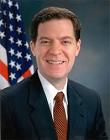
On May 23, 1838 despite protests by outraged U.S. citizens to Congress, the 16K-person Cherokee Nation of the Five Civilized Tribes is forcibly removed from their homeland in the Appalachians by U.S. troops under Gen. Winfield Scott along the bad news Trail of Tears to Okla., and 3K die along the way; women and children are seized first to force the men out of hiding; many are evacuated suddenly from their homes sans warm clothing, leading to deaths from pneumonia; the Yankees dig up family graves looking for silver jewelry; the wagon trains stop each day for roadside burials; they are interned in Fort Payne in Ala. before relocation to Okla.; a few Cherokees (the eastern band) hold out in the mountains and eventually acquire title to federal lands in N.C.; on Dec. 19, 2009 Pres. Obama signs the Brownback Native Am. Apology Resolution apologizing to the Cherokees and all Native Am. tribes for past wrongs, sponsored by U.S. Sen. (R-Kan.) (1996-2011) Samuel Dale "Sam" Brownback (1956-).

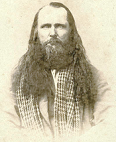
On Oct. 27, 1838 Mo. gov. #6 (1836-40) Lilburn Williams Boggs (1796-1860) issues Executive Order #44 AKA the Extermination Order, calling for the violent expulsion of the Mormons from Mo.; On May 6, 1842 (eve.) after moving to a house in the City of Zion plot in Independence, Mo. three blocks E of Temple Lot, Mormon archenemy Boggs is shot through a window as he reads a newspaper in his study, almost killing him; after a revolver is discovered at the scene, Hampshire County, Mass.-born Mormon Danite Orrin Porter "Old Port" Rockwell (1813-78), bodyguard and close associate of Joseph Smith Jr. known as "the Destroying Angel of Mormondom" is arrested, then tried and acquitted in 1843 after spending 8 mo. in jail, moving to Nauvoo, Ill., where Smith prophesies that as long as he doesn't cut his hair "no bullet or blade can harm thee" a la Samson. At his funeral in Salt Lake City, LDS Church pres. Joseph F. Smith utters the soundbyte: "They say he was a murderer; if he was he was the friend of Joseph Smith and Brigham Young, and he was faithful to them, and to his covenants, and he has gone to Heaven and apostates can go to Hell... Porter Rockwell was yesterday afternoon ushered into Heaven clothed with immortality and eternal life, and crowned with all glory which belongs to a departed saint. He has his little faults but Porter's life on Earth, taken altogether, was one worthy of example, and reflected honor upon the church. Through all his trials he had never once forgotten his obligations to his brethren and his God"; his legend goes on to inspire Wild Bill Hickock and Buffalo Bill.
I fooled around and fell in love, yes I did? In 1840 mass slaughter of the 36M buffalo (bison) in the U.S. begins at the rate of 1M-2M a year under a U.S. govt. policy to "settle the vexed Indian question"; by 1875 only 5.5M remain, down to 541 in 1889 and 300 in 1900; in 1875 Gen. Philip Sheridan tells the Tex. legislature that whites should "kill, skin and sell until the buffaloes are exterminated. Then your prairie can be covered with speckled cattle and the festive cowboy - the forerunner of an advanced civilization."

In 1840 Swiss immigrant John Augustus Sutter Sr. (Johann August Suter) (1803-80), who arrived via Oregon, Hawaii, and Alaska in Calif.'s remote Central Valley on Aug. 13, 1839, and persuaded the Mexican govt. to give him a 48K-acre land grant on the American River near its junction with the Sacramento River (modern-day Sacramento) erects a fort called New Helvetia (Sutter's Fort) with 18-ft.-high walls, living like a feudal baron while entertaining illegal gringo immigrants arriving over the California Trail through the Sierras, stretching his credit to buy 2K fruit trees in 1847, founding the Sacramento Valley agriculture industry, and hiring James Marshall to build a sawmill.

In Nov. 1841 the city of Dallas, Tex. (Gael. "dwellers by the waterfall") (modern-day pop. 5.1M/7.7M) in NE Tex. on 640 acres overlooking the Three Forks area of the Trinity River is settled by Tenn. trader-atty. John Neely Bryan (1810-77); the site is where JFK is assassinated on Nov. 22, 1963; in 1846 after attracting Anglo-Am. (non-Hispanic) settlers, it and the surrounding county are named after Philly-born Anglo U.S. vice-pres. #11 (1845-9) George Mifflin Dallas (1792-1864) - shouldn't that be Houston-Mufflin?


In 1841 the U.S. Preemption Act legalizes squatting on lands in the Am. West, and the Great Migration begins, the first wave of wagons crossing the Missouri River headed for Calif. and Oregon along the I-can't-help-myself Oregon Trail, led by missionary Marcus Whitman (1802-47) from Ft. Hall in E Idaho; Oregon City, Ore. is founded, becoming the first white town in Ore. (incorporated 1849); Am. Shoshone chief Washakie (1798-1900) of Utah and Wyo. aids settlers moving W, being more friendly to whites than his enemies the Sioux.

In May 1842 after Bent's Fort misses a shipment of hides wanted by the East, causing them to see their chance, Pueblo, Colo. on the N bank of the Arkansas River at its confluence with Fountain Creek in S Colo. on the border of the Louisiana Purchase is founded as Ft. Pueblo (El Pueblo) by Bent's Fort trader George Simpson et al., who build a log fort to protect against hostile Utes, attracting Va.-born part-black mountain man James P. "Jim" Beckwourth (1798-1867), Kit Carson et al., and reaching 100 pop., encouraging farming and ranching; in winter 1846 a party of several hundred Mormons from Miss. arrive, and are joined by a group of sick members of the Mormon Battalion incl. women and children, who all leave for the Salt Lake Valley next July; too bad, the 1848 Mexican-Am. War and the 1849 Calif. Gold Rush deplete it, and by 1854 only 15-20 live there.



On Aug. 13-15, 1842 13,745 ft. (4,189m) Fremont Peak in Wyo. is first climbed by Am. explorer John Charles Fremont (1813-90) (son-in-law of Mo. U.S. Sen. Thomas Hart Benton) on the first of four expeditions of the Am. West., guided by Christopher Houston "Kit" Carson (1809-68), going on to pub. A Report on an Exploration of the Country Lying between the Missouri River and the Rocky Mountains on the Line of the Kansas and Great Platte Rivers, which was printed by newspapers across the U.S., making him a celeb, with the nickname "The Pathfinder", describing the 700-mi. Old Spanish Trail from Santa Fe to Los Angeles, parts of which go back to the 16th cent., which has been extensively used by pack trains since 1830 (until the mid-1850s); Carson goes on to become the most famous Am. frontiersman after Daniel Boone. In summer 1843 John Charles Fremont (1813-90) goes on his 2nd expedition, crossing the Rocky Mts. N of the Great Salt Lake, and down the Snake River and Columbia River to Oregon, then W to Lake Tahoe, and down the E slopes of the Sierra Nevadas through Carson Pass into the Central Valley of Calif. to scope it out for gringos waiting for da news back east, then down the American River Valley to Sutter's Fort in Sacramento, then S along the E edge of the San Joaquin Valley, then E through Tehachapi Pass to modern-day Las Vegas, Nev., then N through Utah to South Pass, proving that the Great Basis doesn't have any river flowing towards the sea, disproving the legend of a Buenaventura River; in 1845 Fremont pub. a new map, which is pub. by Congress and used by thousands of immgrants to Ore. and Calif. in 1845-9 incl. the Calif. Gold Rush, inspiring the Mormons to settle in Utah. On June 1, 1845 John C. Fremont and his 55 men leave St. Louis searching for the source of the Arkansas River, and when they don't find it, they hastily travel to the Sacramento Valley in Calif. next Jan., trying to stur up a war; in Sonoma after hearing of the U.S.-Mexican War a group of gringo Americans capture Mexican Gen. Mariano Guadalupe Vallejo (1807-90) on June 14 and declare the independent Calif. Repub., making up a flag with a Calif. grizzly and star painted on white cloth; the Bear Flag Revolt begins; by late June Fremont endorses the new repub. and sets out for Monterey, but before he arrives the revolt ends as the commodore of the U.S. Pacific Fleet sends a shore party to raise the Stars and Stripes and proclaim Calif. as part of the U.S.; in July Robert F. Stockton becomes the new commodore and prepares to invade S Calif., enlisting Fremont's band as the Calif. Battalion and promoting him to maj.; the Mexican loyalists flee, and on Aug. 17 Stockton declares himself gov. of Calif., with Fremont as military cmdr. in the N.


In 1843 the city of St. Joseph, Mo. (AKA St. Joe) on the Missouri River in NW Mo. (modern-day pop. 76K) is founded and incorporated by French trapper Joseph Robidoux III (1783-1868), becoming the starting point of the Pony Express and death place of outlaw Jesse James; Robidoux goes on to build Robidoux Row, the first apt. bldg. W of the Mississippi River.
In 1844 the city of Portland, Ore. (originally the Clearing, Stumptown) (modern-day pop. 584K/3.1M) at the confluence of the Willamette and Columbia Rivers at the end of the Oregon Trail is founded; the name is decided on a coin toss, with loser Asa Lovejoy of Boston, Mass. wanting Boston, and winner Francis W. Pettygrove of Portland, Maine wanting Portland; it is incorporated on Feb. 8, 1851.

In July 1845 the eastern newspaper United States Mag. and Democratic Review first mentions the term "Manifest Destiny" as a rationale for annexation of Texas by the Polk admin. in an article by editor John Louis O'Sullivan (1813-95): "The American claim is by right of our manifest destiny to overspread and to possess the whole of the continent which Providence has given us for the development of the great experiment of liberty an

In Nov. 1846 after setting out for Calif. in May, the Donner Party, one of the first western migrations to incl. women and children becomes the dinner party when it gets snowed-in in the Sierra Nevada Mts. (Tahoe Nat. Forest SW of Reno, Nev. and W of Truckee, Calif.) during the winter, and dabbles with cannibalism at Donner Lake, until 40 survivors of the original 81 are rescued by Sutter's men next year; on Jan. 12, 2006 U. of Ore. scientists report that 21 of them, incl. all the members of the George and Jacob Donner families were stuck 6 mi. away at Alder Creek because of a broken axle, and didn't resort to cannibalism, although they did eat pet dog Uno; their wagon wheel tracks on the Bonneville Salt Flats in NW Utah survive to modern times.

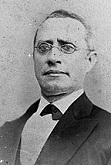
Eureka, greedy gringos go for the gold in somebody else's territory, haha, their territory? On Jan. 24, 1848 (Wed.) a gold nugget is discovered by Sutter's partner James Wilson Marshall (1810-85) in the tailrace of Sutter's Mill (Sawmill) in Coloma on the Trinity River in the foothills of the Sierras in N Calif. 50 mi. NE of Sutter's Fort on the South Fork of the American River, launching the Calif. Gold Rush (ends 1855) (300K rush in, 100K+ stay, 28.4M troy oz. of gold at $18.89 an oz. worth $536M by 1859) after a publicity stunt is staged by Sutter's Fort store owner Samuel Brannan (1819-89), a Mormon elder hoping to make a fortune outfitting gold seekers in San Francisco, causing most of the town's 800 residents to head for the gold fields within a few days; Brannan becomes the first millionaire of the gold rush; on Aug. 19 the New York Herald reports the discovery, turning on the 500K pop. crowded in too small a space and plagued by horse manure, wild dogs and pigs, and drunks from cheap whiskey; several lucky early miners make sizeable fortunes fast and easy, the news feeding "gold fever"; in Aug. Sutter's son John Augustus Sutter Jr. (1826-97) arrives to help save the claim from squatters and thieves, in vain, causing Sutter Jr. to begin laying out the city of Sacramento, Calif. 2 mi. S of New Helvetia on the Sacramento River (modern-day pop. 490K/2.4M), incorporating on Feb. 27, 1850 (oldest incorporated city in Calif.), which becomes an overnight success, causing the father to grow bitter at the son; it is chartered as a city in 1920; on Dec. 5 Pres. Polk confirms the discovery in his Fourth Annual Message, complete with an oyster tin full of gold, starting a nationwide and later a worldwide stampede known as the Forty-Niners, ruining Sutter's land grant with claim jumping, while gold fever is further pumped up by newspaper stories about gold nuggets lining the streets and gold dust so easy to harvest that one could coat oneself with sticky stuff and roll down a hill to collect it; others see the easy riches as proof that the Am. West is God's promised land for whites, and that the U.S. was meant to have Calif. not Indians and beaners; the mining puts mercury in San Francisco Bay, which ends up in fish.
On Feb. 2, 1848 the first Chinese immigrants to the former Spanish mission (founded June 29, 1776) of San Francisco in Calif. (modern-day pop. 870K/8.7M) arrive in the Eagle one week after the Calif. Gold Rush starts, adding to the seven already there; the city's pop. grows from 1K in 1848 to 25K in Dec. 1849; the city is incorporated on Apr. 15, 1850.


The original sex, drugs and rock & roll in San Francisco? On Feb. 28, 1849 the California Gold Rush begins as the ship SS California arrives in San Francisco Bay, Calif. carrying the first boatload of 365 (called the Argonauts) of 80K white gold-seeking Forty-Niners gold prospectors; Stephen Foster sells the rights to "Oh! Susanna" for $100 to be their theme song?; "I have seen purer liquors, better seegers, finer tobacco, truer guns and pistols, larger dirks and bowie knives, and prettier courtesans here in San Francisco than in any place I have ever visited, and it is my unbiased opinion that California can and does furnish the best bad things that are obtainable in America" - anon.; Pretty Juanita becomes the first person hung in the mining camps; U.S. mint official Matthew F. Stephenson stands on the courthouse steps in Dahlonega, Ga. haranguing miners to stay and mine Georgia gold rather than leave for California, pointing to a nearby peak, and exclaiming, "There's millions in it!"; Mark Twain paraphrases him, writing the immortal line, "There's gold in them thar hills!"; aptly-named Ah Toy (1828-1928) becomes the 2nd Chinese woman to arrive in San Francisco, setting up a brothel in an alley off Clay St., where the fact that she's tall and has lily-bound feet causes block-long lines of horny white men after each ship docks; a man later sends a letter from Hong Kong claiming that she's his wife and requesting her return, but she goes to court and a judge grants her leave to stay; she then returns to court to complain of customers paying the 1 oz. fee with brass filings instead of gold, pointing out several in the audience as culprits, but the judge rules insufficient evidence when she can't explain what the services rendered are, giving the lame explanation "to gaze on the lovely Ah Toy"; within a year she imports five additional Chinese "soiled doves" and moves to a fancier house on Pike St. just off Clay St., then disappears in 1859; in 1926 an obituary in a San Fran newspaper says that she married a wealthy Chinese man and vended clams at Alviso; the San Francisco 49er Egg Rush sees 49ers brave the dangerous shark-infested waters around the Farallon Islands 28 mi. offshore to collect seabird eggs; meanwhile U.S. gen. Bennett C. Riley (1787-1853) (leader of the first military escort along the Santa Fe Trail in 1829) becomes the 7th and last military gov. of Calif. Territory prior to statehood - where he meets up with Zorro?
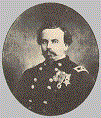
In summer 1849 S.C.-born former Texas Ranger John Joel Glanton (Gallantin) (1819-50) forms the Glanton Gang of scalp hunters to work for the Mexican govt. killing Apaches along the U.S.-Mexican border, going too far and killing peaceful Indians and Mexican citizens, causing the state of Chihuahua to put a bounty on their heads in Dec., driving them through Sonora to Ariz; 7-ft. hairless Judge Holden is 2nd in command; meanwhile the Apache Wars (end 1886) begin with the White Massacre on Oct. 18, which sees a band of Utes and Jicarilla Apaches ambush the family of merchant James White, killing him and kidnapping his wife Ann White, who is killed during a U.S. Army rescue attempt a couple of weeks later, leading to the Jicarilla War (ends 1855); Glanton is finally killed on Apr. 23, 1850 by a band of Quechans led by Caballo en Pelo after his men destroy their ferry on the Colorado River; N.H.-born former gang member Samuel Emery Chamberlain (1829-1908) later writes My Confession: The Recollections of a Rogue after rising to brig. gen. in the U.S. Civil War as head of the Fifth Mass. African-Am. Cavalry; meanwhile in winter 1853/4 the U.S. Army enters the Jicarilla War.
On Dec. 25, 1849 a 100-wagon train traveling W from Salt Lake City headed for the Calif. gold fields enters a parched depression near the Calif.-Nevada border hoping for a shortcut, and after a stay at Furnace Creek they get stranded near Bennett's Well, sending William Manly and John Rogers for help; 2 weeks later they reach the San Fernando Valley 200 mi. to the SW, obtain supplies, and head back; after 25 days they return, finding all to have survived but one, and as they leave they issue the soundbyte "Goodbye, Death Valley", giving Death Valley its name; by next year small amounts of gold are discovered at Salt Spring, followed by silver, copper and lead.
Waffle and chicken restaurants right ahead? On Mar. 27, 1850 the officially WASP gringo Calif. cities of San Jose (Spanish mission founded Nov. 29, 1777) (modern-day pop. 1M/8.7M) and San Diego (Spanish mission founded July 16, 1769) (modern-day pop. 1.3M/3.3M) are incorporated, followed by Los Angeles (Apr. 4) (Spanish mission founded Sept. 4, 1781) (modern-day pop. 3.8M/18.7M), and San Francisco (Apr. 15) (Spanish mission founded June 29, 1776) (pop. 870K/8.7M).
On Jan. 9, 1851 Salt Lake City (originally Great Salt Lake City) (modern pop. 180K/560K) is incorporated; a territorial legislature is established on Apr. 5; the pop. of Utah is 11,354 - one Mormon cock to every how many dozen Moron pussies?

On Mar. 5, 1851 (early am.) ignoring a June 24, 1850 peace agreement, 400 Sonoran Mexican soldiers led by Col. Jose Maria Carrasco cross into Chihuahua and attack the Chiricahua Apache camp of medicine man Geronimo ("he who yawns") (1829-1909) outside Janos while the men are in town trading, killing 21 Apaches incl. chief Yrigollen, along with Geronimo's wife, children, and mother; chief Mangas Coloradas sends him to Cochise for help, and they declare war on the Mexicans; he goes on to have eight more wives, one after another, while leading a band of 38 men, women, and children against the Mexicans and later the U.S. Army until 1886 - looks like a giant through a dense fog?


On Sept. 14, 1851 the town of Seattle, Wash. on Puget Sound at the mouth of the Duwamish River is claimed by a large party of settlers led by Luther Collins; on Nov. 13 another party from Knox County, Ill. via Portland, Ore. led by Salem, Ind.-born Arthur Armstrong Denny (1822-99) land at Alki (Battery) (Roberts) (Me-Kwah-Mooks) Point (West Seattle), moving to the E shore of Elliott Bay at modern-day Pioneer Square and naming their settlement after Duwamish-Suquamish chief Seattle (Sealth) (Si'ahi) (1786-1866).


In 1851 Maine-born Bowdoin College grad John Babson Lane Soule (1815-91) coins the saying "Go West, young man!" in an article in the Terre Haute Express; in 1865 Horace Greeley (1811-72) adopts the line in the New-York Tribune, with the soundbyte "Go West, young man, and grow up with the country", and tries in vain to give proper credit to Soule, but later it is doubted that he deserves it.
In 1853 825K-acre King Ranch in the Wild Horse Desert in S Tex. between Corpus Christi and Brownsville near Kingsville is founded by New York City-born Irish-descent riverboat captain Richard King (1825-85), becoming the largest ranch in Tex.; it incl. four divs., the Santa Gertrudis (originator of the Santa Gertrudis breed, the first new U.S. breed), Laureles, Encino, and Norias; in 1961 it is designated a nat. historic landmark.
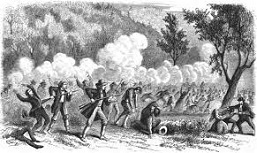

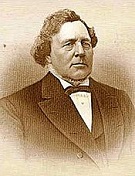
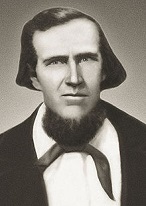
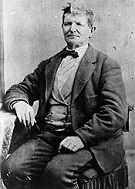
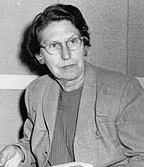
On Aug. 25, 1857 after leaving Salt Lake City to visit LDS communities in S Utah and warn them of approaching federal troops, telling them to "touch fire to their homes, and hide themselves in the mountains, and to defend their country to the very last extremity", whipping up fear and paranoia, LDS apostle (since Apr. 26, 1839) (Joseph Smith Jr.'s first cousin) George A. (Albert) Smith (1817-75), accompanied by several Native Am. chiefs and new Mormon missionary and pres. of the Santa Clara Indian Mission Jacob Hamblin (1819-86) (later becoming known as "Apostle to the Lamanites" and "the Buckskin Apostle" for his fair dealings with them) directs the Fancher-Baker party to Mountain Meadows N of Santa Clara on the Spanish Trail to find water and pasture, leading to their massacre, after which Hamblin tries to pin all the blame on John D. Lee. America's first 9/11 is cause not by Muslims, but Mormons? On Sept. 7-11, 1857 the Mountain Meadows Massacre sees the Baker-Fancher Party of 120+ Ark. settlers headed for Calif. incl. men, women, and children massacred in S Utah by the Mormon Utah Territorial Militia dressed as Paiutes; 17 children ages six and younger are spared; a Mormon coverup follows, stifling nat. publicity until 1872 when Mormon bishop Philip Klingensmith, a former private in the militia confesses, causing a scapegoat to be cut loose to beat the heat on the others, resulting in the 1874-6 trial of former Mormon militiaman John Doyle Lee (b. 1812), who is executed by firing squad on Mar. 23, 1877 at the site of the massacre after speaking his last words: "I do not believe everything that is now being taught and practiced by Brigham Young. I do not care who hears it. It is my last word... I have been sacrificed in a cowardly, dastardly manner", leaving Mormonism Unveiled; or, The Life and Confessions of the Late Mormon Bishop John D. Lee (Written by Himself) (1877); Cedar Springs, Mich.-born non-religious historian Charles Kelly (1889-1971) edits Lee's journals, claiming to smell a rat, posing for a photo in which he thumbs his nose at the Mormon memorial to the massacre; in 1950 Bunkerville, Nev.-born Mormon historian Juanita Pulsipher Brooks (nee Juanita Leone Leavitt) (1898-1989) pub. The Mountain Meadows Massacre, which proves that the Mormon militia did it, and that militiaman John D. Lee was a scapegoat, charging Brigham Young with running a coverup after provoking it with incendiary rhetoric, making him "an accessory after the fact"; the book is acclaimed by historians, keeping the LDS Church from taking disciplinary action against her, but members and officials shun her for breaking their code of silence; on June 30, 2011 U.S. interior secy. Ken Salazar designates the Meadow Mountains Massacre site as a nat. historic landmark.

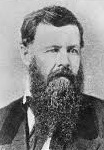

On May 23, 1858 a party from Auraria, Ga. led by William Greeneberry "Green" Russell (1818-77) arrives at the head of Cherry Creek in Colo. near the South Platte River at the W edge of the Great Plains on the 150-mi. Front Range of the Rocky Mts., and come up empty, going on to prospect on all the streams N to the Cache la Poudre River, returning in early July to the Platte River and camping in Little Dry Creek S of modern-day Denver, discovering gold and taking 20 oz. (several hundred dollars' worth), after which old trader John Cantrell returns to Kansas City with the good news backed up by samples, causing newspapers to start the Colo. (Pike's Peak) Gold Rush, during which 50K migrate within a year and 100K+ migrate by the time of the creation of Colo. Territory on Feb. 28, 1861, with the motto "Pike's Peak or Bust", although no gold is discovered within 50 mi. of it; meanwhile in Oct.-Nov. a party from Lawrence, Kan. that arrived near Pueblo on July 4 settles on the Platte River N of Denver, building 20-30 log cabins, which they call Montana City; on Oct. 29 a large number of prospectors that heard of the Russell discovery begin settling on both sides of Cherry Creek; on Nov. 1 the town of Auraria SE of the confluence of Cherry Creek and the South Plate River is founded three weeks before Denver by the Russell party; on Nov. 6 an election is held, and H.J. Graham is selected to travel to Washington, D.C. to talk Congress into organizing a new territory in vain, while A.J. Smith is sent to the Kan. Territorial legislature to do ditto, and they bite, establishing Arapahoe County in the W part of Kan. Territory to the crest of the Rocky Mts.; next Apr. a convention is held there to create the provisional State of Jefferson, which is never recognized by the U.S. govt.; on Nov. 22 Leavenworth, Kan. settler "General" William H. Larimer Jr. (1809-75) arrives, settling on a hill across Cherry Creek from Auraria, laying cottonwood logs along a 1 sq. mi. parcel of land to stake his claim, which he calls the mile-high (5,280 ft. elev.) city of Denver, Colo. (modern-day pop. 690K/2.8M), named after Winchester, Va.-born Kansas Territorial Gov. #5 (since Dec. 1857) James William "Jim" Denver (1817-92), opening the first store in Denver to service miners working in placer mines, founding the Denver Land Co. to sell tracts, calling Colo. "the most picturesque country in the world, with fine air, good water, and everything to make a man happy and live to a good old age" and trading tracts in Denver for grubstakes and gambling debts until the mines peter-out by 1860, causing tens of thousands to return home; the Denver streets are laid out parallel to the S bank of Cherry Creek near its confluence with the Platte Rive*r, ending up diagonal to the four cardinal directions, running from 13th St. N to 38th St., and E from Wawatta St. to Wazee St., Blake St., Market St., Larimer St., Lawrence St., Curtis St., Champa St., Stout St., California St., Walton St., Glenarm Pl., Tremont Pl., and Court Pl., ending at the intersection of W Colfax Ave. and Broadway, site of Civic Center Park and the Colo. State Capitol; on Apr. 6, 1860 Auraria is incorporated into Denver, becoming known as West Denver; Southern Arapaho chief Little Raven (Crow) (Hosa) (Oh-has-tee) (1810-89) welcomes the paleface settlers to the Denver gold camp, causing them to name Arapahoe St.; the Indian tribes are pushed S into the Arkansas River Valley; next year Larimer founds Mount Prospect (Prospect Hill) Cemetery in Denver on Arapaho land, which is converted to Cheesman Park in 1907; the real Denver visits Denver in 1875 and 1882 and receives little attention?
In 1858 the city of Carson City, Nev. on the E edge of the Carson Range of the Sierra Nevadas 30 mi. from modern-day Reno (alt. 4.8K ft.) is founded as a trading post, named for Kit Carson, experiencing a pop. surge from the 1859 Comstock Lode strike; in 1864 it becomes the capital of Nev., with the Virginia and Truckee Railroad connecting it with Virginia City, along with a log flume; in 1870-93 the Carson City Mint strikes gold and silver coins; by 1880 it becomes home to 1K+ Chinese immigrants (railroad workers), 20% of the pop.; too bad, after the Central Pacific Railroad builds a line through Donner Pass to the N, pop. begins to decrease.

On July 13, 1859 after taking his own advice and going west to Calif., stopping in Colo. to see the Pike's Peak Gold Rush, New-York Tribune ed. Horace Greeley (1811-72) stops in Salt Lake City, Utah for a 2-hour Interview with Brigham Young, which is printed in his paper in Q&A form on Aug. 20; Greeley: "What is the position of your church with respect to slavery?"; Young: "We consider it of divine institution, and not to be abolished until the curse pronounced on Ham shall have been removed from his descendants."
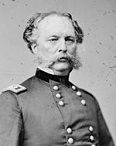
In 1859 at the request of the War Dept., U.S. Army Capt. Randolph Barnes Marcy (1812-87) (who accompanied U.S. Brig. Gen. Albert Sidney Johnston on his expedition against the Mormons in Utah in 1857) pub. The Prairie Traveler: A Handbook for Overland Expeditions, with Maps, Illustrations, and Itineraries of the Principal Routes between the Mississippi and the Pacific, giving advice for Am. pioneers on stopping points, mileage, gathering of provisions, and ways to handle Indians and bears on the way to Utah, Ore., and Calif., becoming a bestseller for the rest of the cent.; "Perhaps the single most important work on the conduct of frontier expeditions published under the aegis of the War Department." (Andrew J. Birtle)




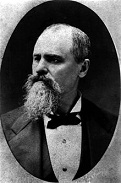
80 riders and 400 horses cover for the lack of a telegraph system as Americans have finally stolen the continent from east to west? On Apr. 3, 1860 the Pony Express created by the merger of the Central Overland Calif. and Pikes Peak Express Cos. begins service between St. Joseph, Mo. and Sacramento, Calif. (1,850 mi.) (ends Nov. 20, 1861 after 19-1/2 mo.); horses are ridden at full gallop, and are changed at 157 (192?) relay stations 10 mi. (12 mi.?) apart, and each rider rides 100 mi.; founders are William Hepburn Russell (1812-72), William Bradford Waddell (1807-72), and Alexander Majors (1814-1900); posters read "Wanted: young, skinny, wiry fellows not over eighteen. Must be expert riders, willing to risk death daily. Orphans preferred. Wages $25 per week"; the first rider is either Johnny Frye or John William "Billy" Richardson (1850-), who departs St. Jo at exactly 7:15 p.m.; William "Sam" Hamilton becomes the last of 30 men to carry the mail on the westward trip, arriving in Sacramento after midnight on Apr. 14 (about 1 hour less than 10 days total); James Randall picks it up eastbound from San Francisco; when the rider reaches St. Jo, overeager spectators pluck hairs from the horse's tail as souvenirs; meanwhile a steamer carries the mail from Sacramento to San Francisco, and when the Pony Express rider disembarks he is greeted by rockets and a band playing "See, the Conquering Hero Comes"; riders carry their mail in a mochila (saddle mail bag), with 1K or so letters wrapped in water-resistant oiled silk, going from St. Jo to Sacramento via Marysville, Kan., Ft. Kearny, Neb., Julesburg, Colo., Ft. Larami, Wyo., Salt Lake City, Utah, and Friday's Station, Nev.; "Buffalo Bill" Cody is a rider at age 15; the mail costs 10 cents from the East Coast and $5 per half oz. from St. Jo to Sacramento; riders incl. Wild Bill Hickock, and William Frederick Cody, who later becomes Buffalo Bill Cody; the Kansas City Internat. Airport is later built 25 mi. S of St. Jo, "where the Pony Express started and Jesse James ended"; Nicholas, Ky.-born stagecoach tycoon Benjamin "Ben" Holladay (1819-87) buys the Pony Express, establishing the Overland Stage Route over the Overland Trail, starting out with a postal contract for mail service to Salt Lake City and growing to seven routes receiving govt. subsidies of $6M/year until he sells-out to Wells Fargo Express in 1866 for $1.5M.

In Dec. 1860 30 white miners surprise-attack the camp of some Bedonkohe Apaches on the W bank of the Mimbres River, killing four and capturing 13 women and children, pissing-off Apache chief Mangas Coloradas (1793-1863), who goes on the warpath, raiding U.S. territory.
On Jan. 27, 1861 the Bascom Affair begins when some Tonto and Coyotero Apaches raid the ranch of John Warn at Sonoita Creek, stealing cattle and kidnapping his 12-y.-o. stepson Felix Ward, after which some infantry led by Lt. George Nicholas Bascom leave Fort Buchanan, Ariz. in search of him, leading them to the Chiricahua Apaches; on Feb. 3 he lures Cochise into a meeting where he ambushes him and his family, capturing and imprisoning them in a tent, but Cochise cuts a hole in the wall and escapes, and on Feb. 6 leads a large war party to attack some Am. and Mexican teamsters, torturing and killing nine Mexicans and taking three Ams. hostage, but when Bascom refuses to exchange them for his family he attacks him on Feb. 7 while they are fetching water, fleeing to Sonora, Mexico and leving the corpses of the tortured Am. hostages behind; on Feb. 19 Lt. Isaiah Moore hangs Cochise's brother and nephews, pissing-off Cochise, who drops his war with the Mexicans and begins targeting the U.S., launching the 25-year Apache Wars (ends 1886); Felix Ward is brought up by the Coyotero Apaches and later becomes a U.S. Army Apache scout named Mickey Free.

In early Aug. 1861 Chiricahua Apache chief Cochise (1815-74) ("strength of oak") appears at a U.S. Army post in Ariz. Territory to deny charges that he kidnapped a white child, is taken prisoner, escapes, then takes hostages to be exchanged for other Chiricahuas held by the palefaces, but after the exchange doesn't take place, the hostages are killed on both sides, and Cochise joins his father-in-law Mangas Coloradas of the Mimbreno Apaches and tries to drive all paleface gringo butts out of their Arizona.
On May 20, 1862 Pres. Lincoln signs the U.S. Homestead Act of 1862 (effective next Jan. 1), giving citizen heads of households who are at least 21-y.-o. and never took up arms against the U.S. govt. a 160-acre tract of farmland (stolen from the Indians, who are forced onto reservations) provided they improve it (build a house and plow at least 10 acres) and live there at least five years); Confederates are excluded, but blacks aren't, and comprise 5% of the homesteaders; 2 wks. of service in the U.S. Army qualifies, regardless of age, incl. 8-y.-o. drummer boys; only 40% of the homesteaders last the required five years; the 1866 U.S. Southern Homestead Act helps black sharecroppers during Reconstruction; the 1873 U.S. Timber Culture Act requires claimants to plant trees; the 1904 U.S. Kinkaid Act applies to W Neb.; the 1909 U.S. Enlarged Homestead Act doubles allottments from 160 to 320 acres; the 1916 U.S. Stock-Raising Homestead Act increases allottments to 640 acres; by the time the act is revoked in 1986, 270M acres in 30 states (incl. Alaska) are settled in 1.6M homesteads, and one-third of modern Americans are descended from the homesteaders; the first person to file a claim is Daniel Freedman (1826-1908) in Beatrice, Neb., who marries Agnes Suiter Freeman (1843-1931) in 1865 and together have eight children; their land becomes the site of the freely suitable Homestead Nat. Monument of Am., authorized Mar. 19, 1936.
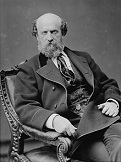
On Jan. 18, 1863 after recovering from a bullet wound in the chest and agreeing to talk peace, Mangas Coloradas is betrayed at Fort McLane in SW N.M. by Union Brig. Gen. Joseph Rodman West (1822-98), who orders him tortured and murdered by his soldiers, who boil his head and send it to New York City phrenologist Orson Squire Fowler, pissing-off the Apaches and causing their war to continue almost 25 years (until 1886).
In July 1863 after N.M. district military gov. Gen. James H. Carlton tells 18 Navajo chiefs that they must surrender by July 20 and move to Ft. Sumner in SE N.M., the U.S. Army, led by Kit Carson begins a campaign against the Navajos using the first written U.S. Army scorched earth policy, starving them into submission by next Jan. in order to relocate them to a Rez on junk land on the Pecos River.
In Jan. 1864 the Bloody Tanks Massacre near Pinal Creek in Ariz. Territory results when rancher King S. Woolsey, pres. of the legislative council pulls a pistol from his coat during a peace parley and murders Pinal Apache chief Paramuca, then has his men murder the other 25-200 gunless Apaches, depending on the source; one white man, Cyrus Lennan is killed when an Indian plays dead then lances him before being gunned down; the blood pools in rock basins, causing the name "bloody tanks", although the whites call it the "Pinole Treaty Battle", and paint themselves as heroes, causing Wooley to be lionized as "Arizona's greatest Indian fighter"; meanwhile the Indians' story (first pub. in 1936) is that the whites had killed off their food supply of deer and stolen their cornfields, causing them to starve, and they had stolen a few cattle and ponies to feed themselves, and only wanted the palefaces to promise not to take any more from them, and when the chief told the paleface that he only wanted peace, Woolsey replied, "We're going to give you peace, a new kind of peace" and fires away, telling his men to "pick out your Indian".
In Jan. 1864 Kit Carson's forces round up 8K starving Navajos and send them on the first of several Long Walks of the Navajo from Ft. Defiance to new Ft. Sumner at Bosque Redondo (Sp. "Round Forest", N.M., committing atrocities along the way, with 200 dying during the 18-day 450-mi. (720km) trek; by 1865 8K-9K settle on a 40 sq. mi. area in concentration camps where they are forced to live in holes in the ground under armed guards with inadequate rations, where 3.5K die.

On Nov. 25, 1864 after 335 Calif. and N.M. volunteers and 70 scouts under Col. Kit Carson attack the 150 tepees of the Kiowas under chief Little Mountain and Iron Shirt, other Kiowas under paleface-hating chief Satanta (Set-tainte) ("White Bear") (1820-78), Stumbling Bear, and Lean Bear, allied with the Comanches, Apache, and Arapaho counterattack at the First Battle of Adobe Walls in the Tex. Panhandle near the Canadian River (near the ruins of William W. Bent's trading post), and the palefaces get surrounded, using two small mountain howitzers with 12-lb. shells on the swarms of Indians, then retreating toward the village of Little Mountain while being chased by shell-dodging braves; after a bitter tepee-to-tepee fight Kiowa Chief Iron Shirt is KIA, the Indians flee, and the tepees are torched by the palefaces; total losses: Indian: 60 KIA and wounded; palefaces: two killed and 10 wounded; Indian allies of palefaces: one killed and five wounded; too bad that the palefaces' horses are too tired to chase the fleeing Indians?




Keep those stiches loose and soon you'll have a nice little cover? Just when white-on-white carnage is starting to end, White is Right America finally goes too far even for its own conscience? On Nov. 29, 1864 (a.m.) in Colorful Colo. after a band of Cheyenne and Arapaho leave Ft. Lyons without permission, scaring the pop. of Denver, causing Pres. Lincoln to approve shoot-on-sight orders, after which Gov. Evans issues a proclamation in Aug. ordering "all citizens of Colorado... to go in pursuit of all hostile Indians [and] kill and destroy all enemies of the country", the Sand Creek (Chivington) (Cheyenne Indian) Massacre of the 330-person camp of chiefs Black Kettle (1801-68) (Southern Cheyenne) (115 lodges) and White Antelope (Arapaho) (8 lodges) (9 mi. from modern-day Lamar) along a sluggish trickle of the South Platte shocks the nation with cruelty to native women and children by the volunteer troops of the First Colo. Infantry, led by Methodist minister (since 1844) Col. John Milton Chivington (1821-94), who was ordered to take his 750 soldiers to SE Colo. by Colo. Territorial Gov. (1862-5) John Evans (1814-97) to rid the state of Injuns after the mutilated bodies of a white settler, his wife and two young children are exhibited in Denver; after Chivington tells his men the night before, "Kill and scalp all, little and big; nits make lice; kill every topknot", and "I long to be wading in gore", then right before the attack, "Boys, I won't tell you who you are to kill, but remember our murdered women and children on the Platte; take no prisoners", the white devils kill and mutilate about 150 mostly women, children and elderly, even though they had set up camp at the direction of a U.S. gen. and flew a U.S. flag along with a white flag; some soldiers make trophies out of women's vaginas after cutting off their breasts and suckling them; chief White Antelope is castrated, and his scrotum later used as a tobacco pouch; in the night Jack Smith, half-breed son of squawman John S. Smith is murdered in his father's lodge after Chivington tells his men not to take prisoners; Chivington claims an Indian kill of 500-600, vs. 9 of his men killed and 38 wounded, and lies that most of the women and children escaped, burning the bodies and the camp to cover his tracks; 11 white captives are found in the lodges, and later used to justify the attack; mountain man Jim Beckwourth was the guide used to lead them to the camp, but suffers from arthritis and only watches from a distance; despite an attempted coverup, the Denver papers (beginning a long tradition of biased reporting) calling Chivington a hero, the Congressional Joint Committee on the Conduct of the War along with the U.S. Army hold hearings; Capt. Silas Stillman Soule (1838-65) (a dedicated abolitionist), who refused to order his men to fire on the Indians, testifies against Chillington, er, Chivington, "the Butcher of Sand Creek", and is later murdered; in 1865 the U.S. admits guilt and orders reparations, which a cent. later are still not paid; the whole affair causes Colo. statehood to be delayed until 1876; Chivington avoids an ordered court martial because his officer's commission expires, and is hounded to his death in 1894, claiming "I stand by Sand Creek"; by the end of the decade the way of life of the Am. Plains Indians is kaput, allowing white settlers to flock in and set up shop after the bison are exterminated; on July 18, 1865 Pres. Johnson asks Gov. Evans to resign for attempting a coverup; the scandal causes Colo. statehood to be delayed until 1876; on Aug.2, 2005 Pres. George W. Bush signs a bill restoring some of their remains to the site and creating the Sand Creek Massacre Nat. Historic Site; on Dec. 3, 2014 Colo. Gov. John Hickenloper formally apologizes to the descendants of the massacre in Denver.


On July 13, 1865 Horace Greeley (1811-72) allegedly pub. an editorial in the New-York Tribune that co-opts John B.L. Soule's 1851 phrase "Go West, young man", addressed to young civil servants in Washington, D.C.; "Washington is not a place to live in. The rents are high, the food is bad, the dust is disgusting and the morals are deplorable. Go West, young man, go West and grow up with the country"; Congregational minister and future U.S. rep. (R-Iowa) (1863-7) Josiah Bushnell Grinnell (1821-91) claims that Greeley coined the phrase in 1833, telling him: "Go West, young man, go West. There is health in the country, and room away from our crowds of idlers and imbeciles"; Greeley disavows being the author of the phrase, which doesn't stop the founders of Greeley, Colo. (1886).

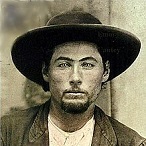
On July 21, 1865 (6:00 p.m.) after Tutt takes his watch to pay his card game winnings, and he warns him in vain to never wear it in public, LaSalle County, Ill.-born James Butler "Wild Bill" Hickock (1837-76) wins a gunfight in the town square of Springfield, Mo. with Yellville, Ark.-born ex-friend gambler Davis Kasey "Little Dave" Tutt (1836-65), killing him with one extraordinary shot from his Colt Navy pistol, becoming the first famous Am. Wild West gunfight and making Hickock the first famous Am. Wild West gunfighter.
In 1865 after the U.S. Civil War ends, the bloody Confederate state of Mo. spawns clans of notorious bank robbers and outlaws, who are protected and idolized by the Mo. pop. as rebel Robin Hoods, incl. the James Gang, the Younger Gang, the Clanton Gang, and the Earp Gang. On Feb. 13, 1866 the Jesse James Gang, composed of unemployed Confed. guerrilla "bushwacher" soldiers stages the first daylight bank robbery in the U.S. at the Clay County Savings Assoc. in Liberty, Mo., taking $15K in gold coins. On Jan. 26, 1875 Pinkerton detectives siege Frank James and Jesse James, who are holed up in the Reuben Samuel farmhouse in Kearney, Mo., throwing a hollow iron ball filled with flammable fluids into it, killing 9-y.-o. Archie Peyton Samuel (half-brother of the James brothers), mangling the right arm of Zelda Samuel (mother of the James brothers) so badly it requires amputation, and injuring a servant; the James brothers are unharmed. On Sept. 7, 1876 after robbing a train at Rocky Cut, Minn., the James Gang (Jesse James, Bill Stiles, Cole Younger) attempts to rob the First Nat. Bank in Northfield, Minn. (to zing the Yankees, or get some real Yankee money for a change?), murdering cashier Joseph Lee Heywood (b. 1837), but thanks to the Pinkertons the town is ready, and they are greeted with a hail of bullets, killing two members.
In 1865 the Indian Wars begin in the U.S. as European-descended whites fight and subdue all the Native Americans in the U.S. by 1890 in a rather one-sided genocide, starting with the Black Hawk War (ends 1872) in C and S Utah between Mormon settlers in Sanpete County, Sevier County et al. and 16 Ute, Paiute, Apache, and Navajo tribes led by Ute (Timpanogos) war chief Antonga Black Hawk (1830-70), which ends after 150 battles after intervention by 200 federal troops.

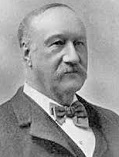
In 1865 as the U.S. Civil War ends, Texas has nothing but a zillion head of cattle to sell (5M running wild), so frontier scout Jesse Chisholm (1806-68) blazes the Chisholm Trail from San Antonio, Tex. to Abilene, Kan. (ends in the 1880s); meanwhile on Dec. 25 the $1.5M Union Stock Yards in Chicago, Ill., built by Dutchess County, N.Y.-born Samuel Waters Allerton (1828-1914) and John B. Sherman on railroad money open on a 345-acre tract of reclaimed swamp land SW of the city limits, which later expands to 475 acres, benefitting from the virtual shutdown of the Mississippi Valley by the war, along with meat-packing centers St. Louis, Louisville and Cincinnati, with pens that can hold 10K head of cattle and 100K hogs; meanwhile Chicago doubles its packing capacity in one year, with eight new major plants plus many smaller ones, serving nine railroads; the stock yards peak in 1924 and finally close on July 30, 1971.
In 1865 Ft. Selden is built across the Rio Grande River from Mt. Robledo at the S entrance to the Jornada del Muerto to protect travelers on El Camino Real from Apaches; unfortunately the Indians can look down into the fort from the mountain and see when the soldiers are gone; after the fort is abandoned a legend that $80K in gold is buried there causes treasure hunters to pock-mark it with holes.

On June 1, 1866 the rip-roaring cow town city of Denver renames McGaa St. to Holladay St. in honor of Nicholas, Ky.-born stagecoach tycoon Benjamin "Ben" Holladay (1819-87), becoming the center of Denver's "flesh market" (red-light district), known to visiting cowboys for Jenny Rogers' House of Mirrors, Mattie Silks' place, etc., gaining the rep of "the most sinful street in the West"; on June 1, 1889 after complaints by Holladay's relatives the city council renames it to tongue-in-cheek Market St., and in Sept. 1899 changes the section N of 23rd Ave. to Walnut St.; the street survives to modern times.

In July 1867 the Overland Monthly is founded in San Francisco, Calif., with Albany, N.Y.-born Francis Bret Harte (1836-1902) as ed., allowing him to pub. his kick-ass short stories of the Am. West, incl. The Luck of Roaring Camp, The Outcasts of Poker Flat, Miggles, Brown of Calaveras, and his comic poem Plain Language from Truthful James (The Heathen Chinese).

 On Nov. 16, 1867 after starting a gold rush in Yavapai County in the C highlands of Ariz. Territory in 1863, Anderson, S.C.-born Confed. veteran
John W. "Jack" Swilling (1830-78)
forms the Swilling Irrigating and Canal Co. in Wickenburg, Ariz, pioneering modern irrigation canals in the Salt Valley of Ariz. modeled on ancient Hohokam canals;
next summer he founds the city of Phoenix, Ariz. (modern-day pop. 1.6M/4.6M)
in the Salt River Valley, with Kent, England-born settler "Lord" Phillip Darrell Dupa (1832-92)
suggesting the name, establishing their first post office on June 15 and becoming postmaster and justice of the peace.
On Nov. 16, 1867 after starting a gold rush in Yavapai County in the C highlands of Ariz. Territory in 1863, Anderson, S.C.-born Confed. veteran
John W. "Jack" Swilling (1830-78)
forms the Swilling Irrigating and Canal Co. in Wickenburg, Ariz, pioneering modern irrigation canals in the Salt Valley of Ariz. modeled on ancient Hohokam canals;
next summer he founds the city of Phoenix, Ariz. (modern-day pop. 1.6M/4.6M)
in the Salt River Valley, with Kent, England-born settler "Lord" Phillip Darrell Dupa (1832-92)
suggesting the name, establishing their first post office on June 15 and becoming postmaster and justice of the peace.

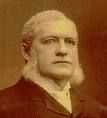
In 1867 Philip Danforth Armour (1833-1901), who became head of Plankinton Packing Co. in Milwaukee, Wisc. (founded 1852) in 1863 and acquired a large interest in the grain business of his brother Herman Ossian Armour (1837-1901) forms Armour & Co. in Chicago, Ill., adding a pork packing plant to it next year; in 1870 they merge, becoming a pioneer in canned meat and refrigeration, causing demand for beef to zoom, with prices reaching $40 a head, making it profitable to herd cattle from long distances incl. Tex., which is first tried in 1866; too bad, they treat their workers like manure, fighting unionization and breaking strikes in 1904 and 1921 after being caught selling tainted beef to the U.S. Army during the 1898 Spanish-Am. War; the Meatpacking Union finally succeeds in unionizing the co. in the late 1930s, joining the CIO; in 1884 Armour dissolves his partnership with Plankinton, and the Milwaukee operation becomes Cudahy Packing Co.

On May 9, 1868 the city of Reno, Nev. in N Nev. on the Truckee River 22 mi. SW of Lake Tahoe (modern-day pop. 225K/425K) is founded at Lake's Crossing on the Central Pacific Railroad in Truckee Meadows at the foot of the Sierra Nevada Mts., named for U.S. Gen. Jesse Lee Reno (1823-62); it is incorporated on Mar. 16, 1903, going on to become known as "the Biggest Little City in the World" for its hotels and casinos.
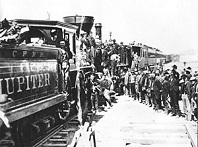





On May 10, 1869 (2:47 p.m. EST) the 1,907-mi. $100M Union Pacific-Central Pacific First Transcontinental Railroad AKA the Overland Route is completed by 3K mainly Irish workers, and the last Golden Spike (originally mahogany with silver plaque, which is stolen) is driven at Promontory Summit, Utah (U-tie?) 66 mi. NW of Salt Lake City at 2:47 P.M. EST by Central Pacific pres. (since 1861) (Repub. Calif. gov. #8 in 1862-3) Amasa Leland Stanford (1824-93) with a silver hammer (first swing misses) (made by Schultz, Fisher and Machling of San Francisco, weighing 18 oz., with a 6-in. nugget attached to the head); the chief engineer of the Central Pacific Railroad Co. of Calif. is Bridgeport, Conn.-born Theodore Dehone "Crazy" Judah (1826-63), which built 690 mi. (1,110 km) E from Sacramento, Calif.; the Union Pacific Railroad Co. built 1,085 mi. (1,746 km) W from Council Bluffs, Iowa (near Omaha, Neb.) to Promontory Summit, Utah Territory; the Western Pacific Railroad Co. built 132 mi. (212 km) from the W terminus at Alameda/Oakland, Calif. to Sacramento, Calif.; Judah funded the Central Pacific from funds from four Sacramento merchants incl. Stanford, Collis Potter Huntington (1821-1900), Mark Hopkins Jr. (1813-78), and Charles Crocker (1822-88); Union Pacific locomotive #119 and Central Pacific locomotive #60 ("Jupiter") are the first to cross; the word "done" is sent out over the telegraph wires; the golden spike is then withdrawn for safekeeping, and is used in Cecil C. DeMille's 1939 film Union Pacific; the eastbound team covered 690 mi. and the westbound team 1,086 mi.; the Union Pacific Railroad, the first transcontinental (New York City to Sacramento) railroad is chartered; the first train from Sacramento reaches New York City on July 29 after a journey of 6.5 days; the railroad allows East Coast beer to be shipped to the West; during the next decade the U.S. lays down railways at the rate of 10K mi. a year, causing travel on the Oregon Trail to die out; the railroad brings loads of non-Mormon settlers into the gigantic Mormon dream state of Deseret, causing plans to be dropped in favor of the more realistic Mormon state of Utah.

On May 29, 1869 Mount Morris, N.Y.-born geologist John Wesley "Wes" Powell (1834-1902) of Ill. Wesleyan U. begins the 3-mo. Powell Geographic Expedition of 1869) starting from Green River Station, Wyo., becoming the first recorded trip by white Euros through the entire Grand Canyon, ending at the confluence of the Colorado and Virgin Rivers in Nev., surviving hardships incl. boat losses to pub. The Exploration of the Colorado River and Its Canyons in 1875.
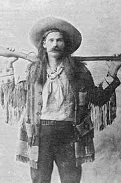
On July 4, 1869 the world's first Rodeo is held in Deer Trail, Colo.; later Payson, Ariz. hosts the first continuous Am. rodeo in 1884, organized by Abraham (Charles) Henson "Arizona Charlie" Meadows (1860-1932).
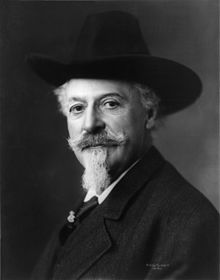

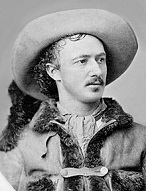
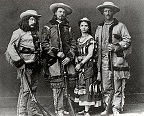
On Dec. 23, 1869 after being dishonorably discharged from the U.S. Army for drunkenness, being snubbed by Wild Bill Hickock in Ft. McPherson, Neb. then meeting Le Claire, Iowa-born William Frederick "Buffalo Bill" Cody (1846-1917) in Neb. earlier in the year while giving a temperance lecture and allegedly creating his nickname, Harpersfield, N.Y.-born dime novelist Ned Buntline (Edward Zane Carroll Judson Sr.) (1821-86) begins pub. the serial novel Buffalo Bill, the King of the Border Men in the New York Weekly, after which New York City playwright Frank Meader debuts a play about Cody in 1872 at the Bowery Theater, which is seen by Cody, after which in Dec. 1872 Buntline's play Scouts of the Prairie debuts in Chicago, Ill., starring Cody, along with Buntline (who leaves in 1873 and is replaced by shy Wild Bill Hickock), colorful Fluvanna County, Va.-born scout John Baker "Texas Jack Omohundro (1846-80) (a courier for Confed. Gen. J.E.B. Stuart, known as "the Boy Scout of the Confederacy" for his knowledge of the countryside), his future wife (Aug. 31, 1873) Italian ballerina Giuseppina Moriacchi, and sometimes 6-y.-o. Carlos Montezuma as Atzeka, the Apache child of Cochise, becoming a big hit despite being panned by critics, performed in packed theaters across the U.S. for several years, giving Cody training for his Wild West Show; in 1877 Omohundro forms his own acting troupe in St. Louis, Mo., debuting "Texas Jack in the Black Hills" in May to rave reviews. his future wife (Aug. 31, 1873) Italian ballerina Giuseppina Moriacchi, and sometimes 6-y.-o. Carlos Montezuma as Atzeka, the Apache child of Cochise, becoming a big hit despite being panned by critics, performed in packed theaters across the U.S. for several years, giving Cody training for his Wild West Show; in 1877 Omohundro forms his own acting troupe in St. Louis, Mo., debuting "Texas Jack in the Black Hills" in May to rave reviews.


In Mar. 1870 after obeying Horace Greeley's 1865 exhortation to "Go West, young man" and arriving in Colo. in Oct. 1869, Ohio-born Nathanial "Nathan" Cook Meeker (1817-79) founds the utopian Union Colony, which on Apr. 6, 1886 becomes Greeley, Colo. (modern-day pop. 103K), known for its frequent stench from a slaughterhouse; each of 300 families pays $155 to be part of the initial "joint stock venture"; meanwhile on Dec. 1 after the Colo. Central Railroad lays tracks through it to link Golden, Colo. with Jersey Junction 5 mi. N of Denver, N.Y.-born Benjamin F. Wadsworth and Louis A. Reno (1833-1906) found Arvada, Colo. (modern-day pop. 110K), named after Hiram Arvada Haskin, brother-in-law of settler Mary Wadsworth, wife of Benjamin Wadsworth, who becomes its first postmaster; it incorporates on Aug. 14, 1904.



On Apr. 30, 1871 the Camp Grant Massacre in Ariz. Territory sees a group of whites and Mexican Ams. plus some Tohono O'odham Indians sneak into a planned Apache Rez in Aravaipa Canyon in Ariz. (60 mi. NE of Tucson) and massacre 150 Apaches, mostly women and children. In the spring undefeated Comanche chief Quanah Parker (1845-1911) (whose mother was a part-white woman) raids Texas, drawing allied Indian bands along, causing the U.S. 41st Black Infantry to go after them, only to see the Kiowa almost capture Gen. Tecumseh Sherman then disappear into the Llano Estacado (Staked Plain) or into Indian Territory, knowing that U.S. policy prohibits the U.S. military from entering without permission of the Indian Agent; the soldiers finally capture Kiowa chiefs Satank (Satanta) (Set-tainte) (1810-79) (an old guy) and his cousin Big Tree (1847-1929) after they brazenly come to Ft. Sill and brag to Gen. William T. Sherman that they had attacked a wagon train on May 18 and scalped seven freighters; after Satank attempts an escape and is killed, the rest are turned over to Texas authorities at Ft. Richardson, convicted of murder on July 5-6, and sentenced to hang, but on Aug. 2 Tex. Gov. Edmund J. Davis commutes their sentences to life imprisonment at the Texas State Prison at Huntsville, and after they grow ill Set-tainte and Big Tree are paroled on Aug. 19, 1873, after which Big Tree becomes a Baptist deacon, while Set-tainte lies low until the 1874 Red River War.
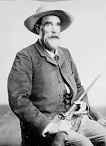
In Oct. 1872 after befriending him in 1871, Indian agent and Army scout Thomas Jefferson "Tom" Jeffords (1832-1914) leads Gen. Oliver O. Howard to the stronghold of Apache leader Cochise (1805-74) (who began an uprising in 1861) in the Dragoon Mts. in SE Ariz., talking him (with help of interpreter Geronimo) into negotiating a peace treaty on Oct. 12 accepting the new Chiricahua Rez, bringing peace in S Ariz. until 1876, when renegade Apaches kill whiskey merchant Nicholas Rogers.

On Nov. 29, 1872 the Modoc Indians of N Calif., led by Captain Jack (-1873), who had been forcibly relocated to a rez in Oregon along with their enemies the Klamath Indians in 1864, who mistreated them for years, causing them to return and dig in among lava beds S of Tule Lake in 1870, start shooting at U.S. soldiers attempting to disarm them and return them to the hated rez, beginning the Modoc War (ends June 1873).
In 1872 "Cowboy Capital of the World", "Wickedest Little City in the West", "Queen of Cowtowns" Dodge City, Kan. on the Arkansas River in SW Kan. (on the meridian separating Central and Mountain time) 5 mi. W of Ft. Dodge (modern-day pop. 27K) (founded last year as an outpost on the Santa Fe Trail and originally called Buffalo City) becomes connected to the Atchison, Topeka, and Santa Fe Railway, becoming a main shipping point for Texas cattle (unti 1885), famous for lawmen Wyatt Earp and Bat Masterson, Front St., the Long Branch Saloon, and Boot Hill (where they bury them with their boots on).

On Feb. 9, 1874 Allegheny County, Penn.-born Civil War Union Army vet Alfred Griner "Alferd" Packer (1842-1907) becomes Colo.'s most famous epicure when his traveling party of six leaves Montrose, Colo. en route to the Los Pinos Indian Agency near Gunnison, Colo. and becomes snowbound in the Rockies and he dabbles in cannibalism, arriving alone on Apr. 16 with a suspicious story, compounded by spreading cash around, running from the law for nine years before being discovered on Mar. 11, 1883 in Cheyenne, Wyo. living under the alias John Schwartze, tried on Apr. 6 in Lake City, Colo. and convicted of murder on Apr. 7 and sentenced to death, with presiding judge M.B. Gerry uttering the soundbyte: "Stand up yah voracious man-eatin' sonofabitch and receive yir sintince. When yah came to Hinsdale County, there was siven Dimmycrats. But you, yah et five of 'em, goddam yah. I sintince yah t' be hanged by th' neck ontil yer dead, dead, dead, as a warnin' ag'in reducin' th' Dimmycratic populayshun of this county. Packer, you Republican cannibal, I would sintince ya ta hell but the statutes forbid it"; in Oct. 1885 the Colo. Supreme Court reverses his sentence, and on June 8, 1886 he is convicted of five counts of manslaughter and sentenced to 40 years, becoming the longest prison sentence so far in U.S. history; he is paroled on Feb. 8, 1901 after gaining publicity by petitioning the Colo. gov., and goes to work as a guard at the Denver Post, allegedly going vegetarian before dying on Apr. 23, 1907 in Deer Creek, Colo. and being buried in Littleton, Colo.
On June 27-July 2, 1874 the 5-day Second Battle of Adobe Walls in the Tex. Panhandle sees several hundred Comanches led by Quanah Parker siege 28 white bison hunters holed-up in a ramshackle outpost, losing 30-70 warriors vs. only four whites, one of whom shot himself by accident, before giving up and riding away after more hunters arrive, beefing the garrison up to 100 men and Parker is wounded; one of the hunters is young Bat Masterson; buffalo hunting ceases in that region; later in the summer the Red River War begins as the Southern Plains tribes (Comanche, Kiowa, Southern Cheyenne, Arapaho) make a last attempt to get their stolen prairies back from the paleface U.S. Army, which wants to remove them from the Southern Plains and forcibly relocate them to reservations in Indian Territory; on Oct. 4 Set-tainte and 144 Kiowas decide to surrender to the white men in order to get food and blankets for the winter, and Set-tainte is put back in Texas State Prison for parole violation, and on Oct. 11, 1878 he commits suicide by leaping headfirst from a 2nd story window of the prison hospital into a brick wall; in 1963 his remains are reburied in the cemetery at Ft. Sill; "The red man was pressed from this part of the West,/ He's likely no more to return/ To the banks of the Red River where seldom if ever/ Their flickering campires burn" - Home on the Range.

In 1875 after beating his owner during the U.S. Civil War and escaping to Indian Territory and learning their languages, former African-Am. slave Bass Reeves (1838-1910) is appointed a deputy U.S. marshal by new U.S. marshal James F. Fagan, becoming the first black deputy to serve W of the Mississippi River, going on to work In Indian Territory for 32 years (until 1907), arresting 3K+ felons.

On Jan. 24, 1876 Quebec, Canada-born Am. buffalo hunter and U.S. Army scout Bartholomew William Barclay "Bat" Masterson (1853-1921) has his first gunfight in Sweetwater, Tex. with Cpl. Melvin A. King after accidentally killing his babe Mollie Brennan, killing him after being wounded in the pelvis, after which he settles in Dodge City, Kan., being elected Ford County, Kan. sheriff on Nov. 6, 1877 by three votes, after which his brother Ed Masterson (1852-78) becomes Dodge marshal on Dec. 6, giving the Masterson brothers control of city and county law enforcement; too bad, Ed is KIA on Apr. 9, 1878 by cowboy Jack Wagner and killed by Bat; on Oct. 4, 1978 actress Fannie Keenan (Dora Hand) is murdered by James Kennedy, son of wealthy Tex. cattleman Miflin Kennedy, causing Bat to form a posse incl. Wyatt Earp and Bill Tighman that tracks him down and captures him after killing his horse; on Nov. 4, 1879 after losing the Royal Gorge Railroad War near Pueblo, Colo. on June 12, he loses his reelection to bartender George T. Hinkel (1846-1922) by a 404-268 vote.
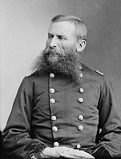


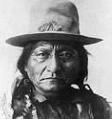




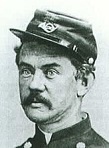





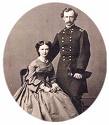
In Feb. 1876 the 16-mo. Great Sioux (Black Hills) War (ends 1877) begins with a 3-pronged invasion of Indian heartland in the Black Hills in a push to force "hostiles" back onto a rez so that they can get their hands on the gold, and ends up costing 283 Army officers and enlisted men in a campaign in Dakota, Mont., and Wyo. territories; on Mar. 17 the Battle of Powder River (Reynolds' Battle) on the Powder River in Mont. sees troops from Ft. Fetterman in Wyo. under Col. (later Maj. Gen.) Joseph Jones Reynolds (1822-99) under orders from Brig. Gen. (later Maj. Gen.) George R. Crook (1830-90) attack a Cheyenne encampment, destroying a large amount of property and pissing them off, solidifying their resistance and cementing alliances with the Lakota Sioux; in Mar. troops under Col. J.J. Reynolds mistakenly attack a sleeping village legally wintering on the rez, angering Chief Crazy Horse (1849-77), causing him to join up with Sitting Bull (1831-90) (who has a dream that white soldiers are falling like grasshoppers as Indians ride over them) and other tribes; on June 9 the Battle of Prairie Dog Creek (Tongue River) at the confluence of Prairie Dog Creek and the Tongue River in Wyo. is a V for 950 U.S. troops under Gen. George R. Crook along with 100+ civilians over 200 Northern Cheyenne; on June 17 they win the Battle of the Rosebud (Battle of Rosebud Creek) in Montana against 1.2K men led by Brig.-Gen. George R. Crook (1830-90), pushing them back to Goose Creek inside the Wyo. border; Shoshone chief Washakie (1804-1900) sends scouts to help Gen. Crook against his enemies the Sioux, later going Protestant and negotiating the Wind River Reservation in Wyo.; on June 25 (Sun.) after dividing his force twice, sending Capt. (later Maj.) Frederick William Benteen (1834-98) to move SW and Maj. Marcus Albert Reno (1834-89) to attack from the N, arrogant buckskin-wearing goldie locks Brevet Maj. Gen. (Lt. Col.) George Armstrong "Yellow Hair" Custer (b. 1839) and 210 men of his 7th Cavalry (out of 266 men) (incl. Custer's brother, three other relatives and a newspaper correspondent) walk into an ambush on a knoll covered by prairie grass which descends along a wooded ravine to the Little Bighorn River, where 3.5K Cheyenne, Sioux, and Arapaho warriors led by Chief Crazy Horse are encamped, and are massacred at the Battle of the Little Bighorn, holding out for 1-3 hours; the only survivor is the mixed-breed horse of Capt. Myles W. Keogh, named Columbia, er, Washington, er, Anything White, er, Something Indian, er, Comanche; Col. (later Maj. Gen.) Frederick Dent Grant (1850-1912) (eldest son of Gen. Ulysses S. Grant) escapes the massacre by a "compassionate leave" to be with his wife during childbirth 1-2 days before; a few Indian scouts hold back and escape, and 19-y.-o. Crow scout Curly (Curley) (Ashishishe) (1856-1923) first brings news of the disaster to Gen. Alfred Howe Terry (1827-90), becoming a celeb; Benteen's men are pinned down 5 mi. away until June 27, when Terry's infantry, joined by Gen. John Gibbon (1827-96) advance, and the Indians leave to look for food and ammo, allowing them to view the site on June 27, finding the corpses stripped and ritually mutilated, although Custer's gorgeous godlike blonde body is untouched; Custer's men only have 1873 Springfield .45-70 single-shot rifles, vs. Henry and Winchester lever-action rifles, revolvers, and bows and arrows for the I-can't-believe-it's-not-butter Injuns, and the palefaces can't match the experienced Indians ("best fighters in the world") man for man; news of "Custer's Last Stand" makes him a hero and brings a popular demand for an end to the "Indian menace", and thousands of eager new white recruits are thrown into the area to beat up on lean if not starving Indian butt; in 1879 the battlefield is designated a nat. cemetery, and in 1881 a memorial is erected on Last Stand Hill over the soldiers' mass grave, becoming the Custer Little Bighorn Battlefield Nat. Monument in 1946; on Sept. 9 army troops under Gen. George Crook destroy the village of Ogala Lakota Sioux chief American Horse the Elder (b. 1830), who dies of wounds from the fighting; by winter the Indians are starving and beginning to be systematically crushed by God Bless America; the Fifth Infantry Regiment under the leadership of Col. (later Lt. Gen.) Nelson Appleton Miles (1839-1925) spends the next year scouring the Northern Plains, forcing the Lakota and their allies onto reservations, going on to drive his troops in a forced march in the winter of 1877 across E Mont. to capture Chief Joseph and his Nez Perce band, quarreling with Gen. Oliver O. Howard over the credit.




Extreme makeover, saloon edition? On Aug. 2, 1876 (Wed.) colorful white long-tressed mustachioed wide-brimmed-hatted white-tied U.S. marshal Wild Bill Hickock (b. 1837), who had been run out of Cheyenne, Wyo., and came to Deadwood this year after the gold rush began with sidekicks Martha "Calamity Jane" Canary (1852-1903) and Colorado Charley Utter (1838-1904) is shot in the back and killed by drifter John "Crooked/Broken Nose Jack" "Buffalo Curly" McCall (1852-77) with a Colt .45 (serial #2079) (five cartridges defective) in Carl Mann's Saloon #10 in Deadwood, Black Hills, Dakota Territory (S.D.) while playing poker; Hickock normally sits with his back to the wall and pours whiskey with his left hand to keep his right hand free, but forgets?; he is alleged to be holding a pair of black (clubs) aces and a pair of black 8s (along with a 9 of diamonds), which comes to be known as the "dead man's hand"; in his youth Hickock killed McCall's younger brother Andy by hitting him on the head with a hoe; after being acquitted in a "miner's court", McCall is arrested in the territorial capital of Yankton, convicted and hanged on Mar. 1, 1877; a series of 33 Deadwood Dick dime novels by Philly writer Edward Lytton Wheeler (1854-85) come out in 1877-97, starring him and his wife Calamity Jane (a cross-dressing ho and camp follower who falsely claimed to be an Army Scout?); they die together, leaving their son Deadwood Dick Jr. to carry on their adventures; meanwhile African-Am. Samuel Fields moves to Deadwood, claiming to have been a Civil War Union gen., and becomes a local celeb known as "Nigger General" and "General Darkey", known for looking to make a big strike and calling himself a "sly coon".
On Nov. 25, 1876 the Dull Knife Fight (Battle on the Red Fork) in modern-day Johnson County, Wyo. is a V for 1K U.S. Army troops over 400 Northern Cheyenne, ending their fighting ability.

In June 1877 the Nez Perce War begins when Chief Joseph (1840-1904) of the Nez Perce tells the palefaces to stuff their rez in Idaho, and begins a 1.2K-mi. fighting retreat from Ore. to the U.S.-Canada border in Mont. with 200 warriors, hoping to get sanctuary with the Lakota led by Sitting Bull, who fled Canada in May, battling 2K paleface troops, fighting 18 battles incl. four major ones until they are surrounded at the Battle of Bear Paw (Bears Paw Mt.) on Sept. 30-Oct. 5 and surrender just short of the Canadian border, uttering the soundbyte "I will fight no more forever", after which he and his people are forced to another rez in Okla., where white missionary Henry Spalding orders them to build him a log cabin, then orders it moved, and when they don't do it fast enough has them whipped.





On Feb. 18, 1878 after organized crime boss Lawrence Murphy (1831-78) tries to oust new English-born dry goods store owner John Henry Tunstall (1853-78), the latter is murdered by a sheriff's posse, launching the Lincoln County War in N.M., with Tunstall's cowhands forming the Regulators, incl. Billy the Kid (William F. Bonney) (1859-81) to avenge him; on July 19 they are trapped in a house by U.S. Army troops, who set it on fire, causing a night breakout, with three incl. the Kid escaping and becoming fugitives; on Oct. 1 novelist Lew Wallace becomes gov. of N.M., proclaiming an amnesty for all those involved; too bad, when the Kid surrenders, he is told he will be charged for killing Sheriff William J. Brady (1829-78) on Apr. 1 in an ambush, after which he escapes, trying to hit up cattle baron John Simpson Chisum (1824-84) for $500, and when he refuses he steals his cattle and becomes a rustler with a new gang, causing Chisum to get Patrick Floyd "Pat" Garrett (1850-1908) elected sheriff of Lincoln County in 1880, who wipes them out one by one.
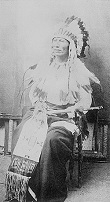

On Sept. 10, 1878 after being ordered to move to Ft. Reno in WC Okla. to be with the Southern Cheyenne while suffering from starvation and measles, the Northern Cheyenne Exodus (ends Apr. 1879) begins as they flee up the North Canadian River in Okla., crossing the Cimarron River before stopping at St. Jacob's Well in Clark County, Kan. before being attacked on Sept. 27 by 238 U.S. infantry and cavalry under Lt. Col. William H. Lewis, who avoid an ambush at Turkey Springs but see Lewis bleed to death from a shot in the leg, while the Cheyenne lose 60 horses and their food and baggage, going out foraging for supplies and capturing 80 cattle on Sept. 30-Oct. 3 while engaging in a running battle across Kan. and Neb. with 10K soldiers and 3K settlers before splitting into two groups after six weeks; on Oct. 23 the 150-member band of Dull Knife (Morning Star) (1810-83) surrenders, reaching Ft. Robinson in NW Neb. on Oct. 25, only to be starved and deprived of wood ordered on Jan. 3, 1879 to return to the Southern Cheyenne Rez, causing them to attempt an escape on Jan. 9, resulting in the Ft. Robinson Massacre of the last 32 escapees on Jan. 22 by 150 soldiers, after which the remaining Cheyenne in Pine Ridge incl. Dull Knife and Red Cloud are permitted to move to Ft. Keogh in SE Mont. on the S bank of the Yellowstone River; meanwhile the other band led by Little Wolf (Coyote) (1820-1904) make it to the Sand Hills of Neb., enjoying plentiful game until they are discovered by troops from Ft. Keogh, who get them to surrender and become Army scouts; in 1884 the 440K-acre Northern Cheyenne Indian Rez is founded in SE Mont.

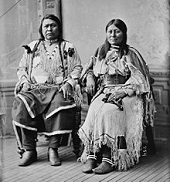
On Sept. 29, 1879 the Meeker Massacre sees Nathanial "Nathan" Cook Meeker (1817-79), whose Union Colony (Greeley, Colo.) venture failed, causing him to go looking for a job, getting an appointment last year as U.S. Indian agent for the White River Ute Reservation (who knew nothing about Indians, pissing them off by trying to force them to give up buffalo hunting and become farmers, and really pissing them off by plowing their horseracing track under and killing some of their horses) killed by the White River Utes under Chief Douglas, who massacre his 10 male employees and capture the women and children and hold them hostage for 23 days until they are released at the intercession of Uncompaghre Ute Chief Ouray ("arrow") (b. 1833) and his wife Chipeta (White Singing Bird) (1843-1924), who sit it out and try to restore peace; meanwhile after a fistfight between Meeker and Ute medicine man Canalla caused him to call out the cavalry a little too late, on Sept. 21 four U.S. Army cos. (175 men) leave Fort Fred Steele near Rawlins in Wyo. Territory under Maj. Thomas Tipton Thornburgh, and on Sept. 29 they are ambushed 20 mi. to the NE at the Battle of Milk Creek on the N border of the rez, and Thornburgh is KIA along with 13 men, and 28 are wounded, losing three-quarters of the horses and mules, after which the troops dig in and send a rider out for reinforcements, holding out for 35 days until 35 black Buffalo Soldiers from Ft. Lewis in S Colo. arrive, electrifying the U.S. with the news of Da Utes, causing another group of 550 reinforcements under Col. David Merritt to leave Ft. Steele and Ft. David A. Russell in Wyo. Territory, defeating the Utes on Oct. 5 before rescuing the 30 starving survivors on Milk Creek on Oct. 8; the town of Meeker, Colo. is founded 17 mi. SW of the site of the massacre; the unrepenting farming-hating Utes hold on to the end of the 1880s before being forced to a new rez in, er, Utah.

In the 1880s the wild cow towns and mining towns in the Am. West (incl. Deadwood, S.D.) begin to tame down as farmers, homeowners, businessmen, and churchgoers start taking over; famed Am. West explorer John Wesley "Wes" Powell (1834-1902) begins lobbying Congress to redraw state boundaries along watersheds and end freewheeling distribution of land to prevent speculation and failed small homesteads.
In 1880 the Oregon Trail is used to drive 200K cattle to the railroad junction of Winnemucca, Nev., which becomes a new Dodge City; about this time cowboys learn to eat the tough beef (they are given the worst cuts) by inventing barbecue (BBQ).
In 1880 the Santa Fe Trial (pioneered in 1821) is supplanted by the Santa Fe Railroad, which also supplants the Camino Real (built 1598) next year when it is extended S from Albuquerque, N.M. through Las Cruces, N.M. (instead of Mesilla, causing it to decline).


In 1880 the town of Winslow, Ariz. (Navajo name Beeshsinil = "iron lying down") 58 mi. E of Flagstaff in the high plateau country of NE Arizona (4,850 ft.) in the Little Colorado River Valley ) (modern-day pop. 10K) is founded as a div. point for the Santa Fe Railway, named after prospector T.L., er, Tom Winslow and/or Augusta, Maine-born U.S. Civil War Union Gen. Edward Francis Winslow (1837-1914), pres. of the St. Louis & San Francisco Railroad, which passes through; it is incorporated in 1900.
On June 28, 1880 after being immortalized in dime novels, Texas Jack Omohundro (b. 1846) dies in Leadville, Colo., after which in 1908 his old friend Buffalo Bill Cody commissions a granite grave marker for him.

The Great American West Legend is pumped-up with the Town Too Tough to Die, not far from, you guessed it, Winslow, Arizona? On Oct. 28, 1880 Crawfordsville, Ind.-born William "Curly Bill" Brocius (Brocious) (1845-82), a member of the Clanton "Cow-Boys" is arrested for the drunken night shooting on Allen St. of Fred White (b. 1849), the first marshal of Tombstone, Ariz., who dies on Oct. 30, news of which is covered in the Tombstone Epitaph, founded on May 1 by "White Chief of the Apaches" John Philip Clum (1851-1932), a former Rutgers U. divinity student, Indian agent, and owner of the Tucson Weekly Citizen to compete with the weekly Tombstone Nugget (founded 1879); when Curly Bill is acquitted because he was merely handing the marshal his gun and it was half-cocked and went off accidentally, and the dying marshal confirmed it, the Earp-Clanton feud reaches a new level; the town has so much violence that Clum deliberately confines it to the column "Death's Doings"; Wyatt Earp from Dodge, Kan., appointed deputy sheriff earlier in the year by his brother and town marshal Virgil Earp gets their other brother Morgan Earp to join them, and they and Wyatt's tuberculitic dentist friend and gambler Doc Holliday begin running the "town too tough to die".

In 1880 Uncompahgre Ute chief Ouray ("arrow") (b. 1833) leads a delegation of Ute chiefs from W Colo. (incl. Chief Ignacio of the Southern Utes, and Woretsiz of the Tabeguache Utes) to Washington, D.C. to testify before Congress about the 1879 Ute Uprising in an attempt to secure a treaty for allowing them all to stay in Colo., meeting with Pres. Hayes, who calls him "the most intellectual man I've ever conversed with", and also with Pres. Grant; too bad, they want them cleared out to make way for white settlers, and the treaty agrees to removal of only the White River and Tabeguache Utes to Uintah Basin in Utah; and on Aug. 24 he dies near the Los Pinos Indian Agency in Colo., after which The Denver Tribune pub. an obituary containing the soundbyte: "In the death of Ouray, one of the historical characters passes away. He has figured for many years as the greatest Indian of his time, and during his life has figured quite prominently. Ouray is in many respects... a remarkable Indian... pure instincts and keen perception. A friend to the white man and protector to the Indians alike", and The Denver Post pub. a eulogy in 1928 containing the soundbyte: "He saw the shadow of doom on his people. He sought peace among tribes and whites, and a fair shake for his people, though Ouray was dealt a sad task of liquidating a once-mighty force that ruled nearly 23 million acres of the Rocky Mountains."


On Mar. 28, 1881 Billy the Kid is transported from Santa Fe, N.M. to Mesilla, N.M. to stand trial on several counts of murder; on Apr. 9 he is found guilty of the murder of Sheriff Brady; on Apr. 13 Judge Warren Bristol sentences him to hang on May 13 in Lincoln, N.M., where he escapes on Apr. 28; the Kid describes the Mesilla jail as the "worst place I ever struck". On July 14 sheriff Patrick Floyd "Pat" Garrett (1850-1908) shoots and kills William H. Bonney Jr. AKA Billy the Kid (Henry McCarty) (b. 1859) in Pete Maxwell's ranch house in Ft. Sumner, N.M. with a .44-.40, "the gun that shot Billy the Kid".
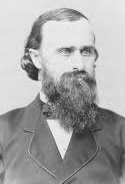
On Aug. 28, 1881 after Congress passes the U.S. Ute Removal Act, reneging on a guarantee of 12M acres in perpetuity, the former Ute Indian Territory is abolished and the Utes removed from their "Shining Mountains" to a rez in E Utah so that the U.S. govt. can open the area to white settlers, incl. Clinton County, Penn.-born George Addison Crawford (1827-91), who next July 22 incorporates the town of Grand Junction, Colo. (AKA River City, Ol' Grandy, Capital of the Western Slope) in Grand Valley on the W slope of the Rockies at the confluence of the Grand (Upper Colorado) and Gunnison Rivers (modern-day pop. 60K/147K), and plants the first vineyard in Colo. near Palisade, after which the area becomes known as the Colo. Wine Country.

In Aug. 1881 a reporter for the New York Sun interviews Dr. W.S. Cockerell in Gunnison, Colo., who spots Quebec, Canada-born Bartholomew William Barclay "Bat" Masterson (1853-1921) and spins a yarn about how he had killed 26 men, which is pub. and reprinted all over the U.S., making Masterson a nat. celeb, even though it was moose hockey; on Apr. 17, 1882 Masterson is appointed city marshal of Trinidad, Colo. at $75/mo., going to Colo. gov. #2 (1879-83) Frederick Walker Pitkin to prevent extradition of Doc Holliday from Colo. to Ariz., losing reelection on Apr. 3, 1883 by a 637-248 vote after the local newspaper lampoons him for dealing faro at night.
In Aug. 1881 Ariz. cattle rancher "Old Man" Newman Haynes Clanton (b. 1816), alleged leader of the "Cow-Boys" and father of the four Clanton brothers is killed with four of his hands in the Guadalupe Canyon Massacre by Mexicans in the S Peloncillo Mts. on the Ariz.-N.M. border in retaliation for a July ambush by rustlers working for them in Skeleton Canyon; Curly Brocius becomes the new leader of the Cow-Boys, wanting to get even with Wyatt Earp for pistol-whipping him during his 1880 arrest for the shooting of prior marshal Fred White.
On Sept. 7, 1881 what's left of the Jesse and Frank James Gang (with some locally-recruited thugs) robs a train at Blue Cut, Jackson County, Mo. (near Glendale, Mo.) (planning it to be their last of 25+ train and stage coach robberies since 1876), killing the conductor and a pensioner, after which Frank James retires from crime and settles in Baltimore, Md.; Jesse's cousin Robert Woodson "Wood" Hite (b. 1856) is killed in Dec.-Mar. in their hideout in Richmond, Mo. by gang members Dick Liddil and/or Bob Ford after an argument over spoils and/or the Fords' widowed sister Martha Bolton, after which Liddil, Bob Ford, and his brother Charley are arrested, causing them to make a deal with new Mo. gov. Thomas Crittenden (whose is embarrassed that his state has been home to the gang for 12 years, and promises to get them in his inaugural address) to obtain a pardon and $5K each (from the railroad and express cos.) for capturing Jesse and Frank James dead or alive - the official cover story - in reality, dead dead dead like bacon?

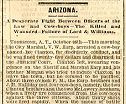




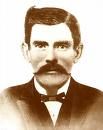







A 30-second point-blank gunfight by bad marksmen fuels zillions of hours of Am. West movie and TV footage? On Oct. 25, 1881 the simmering feud in Tombstone, Ariz. between the Earps and the Clantons reaches critical mass when a bungled stagecoach holdup near Benson, Ariz. in Mar. causes each side to accuse the others of being involved, and braggart Ike Clanton gets drunk and almost gets in a gunfight with them, but backs down, then instead of going back to the ranch stays in the saloon all night in a card game with Virgil Earp and Thomas "Tom" McLaury (b. 1853), then is seen about noon carrying a Winchester rifle and sidearm looking for an Earp or Holliday to plug, then is knocked out, disarmed and taken to the county judge, who fines him $25 for disorderly conduct, causing a courtroom confrontation between the two clans again, after which Wyatt Earp hits Tom McLaury over the head with a pistol, claiming that he is carrying a concealed pistol, which he denies although the saloon keeper of the Capitol Saloon later testifies that he deposits one right afterward; when Tom's older brother Robert Findley "Frank" McLaury (b. 1849) and Ike's younger brother William Harrison "Billy" Clanton (b. 1862) arrive and find out about the beating (that's just too much for an erin go bragh Celt?), they get pissed, load up on ammo and head for the O.K. Corral, which is the way out of town, but also happens to be next to Fly's Rooming House where Doc Holliday is staying, and two blocks from the Earps' home to the W, causing the Earps and Holliday to lock and load and make their big march through the streets to disarm them as officers of the law, although the cowboys are legally entitled to bear arms while entering or leaving the town, as evidenced by being in a, er, corral, causing a legal-poetic-justice ballet that depends on what they think witnesses will later testify to?; on Oct. 26 (Wed.) at 3:00 p.m. (cold day with snow on the ground) the 30-sec. 30-shot Gunfight at the O.K. Corral (18-ft.-wide) on the W end of 4.5K-ft. alt. Tombstone (formerly Goose Flats) in Pima County in SE Ariz. (with a view of the Dragoon Mts. to the NNE), 80 mi. from Tucson (where county sheriff Charles Alexander Shibell (1841-1908) resides) takes place between the sinister darkly-clad handlebar-moustached Earps (Virgil, Wyatt, and Morgan) (the original Morpheus, Neo, and Trinity?) and Doc Holliday (representing the miners, businessmen, bankers and the law) and the Clanton and McLaury "Cow-Boys" (heros of the small farmers and ranchers); after walking down Fremont St. and rounding the corner of Fourth St. in front of the Capitol Saloon, cane-carrying town marshal Virgil Walter Earp (1843-1905) his deputized officer Morgan Earp (1851-82), undeputized Wyatt Earp (1848-1929) (known for the soundbyte "It all ends now"), and TB-suffering gambler-dentist John Henry "Doc" Holliday (1851-87) shoot it out with Joseph Isaac "Ike" Clanton (1847-87) and his gang in the vacant area on the Fremont St. side next to Fly's Rooming House behind the looms of the O.K. Corral; after finding drunken Ike Clanton and his recently-rounded-up wannabe contender William Floyd "Billy the Kid" Claiborne (1860-82) (who likes to pretend he's the real Billy the Kid although he's just a cowhand, and is probably unarmed, as is boasting Ike) standing in the middle of the lot, and well-armed Frank McLaury and Billy Clanton, and probably-unarmed Tom McLaury standing against a house to the W with the horses, Virgil Earp shouts: "Throw your hands up, I want your guns", after which (it depends on whom you believe, but) either Doc Holliday and Morgan Earp start it by opening fire at point-blank range, surprising Wyatt, who is seized by Ike against the rooming house wall, causing his pistol to allegedly accidentally discharge at Billy the Kid Claiborne, striking him in the knee, or Frank McLaury and Billy Clanton draw their pistols first, and Wyatt Earp and Billy Clanton fire first; after Tom McLaury tries to hide behind Billy Clanton's horse, and Frank McLaury shoots Morgan Earp in the shoulder, Doc pulls his concealed sawed-off 10-or-12-gauge double-barreled shotgun from his gray overcoat and fatally shoots Tom McLaury in the right chest near the armpit, after which he stumbles to the W to run away, falls at the telegraph pole at 3rd and Fremont St., and is finished off by a shot to the gut by Wyatt; Frank McLaury is shot by Wyatt Earp in the navel, then stumbles into Freemont St., gets off several shots, loses his horse, and is finished off by Morgan Earp with a head shot; Ike Clanton and Billy Claiborne escape to a nearby photo studio after Ike briefly struggles with Wyatt; death toll: Billy Clanton (shot in the wrist and right chest by Morgan, right arm, scalp and gut by Virgil, and hips by Wyatt) (dies last, claiming he had been murdered), Frank McLaury, Tom McLaury; Wyatt Earp emerges unscathed, but Virgil (right calf), Morgan (upper back between the shoulder blades) and Doc (hip) are badly wounded; Ike, who started it all, and led his brother Billy plus the McLaurys into a death trap, gets out unscathed; the Tombstone Epitaph headline on Oct. 27 reads "Yesterday's Tragedy, Three Men Hurled Into Eternity in the Duration of a Moment, the Causes That Led to the Sad Affair", and contains ed. John Phillip Clum's sage observation: "If the present lesson is not sufficient to teach the cowboy element that they cannot come into the streets of Tombstone, in broad daylight, armed with six-shooters and Henry rifles to hunt down their victims, then the citizens will most assuredly take such steps to preserve the peace as will be forever a bar to further raids"; on Nov. 29 after the hero shine wears off and talk of the unarmed innocent lambs throwing up their hands and being murdered in cold blood, and the boss, Cochise County Sheriff Johnny H. Behan (1844-1912) (a friend of the Clantons, who was at the all-night card game and arose at 1:30 p.m., got a shave at the barber shop, then encountered the Earps going to the corral and let them pass) arrests Wyatt Earp and Doc Holliday for murder, a mo.-long legal inquest by Judge Wells W. Spicer (1831-85) (a relative of the Earps) clears them using a Wild West version of the old doing-their-official-duty theory; the pro-Clanton locals and the Earps go on to circulate different stories, which clouds the episode, making it take half a cent. to reach full Wild West legend status; Spicer's rep is ruined by his decision, and after death threats by the Cow-Boys he ends up a miner, and is found dead in the desert near Ajo, Ariz. in 1885; Clum leaves Tombstone on May 1, 1882, and ends up working in the post office in Alaska, finally running a date farm in Indio, Calif. in 1915, where he stays friends with Wyatt in Los Angeles; Wyatt leaves Tombstone by the end of the year, hooks up with Josephine Sarah "Josie" Marcus (1861-1944) (ex-babe of his arch-enemy Johnny Behan) in San Francisco next year, and becomes a prospector, then operates saloons and gambling halls in the gold camps of Nevada and Alaska, then goes into real estate speculation in Calif. before WWI, and owns a racetrack; he goes to his grave an old fart, never having suffered a direct hit; Billy the Kid Claiborne gets his chance to prove he's no Billy the Kid, and is killed next Nov. 14 in a gunfight with Franklin "Buckskin Frank" Leslie (1848-1930), "the only man who could compare to Doc Holliday's blinding speed and accuracy with a six-gun" (Wyatt Earp) - whose portrait bears a striking resemblance to Hollywood actor Brad Pitt (1963-)?
In 1881 after barbed wire is patented in 1874, the Fence Cutting Wars (end 1891) break out in Tex. as homesteaders begin cutting the barbed wire fences of cattlemen, initially being justified because the fences were put up by men who didn't own the land, but later doing it to anybody's fences, claiming that all land should be in the public domain, speading to Wyo. and Mont.




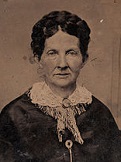







A dirty little coward provides the laundry booster for the legend of Mister Clean Jesse James? On Apr. 3, 1882 (Mon.) (22 years to the day after the Pony Express began there) while planning to rob the Platte City Bank, Mo., aging, married-with-kids living legend outlaw (son of a Baptist preacher) Jesse Woodson James (b. 1847) (whose portrait bears a striking resemblance to actor Kevin Norwood Bacon (1958-)?), living under the name of Tom Howard is assassinated in his house on Lafayette St. in St. Joseph, Mo. (shot in the back of the head as he stands on a chair to adjust a picture above the mantle) by gang member Robert Newton "Bob" Ford (1862-92) (whose portrait bears a striking resemblance to actor Leonardo DiCaprio (1974-)?) after he outdraws his brother Charles Wilson "Charley" "Charlie" Ford (1857-84), killing him with a gun Jesse gave to him as a gift, then telling the shocked widow he didn't do it or it was an accident; he later claims that Jesse just learned in the newspaper of the arrest three weeks earlier of former gang member Dick Liddil and connected it with them, then laid his guns down supposedly to avoid being spotted by neighbors, but really to throw the Fords off guard that he planned to kill them that night out of the presence of his wife and kids; after rushing to the telegraph office to claim the reward, then being arrested, pleading guilty and being convicted of murder and sentenced to hang, the Ford brothers are pardoned in two hours by Mo. gov. (1881-5) Thomas Theodore Crittenden (1832-1909) and given only a portion of their $5K reward (causing rumors that he had planned the murder with them), after which they tour the U.S. restaging the murder 800X (Bob can act, Charley can't?) (Bob's face becoming more recognizable than the president's?) after which Charley (who disputes his brother's protestations that he isn't a coward, falls out with him, and becomes wracked with guilt?) commits suicide on May 6, 1884, while Bob ends up being called a "dirty little coward" and widely hated, and Jesse becomes the American Robin Hood, after which drunken Bob is finally killed by a sawed-off shotgun in his saloon in Creede, Colo. on June 8, 1892; Jesse leaves widow (and 1st cousin) Zerelda Amanda "Zee" James (nee Mimms) (1845-1900) and two children, Jesse Edward and Mary James; Jesse's mother Zerelda denounces Dick Liddil at the coroner's inquest, accusing him of cooperating with Mo. authorities, and he later turns state's witness against Frank James; the cottage and the bullet hole in the wall become a tourist attraction; two days earlier Jesse attempted to change a $100 bill at the downtown Mo. State Bank, the oldest bank W of the Mississippi, possibly to case it for a heist; from 1875-1900 St. Jo, where East-West trade converged is one of the wealthiest cities in the U.S.; on Oct. 4 Frank James surrenders to Crittenden on condition of not being extradited to Northfield, Minn., and is tried in Gallatin, Mo. in July 1883 for the murder of stone mason Frank McMillan during a July 15, 1881 Rock Island Line train robbery near Winston; his Confederate cmdr. Gen. Joseph O. Shelby testifies in his defense drunk, and comes back the next day to apologize; on Sept. 6 after three days of summary arguments the jury returns a not guilty verdict in four hours; in Apr. 1884 he is acquitted by another jury in Huntsville, Ala. for the Mar. 11, 1881 robbery of a U.S. Army Corps of Engineers payroll at Muscle Shoals, Ala., and Frank becomes the only member of the James-Younger Gang to obtain an acquittal, going on to live to a ripe old age as a law-abiding citizen.
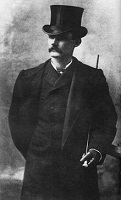
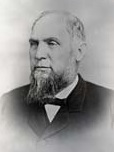

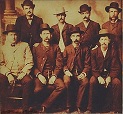
On Apr. 28-June 7, 1883 the bloodless Dodge City War sees Lawrence E. Deger, new (since Apr. 3) mayor of Dodge City, Kan. get tired of vice and vagrancy and attempt to force Polk County, Ark.-born owner Luke L. Short (1854-93) (a notorious gunfighter and friend of Wyatt Earp and Bat Masterson) to close the Long Branch Saloon, running him out of town on Apr. 30, causing him to present a petition on May 10 to Dem. Kan. gov. #9 (1883-5) George Washington Glick (1827-1911) in Topeka, Kan. then hook up with Earp and Masterson and return with them to Dodge City on May 31, after which on June 9 (night) after the Santa Fe Railroad chimes in about not wanting to lose business during the cattle season, both sides resolve their differences, and on June 10 the Dodge City Peace Commission poses for a photo that becomes famous, after which Earp and Masterson board a train for Colo. and Short sells-out to Roy Drake and Frank Warren on Nov. 19 and moves to Fort Worth, Tex. via San Antonio, opening the White Elephant Saloon, going on to kill town marshal Timothy Isaiah "Jim" Courtright in a gunfight on Feb. 8, 1887 after selling his interest in the saloon to pay his legal costs incurred after shooting Charles T. Schuyler in the back on Jan. 23 in San Angelo, Tex.



On May 19, 1883 after staging his first Wild West show the "Old Glory Blowout" last July 4 in North Platte, Neb., the Buffalo Bill's Wild West [Show] of "the Colonel", Le Claire, Iowa-born William Frederick "Buffalo Bill" Cody (1846-1917) opens in Omaha, Neb., starring him as the headline act for the next 34 years, also starring Sitting Bull, Calamity Jane, Annie Oakley and Frank Butler, Gabriel Dumont, and Lillian Smith, during which time he rides 11 different horses and tours Europe 8x; in 1893 he changes the name to Buffalo Bill's Wild West and Congress of Rough Riders of the World.

On Mar. 27, 1886 U.S. Army Gen. George Crook and Chiricahua Apache leader (medicine man not chief) Geronimo ("he who yawns") (1829-1909) negotiate a peace treaty in the Canyon de los Embudos (Funnels) in the Sierre Madre Mts. near Sonoro, Mexico, whereby the Apaches agree to surrender and be returned to the San Carlos Rez in Ariz.; that night a Swiss-Am. bootlegger sells them a large quantity of booze, causing Geronimo and 20 drunk warriors to repudiate the treaty and steal away during the night; Geronimo is tracked down, and surrenders on Sept. 4 to U.S. Gen. Nelson A. Miles in Skeleton Canyon, Ariz., and is then sent with other warriors to Ft. Pickens, Fla., where he becomes America's first tourist attraction; meanwhile his family is sent to Ft. Marion (until 1887).

In 1886 Quebec, Canada-born famed gunslinger-lawman-gambler Bartholomew William Barclay "Bat" Masterson (1853-1921) leaves Dodge City, Kan. and settles in Denver, Colo., dealing faro for Big Ed Chase at the Arcade gambling house and going on to purchase the Palace Variety Theater in 1888, marrying Indian singer Emma Moulton on Nov. 21, 1893 after getting involved in a ballot stuffing scandal with Soapy Smith in 1889 after acting as timekeeper for the heavyweight championship between John L. Sullivan and Jake Kilrain in Richburg, Miss. on July 8, 1889; in 1892 he moves to Creede, Colo., losing his Denver Exchange gambling club to a fire on June 5, 1892 and attending the heavyweight championship fight between John L. Sullivan and James J. Corbett in New Orleans, La. on Sept. 7, 1892; on Jan. 24, 1894 he acts as a second for Charlie Mitchell during his heavyweight boxing fight with James J. Corbett in Jacksonville, Fla., seeing his man Mitchell KOd in three rounds; in 1895 he moves to New York City, becoming a bodyguard for millionaire George Gould and leading a cushy life; on Apr. 6, 1897 after becoming a deputy sheriff in Arapahoe County, Colo. he gets into an election-day dispute with Tim Connors, resulting in a scuffle that accidentally shoots C.C. Louderbaugh in the left wrist; on Apr. 9, 1899 he becomes a partner in the Colo. Athletic Assoc. boxing club, only to be expelled by his partners and set up the rival Olympic Athletic Club boxing club on Apr. 18, ending up leaving Denver for New York City in 1902, getting arrested on June 6 along with two other men for fleecing Mormon elder George H. Snow out of $17K, and again on June 15 for carrying a concealed weapon; in 1903 he begins writing the column "Masterson's Views on Timely Topics" for the New York Morning Telegraph, ed. by Alfred Henry Lewis, who in 1905 pub. The Sunset Trail, a fictionalized bio. of Masterson; in Jan 1905 after Lewis introduces him to Pres. Theodore Roosevelt, he is appointed deputy U.S. marshal for the Southern District of New York for $2K/year, becoming one of Roosevelt's White House Gunfighters along with Pat Garrett and Ben Daniels losing the job on Aug. 1, 1909 after new Pres. William Taft fires him; in 1907 he pub. bios. of Ben Thompson, Wyatt Earp, Luke Short, Doc Holliday, and Bill Tighman for Human Life mag., following with a last one on Buffalo Bill; he then begins traveling around the U.S. covering boxing matches for the New York Morning Telegraph, incl. the heavyweight bout between Jack Johnson and Jess Willard in Havana Cuba on Apr. 5, 1915; on July 2, 1921 Masterson attends his last heavyweight championship fight, the Million Dollar Gate, a defense of his title by Jack Dempsey promoted by his friend George "Tex" Rickard; on Oct. 7, 1921 silent film cowboy star William S. Hart visits him on the roof of the New York Telegraph bldg. before dying at his desk on Oct. 25 of a massive heart attack, his funeral service attended by 500 and honorary pallbearers incl. Lewis, Rickard, and Damon Runyon, who utters the eulogy: "He was a 100 percent, 22-karat real man. Bat was a good hater and a wonderful friend. He was always stretching out his hand to some down-and-outer. He had a great sense of humor and a marvelous fund of reminiscence, and was one of the most entertaining companions we have ever known. There are only too few men in the world like Bat Masterson and his death is a genuine loss."
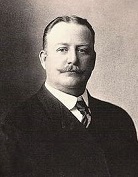

In 1886 Canton, N.Y.-born Western artist Frederic Sackrider Remington (1861-1909) is sent to Ariz. by Harper's Weekly to cover the govt. war against Geronimo, making photos and sketches for use in his work. In 1890 he holds his first 1-man show of 21 paintings at the Am. Art Galleries, making him a celeb. In 1895 he sculpts the bronz sculpture The Bucking Broncho (Bronco); in 2014 the Denver Art Museum loses its bet over the outcome of the Denver Broncos-Seattle Seahawks Super Bowl and has to loan the sculpture to the Seattle Art Museum for 3 mo.
In May 1887 Geronimo is reunited with his family and transferred to Mt. Vernon Barracks in Ala. (until 1892).

On Feb. 3, 1889 Am. outlaw Belle Starr (b. 1848) is killed in an ambush in Briartown, Okla.; 9 mo. for horse theft is her only criminal record? In 1889 Richard K. Fox pub. Belle Starr, the Bandit Queen, or the Female Jesse James, a dime novel pub. in the year of her death, making her a posth. celeb.
On Mar. 2, 1889 outgoing Pres. Cleveland signs the 1889 U.S. Indian Appropriations Act, officially opening the Unassigned Lands to white settlers under the U.S. Homestead Act, with the Sooner Clause denying rights to land claimed by those who enter illegally; later in the year an amendment is signed by new Pres. Benjamin Harrison, relaxing some rules.

On Apr. 22, 1889 (noon) the Oklahoma Land Rush (Run) ("Hoss Race") begins, opening the vacated Indian territory of Oklahoma to 50K eager "sooner" white settlers (Tom Cruise and Nicole Kidman?) waiting at the borders to claim 2M acres of land divided into 160-acre homesteads, while what's left of the Injuns go bonkers; Nannita Regina H. "Kentucky" Daisey (1855-) becomes the first person to claim a homestead tract; Guthrie City (new capital) (founded Apr. 22) and Oklahoma City (OKC) (founded Apr. 22) (modern pop 630K/1.46M) swell with Sooners, with the pop. of Guthrie and OKC starting at 10K, and OKC passing Guthrie up and becoming the state capital in 1910, causing the Okla. State Capitol to be built in 1914-17, becoming the only one in the U.S. with active oil rigs; the dome isn't completed until 2002 - everybody talks about how tough their truck is?

On June 14, 1889 the Wild Bunch Gang of Robert Le Roy Parker (AKA Butch Cassidy) (1866-1908), incl. Harry Alonzo Longabaugh (AKA the Sundance Kid) (1867-1908), Tom McCarty and his brother-in-law Matt Warner rob the San Miguel Valley Bank in Telluride, Colo of $20K, then hole-up in Robbers Roost in SE Utah, launching the legendary career of Paul Newman and Robert Redford, er, Butch Cassidy and the Sundance Kid. On Apr. 22, 1897 the Wild Bunch Gang of Butch Cassidy (Robert Leroy Parker) (1866-1908), incl. Harry Alonzo "the Sundance Kid" Longabaugh (1867-1908), Ben "The Tall Texan" Kilpatrick (1874-1912), George Sutherland "Big Nose" "Flat Nose" Curry (1864-1900), Harvey Alexander "Kid Curry" Logan (1867-1904), and William Ellsworth "Elzy" Lay (1868-1934) ambush workers carrying the payroll of the Pleasant Valley Coal Co. in Castle Gate, Utah, stealing 7K in gold and hiding out in Robbers Roost and laying low until June 1899, while Lay's wife Maude Davis gives birth to daughter Marvel Lay Murdock (1897-), and the gang allegedly considers enlisting in the U.S. Army to fight in the Spanish-Am. War as the "Wild Bunch Riders". On June 2, 1899 the 11-member Wild Bunch Gang rob a Union Pacific Overland Flyer 1 mi. W of Wilcox, Wyo., using too much dynamite on the safe and ending up with only $3.4K in tattered bank notes, although it is reported as $30K, causing a combined $3K reward to be offered by the railroad and the U.S. govt, resulting in a massive manhunt and shootout during which on June 5 a posse corners them on the Powder River, and Kid Curry and George Curry kill sheriff Josiah "Joe" Hazen and escape, causing the gang to become infamous; on July 11, 1899 members of the Ketchum Gang, led by Thomas Everard "Black Jack" Ketchum (1863-1901), his brother Samuel W. "Sam" Ketchum (1854-99), Will Carver (1868-1901) (who uses the alias G.W. Franks) and his half-German half-Indian gang moll Laura "Della Rose" Bullion (1876-1961), and her step-brother Edwin H. "Shoot 'Em Up Dick" Cullen (1872-97) hold up a Colo. and Southern train near Folsom, N.M., and once again blow up the safe to find little cash; on Dec. 9 (eve.) they attempt to hold up a Southern Pacific train near Stevins Pass, N.M., but Cullen is killed and the robbery foiled; this time the posse, led by deputy U.S. marshal Wilson "Memphis" Elliott does better and corners them in Turkey Creek Canyon near Cimarron, N.M., and after a long gunfight a sheriff and a posseman are killed, and Ketchum is shot in the leg, later dying of blood poisoning, while Lay is wounded and captured; on Aug. 16 Black Jack Ketchum tries to rob another train alone in Folsom, N.M., and is wounded and captured, then hanged on Apr. 26, 1901 in Clayton, N.M., his head coming off; Lay is given life for 2nd degree murder, has his sentence is commuted to 10 years, and is released in 1905; Will Carver gets away; eventually all 11 members are killed in gun battles with lawmen.

On July 12, 1893 Portage, Wisc.-born U. of Wisc. historian Frederick Jackson Turner (1861-1932) reads his thesis The Significance of the Frontier in American History to the Am. Historical Assoc. at the Chicago World's Fair, proposing the Frontier Thesis of Am. History, overturning the theory of Theodore Roosevelt that battles between trans-Appalachian pioneers and Indians forged the American race, claiming that the ever-expanding frontier shaped the Am. character and destiny, making the U.S. the unique democracy it is today, with the unlimited acreage of land free for the taking as long as Nature, wild Indians, Mexicans, etc. could be tamed, along with freedom from European nobility, church hierarchies, and landed gentry creating a people known for egalitarianism, lack of interest in high culture, and violence, as depicted in zillions of Hollywood Westerns, "breaking the bonds of custom, offering new experiences, calling out new institutions and activities", and creating a new type of citizen (if not race?), the racial-religious-cultural undertones only serving to spice it up?; after it is pub. and distributed, it takes Am. historians by storm, becoming an accepted theory by scholars until recent times when the PC police move in nibble at the fringes, criticizing its lack of mention of the role of women, waves of new immigrants and big cities on the frontier, etc.; "American democracy was born of no theorist's dream; it was not carried in the Susan Constant to Virginia, nor in the Mayflower to Plymouth. It came out of the American forest, and it gained new strength each time it touched a new frontier"; in the 1990s the Internet and World Wide attempt to extend the Great Am. Frontier to the entire world electronically? In 1910 he moves to Harvard U., teaching a gen. of students who take over Am. academia before leaving in 1922 to study at the Huntington Library in Los Angeles, Calif.; too bad, Turner never pub. a major book on the Frontier Thesis despite 40 years of research. In 1932 he pub. The Significance of Sections in American History (Pulitzer Prize).
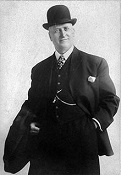

In 1893 Waymart, Penn.-born James Joseph "J.J." Brown (1854-1922) of the Ibex Mining Co. discovers a substanial ore seam at the Little Jonny Mine in Leadville, Colo., which by Oct. 29 is shipping 135 tons of gold ore a day, making it known as the world's richest gold strike, and is rewarded with 12.5K shares of stock and a seat on the board, making him super-wealthy, along with his Hannibal, Mo.-born wife (since Sept. 1, 1886) Margaret "Maggie" "Molly" Brown (nee Tobin) (1867-1932), moving into a $30K Victorian mansion on Pennsylvania St. in the Capitol Hill neighborhood of Denver, Colo. next year, and building a summer house in 1897 in SW Denver near Bear Creek called Avoca Lodge, allowing her to climb Denver's society ladder; they separate in 1909, leaving her $238K, after which she raises funds for the Cathedral of the Immaculate Conception in Denver (1911), and helps establish the first juvenile court in the U.S.; after traveling in Egypt with millionaire John Jacob Astor IV, she becomes famous after surviving the RMS Titanic Disaster on Apr. 15, 1912 on Lifeboat No. 6, and talking the sailors into going back to pick up survivors with the help of an oar, becoming known as "the Unsinkable Molly Brown", going on to promote the rights of workers and women, education of children, historic preservation, and wounded French and Am. soldiers in WWI before dying of a brain tumor on Oct. 26, 1932 at the Barbizon Hotel in New York City; a 1960 Broadway musical and 1964 film titled "The Unsinkable Molly Brown" preserve her fame to modern times.
In July 1897 the first 10-day Cheyenne Frontier Days rodeo and Am. West celebration is held in Cheyenne, Wyo., going on to bill itself as "the world's largest outdoor rodeo and Western celebration"; by 2000 the 200K visitors gobble up 100K pancakes and 1.5 tons of ham, and 1.8K prof. rodeo stars vie for the $1M grand prize.

On July 3, 1901 Butch Cassidy (Robert Leroy Parker) (1866-1908) and the Sundance Kid (Harry Longabaugh) (1867-1908) and their Wild Bunch gang rob the Great Northern Coast Flyer near Wagner, Mont., split up the $65K take, then head for Argentina - I'd like to fly like Superman?
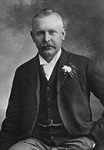
On Feb. 15, 1902 British inventor Daniel "Dan" Albone (1860-1906) files a patent for the first commercially successful gasoline-powered farm tractor, forming Ivel Agricultural Motors Ltd. and selling them for £300 and building 500; in 1903 Charles W. Hart and Charles H. Parr begin marketing a 2-cylinder gasoline engine tractor in Charles City, Iowa, dooming the 20M horses and mules on U.S. farms to obsolescence over the next 20 years.

In 1902 Philly-born Owen Wister (1860-1938) pub. the bestseller The Virginian: A Horseman of the Plains, about a cattle ranch in Wyo., becoming the first Western novel; filmed in 1914, 1923, 1929, 1946, 2000, and 2014, and made into a TV series in 1962-71. In 1903 he pub. Philosophy 4, about his college days at Harvard U. In 1906 he pub. Lady Baltimore.

On Nov. 20, 1903 42-y.-o. Mo.-born hired gunman and stock dick Tom Horn (b. 1860) is hanged in Cheyenne, Wyo. for the 1901 murder of 14-y.-o. Willie Nickell based on a controversial confession.
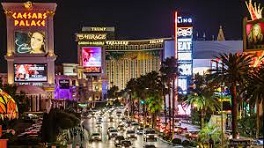
A giant grid with a city on top that shakes all the money out of people's pockets and funnels it to the lucky casino owners down below? On May 15, 1905 after 110 dusty acres in the Mojave Desert near the Union Pacific Railroad tracks are auctioned off, the city of Las Vegas, Nev. (Sp. "las vegas" = the meadows) (modern-day pop. 630K/2.4M) is founded; it is incorporated on Mar. 16, 1911; in 1931 Nev. legalizes casino gambling and reduces residency requirements for divorce to 6 weeks; in 1935 nearby Hoover Dam is completed; on Apr. 3, 1941 the Pair-o-Dice Club becomes the first casino built on the Las Vegas Strip (named after the Sunset Strip in Los Angeles), attracting New York City mobsters incl. Bugsy Siegel, who opens The Flamingo in 1946, causing the city to become known as "Sin City", "the City of Lights", and "The Gambling Capital of the World", going on to invite top entertainers incl. Wayne Newton, Dean Martin, Sammy Davis Jr., and Elvis Presley to perform, causing it to become known as "the Entertainment Capital of the World", combining it with quickie marriages, making it "the Marriage Capital of the World"; in 1955 the famous Welcome to Las Vegas Sign is located outside the city by Betty Willis; the mobsters later bow to corporate-funded mega-resorts, starting with The Mirage in 1989, making it "The Silver City", and "America's Playground"; in 1959 the Fremont Street Experience opens in a 5-block area of downtown known as Glitter Gulch, featuring 12.5M lights and 500MW shows held each hour from dusk until midnight; the town's ad slogan is: "What happens in Vegas stays in Vegas".
On Jan. 29-Feb. 3, 1906 the first annual Nat. Western Stock Show is held in the cow town of Denver, Colo. by the new Western Stock Show Assoc., devoted to "unabashed bovine boosterism" (Thomas J. Noel); attendance is 15K; the Grand Champion steer sells for 33 cents/lb. (23 cents over market price); it becomes so important to the city's economy that the elaborate Christmas lights on the Denver City and County Bldg. are left on for it.

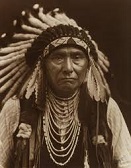
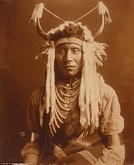
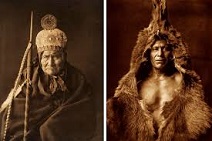
In 1906 Whitewater, Wisc.-born Seattle, Wash. society photographer Edward Sheriff Curtis (1868-1930) abandons his career to begin photographing the vanishing Am. Indians, spending 30 years photographing 80 tribes W of the Mississippi River and compiling a 20-vol. 20-portfolio set of 2.2K photos and 4K pages of text, backed by Pres. Theodore Roosevelt and partially funded by J.P. Morgan, but ending up going bankrupt as the public wants to forget the Indians and content themselves with the buffalo nickel (1913)?

In 1907 Streator, Ill.-born Clarence Edward Mulford (1883-1956) pub. Hopalong Cassidy: Bar 20, which introduces wooden-legged sarsaparilla-drinking Bill "Hopalong" "Hoppy" Cassidy (clad in black incl. his hat), his white horse Topper, and his sidekick Windy Halliday, who rescue damsels in distress et al. in the Wild West; first of a series of 28 (ends 1941); turned into a 66-film movie series starring William Boyd in 1935 (ends 1948).


On Oct. 1, 1908 the Ford Motor Co. of Henry Ford (1863-1947) begins producing the epoch-making Model T Ford (Leaping Lena) (Flivver) (Tin Lizzie, named for a reliable servant) in Dearborn, Mich. (until May 27, 1927), becoming the first affordable automobile, causing them to come rapidly into use by the masses; for $825 you get 20 hp, top speed of 45 mph, and gas economy of 13-21 mpg, with the ability to run on gasoline, kerosene, or ethanol; a trembler coil system replaces expensive magnetos, but requires a starting battery and AC alternator; it sells 10.6K units the first year, with Henry Ford writing the soundbyte in 1909: "Any customer can have a car painted any color that he wants so long as it is black", although they come in grey, green, blue, and red until 1912, then midnight blue with black fenders, finally black-only in 1914, with 30 different types of black paint used; the Model T doubles as a tractor and portable engine for farm use; mass-production lowers the price to $300 by 1926, and 15M are eventually sold; long-distance transportation of passengers and goods are not done by road until 1914; the days of horses and buggies come to a quick end, transforming the entire U.S. On Jan. 14, 1915 after viewing newsreels of people butchering people on an assembly-line basis in Europe, Henry Ford (1863-1947) develops the Assembly Line Method of producing automobiles, using a chain to pull each chassis along at his new Highland Park Ford Plant near Detroit, Mich., known as the Crystal Palace, which becomes the first to use a moving (conveyor belt) assembly line, reducing the time needed to produce a Model T from 1.5 days to 93 min. (sensationalized as "one a minute"), achieving an output of 1K cars a day; on Jan. 5 Ford announces the new 40-hour workweek at a pay of $5 per day, up from $2.34; with Thomas Edison's help he creates the first charcoal Barbecue (BBQ) Briquettes using wood scraps and sawdust from his Model T factory.
On Nov. 7, 1908 Butch Cassidy (b. 1866) and the Sundance Kid (b. 1867) are cornered and killed by the Bolivian Army in the village of San Vicente.
In 1908 N. Howard "Jack" Thorp pub. Songs of the Cowboys, the first book of Western music, incl. Little Joe, the Wrangler.
On Feb. 17, 1909 Mexican-born Am. Apache Indian leader Geronimo (b. 1829) dies in Ft. Sill, Okla. of pneumonia, and is buried at the Apache Indian POW Cemetery; in 1918 his remains (skull and bones) plus his prized silver bridle are stolen by three members of the Yale U. Skull & Bones Society, who are serving as Army volunteers at Ft. Sill, and used in their secret rituals; in 2006 a June 7, 1918 letter is pub. in the "Yale Alumni Mag.", by member Winter Mead, admitting the crime, causing Geronimo's great-grandson Harlyn Geronimo of Mescalero, N.M. to write Pres. George W. Bush requesting their return, but after investigation the story proves a hoax.



On Oct. 21, 1909 Francis W. Boggs' and Otis Turner's The Cowboy Millionaire (IMP) debuts, starring Mac Barnes, becoming the film debut of Mix Run, Penn.-born Thomas Edwin (Hezikiah) "Tom" Mix (1880-1940), who makes 336 films between 1910-36, shooting about 40 films in Canon (Cañon) City, Colo. with the Selig Polyscope Co. in 1911-12; in 1917 his sorrel Tony the Wonder Horse (1899-1942), debuts in "The Heart of Texas Ryan"; also the film debut of Springfield, Mo.-born William Davis Garwood Jr. (1884-1950), who goes on to star in 150 films; also the film debut of Boston, Mass.-born William Stowell (1885-1919).

In 1910 Goodman, Miss.-born John Avery Lomax (1867-1948) pub. Cowboy Songs and Other Frontier Ballads, which gives Western music a nat. audience; it incl. Streets of Laredo; in 1919 he follows it with Songs of the Cattle Trail and Cow Camp.

In 1910 Zanesville, Ohio-born former dentist Zane Grey (1872-1939) pub. Heritage of the Desert. In 1912 he pub. Riders of the Purple Sage - sounds good enough to eat? In 1920 he pub. the bestseller The Man of the Forest. In 1925 he pub. The Vanishing American, about Indian male Nophaie ("warrior") (Lo Blandy) and white female Marian Warner, who fall in love on his SW Am. Rez; "It is infinitely easier for an Indian to love a white woman than for her to love him. I don't know why"; also The Thundering Herd.
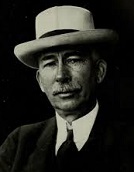
In 1911 Houston, Tex.-born Col. Edward Mandell House (Huis) (1858-1938) pub. Philip Dru, Administrator; a demagogue leads the Wild West against the plutocratic East, becomes dictator of the U.S., imposes the Bull Moose Platform of 1912, then vanishes.
On Jan. 6, 1912 New Mexico (N.M.) becomes the 47th U.S. state; meanwhile rumors of a new film called The Gentleman from New Mexico circulate.
On Feb. 14, 1912 "Grand Canyon State" Arizona ("little spring place" in Pima, or "silver-bearing" in Aztec) is admitted as the 48th U.S. state, the last on the mainland, closing the Am. Frontier - that spells Arizona Tea in two ways?

In 1912 39-y.-o. Winchester, Va.-born Red Cloud, Neb.-raised Willa (Wilella) Silbert Cather (1873-1947) takes a leave of absence from "White Man's Burden" McClure's mag. to write novels, leaves New York City to visit her childhood home of Red Cloud, Neb., finds it changed, then goes on to visit Winslow, Ariz. and other places in Ariz. and New Mexico, then returns to New York City and moves in with Edith Lewis (1882-1972) at 5 Bank St., staying with her for 35 years. In 1912 she pub. her first novel Alexander's Bridge, which is a flop. In 1913 she pub. O Pioneers!, which is a hit; title taken from Walt Whitman; Red Cloud, Neb. becomes Hanover. In 1918 she pub. My Antonia; "Here's Jim's story"; based on the true story of Annie Pavelika (Sadilek), who moves with her family from Bohemia to Nebraska in 1880 and lives through a miserable winter in a dugout. In 1922 she pub. One Of Ours, which is a critical failure, Hemingway claiming she got her WWI scenes from movies, but it becomes her first bestseller and wins a Pulitzer Prize. In 1925 she pub. The Professor's House; Prof. Godfrey St. Peter writes eight historical novels, then realizes his life's purpose is over and makes peace with death. In 1927 she pub. Death Comes for the Archbishop; based on French Roman Catholic archbishop (1875-88) Jean-Baptiste Lamy (1814-88) of Santa Fe, who arrived in 1851; his Indian guide is Jacinto; Father Martinez of Taos is the bad guy. In 1931 she pub. Shadows on the Rock, about 17th cent. Quebec in the time of bishop Francois Xavier de Laval-Montmorency.

In 1913 San Francisco, Calif.-born Peter B. Kyne (1880-1957) pub. his first novel The Three Godfathers; three Wild West bank robbers adopt a newborn child; filmed in 1936 and 1948.


On Jan. 10, 1917 Le Claire, Iowa-born showman William Frederick "Buffalo Bill" Cody (b. 1846) dies in Denver, Colo. of kidney failure at his sister's house one day after being baptized into the Roman Catholic Church by Father Christopher Walsh of Denver Cathedral; tributes are made by George V, Kaiser Wilhelm II, and Pres. Wilson; Wyo Gov. John B. Kendrick leads the funeral procession; leaves a $100K fortune; he is buried on June 3 on Lookout Mountain in Golden, Colo. overlooking Denver from the W 12 mi. away; in 1921 Johnny Baker (-1931) opens the Buffalo Bill Memorial Museum, which ends up being owned by the city and county of Denver, attracting 400K visitors/year; the tradition arises that throwing a bobby pin over his grave assures a trip to the altar: "Every Indian outbreak that I have ever known has resulted from broken promises and broken treaties by the government"; "What we want to do is give women even more liberty than they have. Let them do any kind of work they see fit, and if they do it as well as men, give them the same pay."

On Feb. 11, 1917 The Gunfighter, produced by Thomas H. Ince, debuts, making Newburgh, N.Y.-born actor-dir. William Surrey Hart (1864-1946) (a silent film actor since 1914, usually billed as "William S. Hart") a cowboy hero, starring in 27 films in 1917-24, each of which grosses $500K+.
In the 1920s jazz-influenced Western Swing originates in small towns in Tex., Okla., and Calif., influenced by Dixieland jazz, featuring the steel guitar and an up-tempo dance beat.

The dirtier the laundry, the longer it takes to launder? The Earp legend is a long time in coming? On Mar. 12, 1922 the Los Angeles Times pub. the story Lurid Trails Left By Older-Day Bandits, claiming that the "Earp Gang" started the Oct. 26, 1881 O.K. Corral Gunfight "when four cowboys refused to recognize the right of the Earp gang to rule the town", and "the Earps ordered the cowboys out of town and they were preparing to leave when they were waylaid and a gun battle followed", causing Wyatt Berry Stapp Earp (1848-1929) and his wife Josie Marcus to go nonlinear and write to silent film cowboy actor William S. Hart to vindicate them with a film, which he tries but fails to make; meanwhile Earp gets his secy. John H. Flood Jr. to write his bio., but the style is so stilted that every publisher rejects it, then in 1928 he hires San Diego, Calif. writer Stuart N. Lake, who writes Wyatt Earp, Frontier Marshal, which is pub. in 1931, two years after Earp's death; Josie then pub. I Married Wyatt Earp; Earp's own self-glorifying version of the O.K. Corral gunfight, Wyatt Earp by Wyatt S. Earp is not pub. until 1981 - by then it's too late, Star Trek took it over?

On June 2, 1924 the Pres. Coolidge signs the U.S. Indian Citizenship (Snyder) Act, sponsored by lily white U.S. Rep. (R-N.Y.) (1915-25) Homer Peter Snyder (1863-1937), granting U.S. citizenship to all "domestic dependent nations", i.e. Amerindians - that's mighty white of you palefaces who stole my country?

On Dec. 27, 1925 King Baggot's Tumbleweeds (United Artists) debuts, produced by and starring William S. Hart as drifter (tumbleweed) Don Carver, depicting the 1893 Okla. Cherokee Strip Land Rush, influencing the 1931 film "Cimarron"; co-stars Barbara Bedford as Carver's babe Molly Lassiter.

In May 1926 after playing some of the first cowboy music on U.S. radio, Ripley, Okla.-based Otto Gray (1884-1967) and His Oklahoma Cowboys ("Daddy of the Cowboy Bands") (formed in 1921 from real cowboys), incl. Billy McGinty, David "Pistol Pete" Cutrell, Johnny Bennett, Ernest Bevins, and Benjamin Francis "Whitey" Ford "the Duke of Paducah" release their first single Cow Boy's Dream (OKeh Records), followed by Pistol Pete's Midnight Special (May 1926), Bury Me on Not the Lone Prairie (Jan. 1928) (Gennett Records), Born About 4,000 Years Ago (Feb. 1931) (Melotone Records), and Mammy's Little Coal Black Rose (Feb. 1931) (Melotone Records). On June 6, 1931 they appear on the cover of Billboard, becoming the first country-western band on their cover.
In May 1927 Studio City (originally Laurelwood) is founded in the San Fernando Valley near Los Angeles, Calif. on a triangular lot bisected by the Los Angeles River by film producer Mack Sennett; in 1933 he declares bankruptcy and sells it to Mascot Pictures, which in 1935 merges with Monogram Pictures and Consolidated Film Corp. to form Republic Pictures, becoming Republic Studios, producing B-Westerns starring Gene Autry, Roy Rogers, John Wayne et al.; in the 1950s Republic leases space to Revue Productions (founded in 1943 by MCA), which produces "Leave It To Beaver" et al. before moving to Universal City; meanwhile Four Star Productions leases space to produce "The Rifleman", "Dick Powell's Zane Grey Theater", "The Big Valley" et al.; Republic Pictures ceases film production, leasing the lot to CBS-TV, producing "Gunsmoke", "Rawhide", "My Three Sons", "Gilligan's Island", and "The Wild Wild West"; in Feb. 1967 CBS-TV purchases the lot for $9.5M, renaming it CBS Studio Center; in 1970 it rents space to the new MTM Enterprises; meanwhile in 1927 the Sherman Oaks neighborhood in Los Angeles, Calif. is founded W of Studio City, which ends bordered on the N by Valley Village, on the E by Universal City and Toluca Lake, on the S by Hollywood Hills West, and on the SW by Beverly Crest.

In 1929 Seattle, Wash.-born Max Brand (Frederick Schiller Faust) (1892-1944) pub. Destry Rides Again; big hit, even though the author knows little about the real Am. Old West and becomes single-handedly responsible for souping it up until Larry McMurtry and his "Lonesome Dove". In 1932 he pub. Montana Rides, a trilogy of Westerns featuring the Montana Kid; also Silver Tip, first of 13 novels about drifter gunman Jim Silver and his horse Parade, who stands guard as his master sleeps. He uses 20 pen names and writes 30M+ words in his 52-year life.

On Nov. 1, 1930 Raoul Walsh's The Big Trail debuts, becoming John Wayne's first Western; in future Westerns he always uses the six-gun from this film.


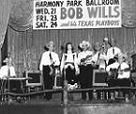





In 1930 Stephenville, Tex.-born vocalist Milton Brown (1903-36) meets Kosse, Tex.-born fiddler James Robert "Bob" Wills (1905-75) and joins the Wills Fiddle Band, consisting of Wills and guitarist Herman Arnspiger, which in 1931 is renamed the Light Crust Doughboys after their sponsor, the Burrus Mill and Elevator Co. of Saginaw, Tex., then the Fort Worth Doughboys, which also incl. Marvin "Smokey Montgomery, going on to launch Western Swing stars Bob Wills, Milton Brown, Tommy Duncan, Cecil Brower, John "Knocky" Parker, and Kenneth Pitts; they go on to release Beer-Drinking Mama, Good Gracious Gracie!, Tom Cat Rag, and Pussy Pussy Pussy (1939) before disbanding in 1942; in 1933 Bob Wills forms the Musical Brownies, the world's first Western Swing band at the Crystal Springs Dance Hall in Fort Worth, Tex., going on to become "the Father of Western Swing" along with Bob Wills, calling it "hot jaz hillbilly", inspiring Euro string jazz musicians Django Reinhardt and Stephane Grapelli to form the Hotel Club de Paris quintet in 1935; in 1934 they add Beggs, Okla.-born electric steel guitar player (jazz trombonist) Robert Lee "Bob" Dunn (1908-71), who becomes the first to record an electrically-amplified instrument on Jan. 27, 1935, making thesteel guitar a must in country and Western music, releasing Taking Off.; in Jan. 1935 they sign with Decca Records; in 1936 they sign fiddler Cliff Bruner, who teams with Bellevue, Tex.-born classically-trained fiddler Cecil Lee Brower (1914-65) to create a double fiddle sound; too bad, just as he is poised to achieve nat. fame, Bruner dies on Apr. 18, 1936 in Fort Worth, Tex. of pneumonia caused by a narcoleptic car accident, leaving Bob Wills to gain all the fame. In 1934 Bob Wills forms the Texas Playboys in Waco, Tex., moving to Tulsa, Okla. and pioneering Western Swing music, becoming known as "the King of Western Swing", releasing hits incl. Spanish Two Step (1935), Steel Guitar Rag (1936), San Antonio Rose (1938) (2M copies), Ida Red (1938) (later becomes Chuck Berry's "Maybellene), Take Me Back to Tulsa (1941), New San Antonio Rose (1943) (#3), Smoke on the Water (1945) (#1), Stars and Stripes on Iwo Jima (1945) (#1), New Spanish Two Step (1946) (#1), White Cross on Okinawa (1946) (#1), Roly Poly (1946) (#3), Sugar Moon (1947) (#1), Bubbles in My Beer (1948) (#4), Texarkana Baby (1948) (#15), Deep Water, and Faded Love (1950) (#8). In Nov. 1937 Clinton, Okla.-born Estel Eldon "Sham" "Frog" Shamblin (1916-98) of The Alabama Boys joins the Texas Playboys, becoming their lead guitarist until he is drafted into the U.S. Army in 1942, then again in 1946-54, being presented with one of the first Fender Stratocaster electric guitars in Mar. 1954 by Leo Fender and using it in the Texas Playboys' last recording session with MGM Records, after which Eric Clapton offers him $10K for it in the early 1980s. In the late 1940s Tyler, Tex.-born 5-string fiddle player John Paul "Johnny" Gimble (1926-) joins the Texas Playboys. In 1950 Bob Wills' Memphis, Tex.-born younger brother Billy Jack Wills (1926-91) quits after six years to form Billy Jack Wills and His Western Swing Band, which releases Take Me Back to Tulsa, Tobacco Chewing Boogie, Milk Cow Blues, Cadillac to Town in My Model A, Rock-A-bye Baby Blues, and All She Wants to Do Is Rock; too bad, they fold in 1954 after Bob Wills disbands the Texas Playboys and takes it over and runs it into the ground.

On Jan. 26, 1931 Wesley Ruggles' B&W Western Cimarron (RKO Radio Pictures) debuts, based on the 1929 Edna Ferber novel, starring Richard Dix and Irene Dunne as Kan. newspaperman Yancey and wife Sabra Cravat, who move to Okla. during the 1893 land rush, and print the Okla. Wigwam until he deserts her; costs $1.5M and requires 5K extras; becomes the first Western to win a Best Picture Oscar, and one of only two won by RKO; does $1.383M box office on a $1.433M budget.



In 1931 Kellyville, Tex.-born singing cowboy Carl Stuart Hamblen (1908-89) debuts his Family Album radio show in Calif., which features performers incl. Ken Carson (Hubert Paul Flatt) (1914-94) (AKA Hubert "Shorty" Carson), who leaves in 1932 to join the Beverly Hill Billies, the first Southern Calif. Western band, who pretend to live in log cabins, and incl. comic stutterer George Clinton "Shug" Fisher Jr. (1907-84) (first bass fiddler in a country band); in 1934 Hamblen becomes the first artist signed by the U.S. subsidiary of Decca Records; too bad, his horse race gambling, drinking, and brawling lands him frequently in jail, until he is converted by Billy Graham at a crusade in Los Angeles in 1949, then refuses to do alcohol commercials, getting him fired, writing the song It's No Secret What the Lord Can Do after John Wayne offers him a drink and he gives him that answer, the The Cowboy Church of the Air (1949-52); in 1950 he almost wins an election for Dem. rep. from Calif.'s 20th district (41%); in 1952 he is the U.S. pres. candidate for the Prohibition Party; in 1954 he writes This Ole House, which becomes a #1 U.S. and U.K. hit for Rosemary Clooney, along with the chipmunky Open Up Your Heart (and Let the Sunshine In), which becomes a hit for the Cowboy Church Sunday School (#8 in the U.S.), and is covered by Pebbles and Bamm-Bamm on The Flintstones on Sept. 17, 1965; in 1956 he releases Hell Train; in 1963 Graham holds another crusade in Los Angeles (his first coast-to-coast TV broadcast), and calls Hamblen's conversion "the turning point" in his ministry, which caused the small crowds to swell.
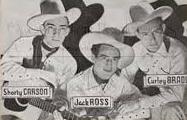


In 1933 the Western singing trio The Ranch Boys is formed in Southern Calif. by Ken "Shorty" Carson (Hubert Paul Flatt) (1914-94), Joe "Curley" Bradley (George Courtney) (1910-85), and Jack Ross (AKA Pinto Pete), appearing on the radio show The Fitch Bandwagon on NBC-Radio in Chicago, Ill., and signing with Decca Records, releasing songs incl. Casey Jones, Buffalo Gals, and There's a Home in Wyoming; in 1936 after appearing in the 1934 Clark Gable film It Happened One Night, they are signed by the Tom Mix radio show, with Ross playing Mix (1 episode), Curley playing Pecos, and Carson playing bit parts; later Bradley becomes radio's last Tom Mix until 1950; on May 10, 1938 they begin a 4-mo. 3,975-mi. cross-country horseback ride from Calif. to New York City as a publicity stunt, presenting mayor (1934-45) Fiorello La Guardia with a plaque from Calif. gov. (1934-9) Frank Merriam; they disband in 1941.
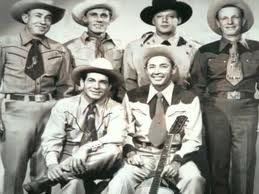




In 1933 the Western group Sons of the Pioneers is formed by ex-Del Monte fruit picker Roy Rogers (Leonard Franklin Slye) (1911-98), Bob Nolan (Robert Clarence Nobles) (1908-80), and Vernon Harold Timothy "Tim" Spencer (1908-74), later adding brothers Thomas Hubert "Hugh" Farr (1903-80) and Karl Farr (1909-61), Pat Brady (Robert Ellsworth Patrick Aloysious O'Brady) (1914-72), George Clinton "Shug" Fisher Jr. (1907-84) (1943-6, 1949-53, 1955-9), Ken Carson (Hubert Paul Flatt) (1914-94) (1943), Ken Curtis (Curtis Wain Gates) (1916-91) (son-in-law of dir. John Ford) (1949-53), Lloyd Wilson "Dobbs" "Mr. Pioneer" Perryman (1917-77), Pat Brady, Deuce Spriggens, Tommy Doss, Dale Warren, George Bamby, Rusty Richards, and Luther Nallie; on Aug. 8, 1934 (same day that Bing Crosby has his first session with them) they have their first session with Decca, recording Bob Nolan's Tumbling Tumbleweeds (originally "Tumbling Leaves"), going on to record 32 songs with Decca, Columbia, and RCA Victor, incl. Cool Water (by Bob Nolan) (1948) (#9 in the U.S.) (#2 in the U.K.). In 1946 Roy Rogers releases A Little White Cross on the Hill (#7 country), followed by My Chickashay Gal (1947) (#4 country), Blue Shadows on the Trail (w/the Sons of the Pioneers) (1948) (#6 country), (There'll Never Be Another) Pecos Bill (w/the Sons of the Pioneers) (1948) (#13 country), and Stampede (1950) (#8 country). In 1952 Roy Rogers and his Uvalde, Tex.-born 2nd wife (since 1947) Dale Evans (Lucille Wood Smith) (Frances Octavia Smith) (1912-2001 release Happy Trails (written by Dale Evans), which becomes the theme song for their NBC-TV show The Roy Rogers Show (Dec. 30, 1951-June 9, 1957) (100 episodes). In 1971 Roy Rogers releases the album A Man from Duck Run, which features Lovenworth (#12 country) (#33 in the U.S.), and Happy Anniversary (1971) (#47 country). He follows with Hoppy, Gene and Me (1974) (#15 country) (#12 in the U.S.), Ride Concrete Cowboy, Ride (w/the Sons of the Pioneers) (1980) (#80 country), and Hold On Partner (w/Clint Black) (1991) (#42 country) (#48 in the U.S.). Ken Curtis goes on to star as Festus Haggen in 239 episodes of the CBS-TV series "Gunsmoke".

On Nov. 15, 1935 George Stevens' Annie Oakley (RKO Pictures) debuts, starring Barbara Stanwyck as Annie, Preston Foster as her sharpshooter beau Toby Walker, Melvyn Douglas as Jeff Hogarth, Moroni Olsen as Buffalo Bill Cody, and Chief Thunderbird as Sitting Bull; does $620K box office on a $354K budget.
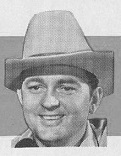
In 1935 Fanin County, Tex.-born William Lemuel "Bill" Boyd (1910-77) and The Cowboy Ramblers incl. his brother Jim Boyd (1914-) release their first hit Under the Double Eagle, which becomes a Westerrn swing std. In 1941 they release their 2nd hit If You'll Come Back (#4 in the U.S.); they go on to release 225+ recordings in 1934-51, incl. Pussy, Pussy, Pussy, I'll Never Let You Cry Over Me, and Wah Hoo.

In 1936 after the death of Milton Brown, Texas City, Tex.-born Western Swing fiddler-bandleader Clifton Lafayette "Cliff" Bruner (1915-2000) forms the Texas Wanderers, incl. Dickie McBride (guitar, vocals), Moon Mullican (piano, vocals), Bob Dunn (steel guitar), Leo Raley (mandolin), J.R. Chatwell (fiddle), going on to release the country hits It Makes No Difference Now (1938) (#1 country), I Hate to Lose You (1938), Truck Drivers' Blues (1939) (first trucker song), Draft Board Blues, Kangaroo Blues, That's What I Like About the South, Kelly Swing, I'll Keep On Loving You, Ouch, Out of Business, Snow Flakes, Singin' the Low Down Blues Down Low, Sugar, Sorry, When You're Smiling, and Lucille from Old Mobile (1947). Bruner's band disbands in the 1950s, but he continues to play, receiving recognition during the 1970s revival of Western Swing, and his trio is featured in the 1984 Sally Field film Places in the Heart.

In 1936 after learning to play the blues from a black sharecropper and developing a style of his own that mixes country, blues, Western Swing, and rock and roll, Polk County, Tex.-born "King of the Hillbilly Piano Players" Aubrey Wilson "Moon" Mullican (1909-67) releases his first country hit Swing Baby Swing (#5 country), followed by I'll Keep On Loving You (1938), Pipeliner's Blues (1940), Seven Come Eleven (1946), New Pretty Blonde (Jole Blon) (w/the Showboys) (1947) (#2 country) (King Records), Jole Blon's Sister (1947) (#4 country), Sweeter Than the Flowers (1948) (#3 country), I Left My Heart in Texas (by Jenny Lou Carson) (1948), Moon's Tune (1949), I Done It (?), I'll Sail My Ship Alone (1950) (#1 country) (#17 in the U.S.), Mona Lisa (1950) (#4 country), Goodnight Irene (1950) (#5 country), Cherokee Boogie (Eh-Oh-Aleena) (1951) (#7 country), Rock and Roll Mr. Bullfrog (?), and Ragged But Right (1961) (#15 country).

In 1937 Lake Mills, Iowa-born Wallace Earle Stegner (1909-83) ("Dean of Western Writers") pub. his first novel Remembering Laughter, about a love triangle between a farmer, his wife, and her sister. In 1938 he pub. The Potter's House. In 1940 he pub. On a Darkling Plain. In 1941 he pub. Fire and Ice. In 1943 he pub. The Big Rock Candy Mountain; autobio. novel about Bo Mason and his wife Elsa and son Bruce in early 19th cent. U.S.; followed by "Recapitulation" (1979). In 1946 he founds the Stanford Creative Writing Program at Stanford U. In 1947 he pub. Second Growth. In 1950 he pub. The Preacher and the Slave (Joe Hill: A Biographical Novel). In Dec. 3, 1960 he pub. Wilderness Letter, which helps get the 1964 U.S. Wilderness Act get passed. In 1961 he pub. A Shooting Star; Sabrina Castro cheats on her hubby. In 1962 he pub. Wolf Willow. In 1967 he pub. All the Little Live Things; Joe and Ruth Allston are disrupted by a hippie who builds a treehouse on their property in Calif. In 1971 he pub. Angle of Repose (Pulitzer Prize); his masterpiece?; based on the letters of Western novelist Mary Hallock Foote (1847-1938). In 1976 he pub. The Spectator Bird; retired lit. agent Joe Allston recalls a trip to Denmark 20 years earlier to find his roots, and reads a journal about a noble Danish family that was into incest and eugenics. In 1979 he pub. Recapitulation; sequel to "The Big Rock Candy Mountain" (1943); successful diplomat Bruce Mason returns to his childhood home of Utah to face his anger. In 1987 he pub. Crossing to Safety; Sid and Charity befriend novelist Larry Morgan and Sally.
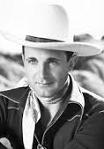

In 1937 B-movie Western actor Ray "Crash" Corrigan (Raymond Benard) (1902-76) goes on a hunting trip in Simi Valley, Calif. with Clark Gable, and decides to purchase land in the foothills of the Santa Susana Mts. in E Ventura County, which becomes Corriganville Movie Ranch, an outdoor set for films incl. "Drums of Fu Manchu" (1939) and "Fort Apache" (1948), and TV series incl. "The Lone Ranger" (1949-57), "The Cisco Kid" (1950-6), "The Adventures of Rin Tin Tin" (1954-9), "Sky King" (1951-9), Circus Boy" (1958-60), and "Star Trek" (1966-9); in 1944 he opens it up to paying visitors, reaching 1M attendance a year; in 1966 he sells it to Bob Hope, who turns it into Hopetown.
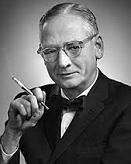
In 1938 Bay City, Mich.-born Am. West historian Ray Allen Billington (1903-81) pub. his first book The Protestant Crusade 1800-1860: A Study of the Origins of American Nativism, followed by Western Expansion: A History of the American Frontier (1949) (5th ed. 2001 w/Martin Ridge), which becomes a std. work, American History After 1865 (1950) (later eds. w/Martin Ridge), and The Far Western Frontier (1956). He follows with How the Frontier Shaped the American Character (Apr. 1958 ed. of American Heritage Mag.), which defends Frederick Jackson's 60+-y.-o. Frontier Thesis, Westward Movement in the United States (1959), Words That Won the West (Nov. 18, 1963), America's Frontier Heritage (1963), The Frontier Thesis: Valid Interpretation of American History? (1966), The American Frontier Thesis: Attack and Defense (1966), Frederick Jackson Turner: Historian, Teacher, Scholar (1973), America's Frontier Culture: Three Essays (1977), Limericks: Historical and Hysterical (1980), and Land of Savagery, Land of Promise: The European Image of the American Frontier in the Nineteenth Century (1985) (posth.). In 1961 he co-founds the Western History Assoc. in Santa Fe, N.M., which pub. The American West Magazine, Western Historical Quarterly, and Montana: The Magazine of Western History. After his 1981 death the Org. of Am. Historians (OAH) establishes the Ray Allen Billington Prize this year for the best book about Am. frontier history, incl. North Am., South Am., all post-1492 pioneer experiences, and comparisons between Am. frontiers and other around the world; the first award (1981) goes to John D. Unruh for "The Plains Across: The Overland Emigrants and the Trans-Mississippi West, 1840-60".
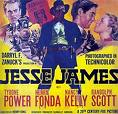
On Jan. 27, 1939 Henry King's Jesse James (20th Cent. Fox) debuts, written by Nunnally Johnson, starring Tyrone Power as Jesse, and Henry Fonda as his brother Frank, portraying them as Robin Hoods forced into crime by a mean railroad co. that evicts them from their family farm, "notorious for its historical inaccuracy"; after a horse falls to its death down a rocky slope onscreen, the Am. Humane Assoc. begins monitoring Hollywood filmmaking.
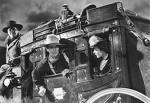
On Feb. 2, 1939 John Ford's Stagecoach (United Artists) debuts, produced by Walter Wanger based on the short story "Stage to Lordsburg" by Ernest Haycox, about seven passengers riding through Geronimo's Apache territory in 1884 sans the usual cavalry escort, becomnig the first pairing of B-actor John Wayne and dictatorial dir. "Coach" Ford since their split five years earlier when Wayne went off to another dir. and Ford stopped talking to him, becoming payback time for Ford as he constantly ridicules Wayne off-camera; after his suggestion of fellow unknown Lloyd Nolan is turned down, Wayne stars as escaped prisoner Henry the Ringo Kid (Malpais Bill in the short story), and steals the movie, joining the A-list and changing the course of the Hollywood Western, taking it out of the kiddie matinee league with the help of stuntman Yakima Canutt, who jumps the two lead horses, gets shot 2x, takes a prone dirt ride under the horses and coach, yet is seen getting up, and does it again dressed as Ringo, but doesn't get shot; the score features 17 Am. folk songs; the stagecoach has six horses, and the drivers speed them up by throwing rocks at them; also stars Claire Trevor as Wayne's looker babe with great gams Miss Dallas, Louise Platt as Capt. Richard Mallory's pregnant wife Lucy, Berton Churchill as embezzling banker Ellwood H. Gatewood ("what this country needs is a businessman for president"), Thomas Mitchell as alcoholic Dr. Josiah Boone, who sobers up with hot coffee and cold water in the face to deliver Mrs. Mallory's baby, John Carradine as proud Southern gambler Hatfield, Donald Meek as timid whiskey salesman Mr. Peacock from Kansas City, Kan., Andy Devine as driver Buck, who is betrothed to Julietta from Chihuahua, before Mexicans were called illegal aliens ("all aboard for Dry Fork, Apache Wells, Lee's Ferry, and Lordsburg") ("Bessie, Brownie, Bill, sweethearts"), and George Bancroft as shotgun guard Marshal Curley, who is bringing Ringo back to prison for a reward of $500 in gold; also features Tim Holt as the lt., and Tom Tyler as Lourdsburg bully Luke Plummer; photographers Bert Glennon and Ray Binger immortalize Monument Valley in Utah-Ariz.; the climax is the perfect Am. white racism message as self-appointed protector Hatfield gets ready to shoot "angel in the jungle" Mrs. Mallory rather than let filthy red savages get their hands on her, but the party is saved at the last sec. by the lily-white civilized bugle-blowing U.S. Cavalry ("Can you hear it, it's a bugle, they're blowing the charge" - Mrs. Mallory), after which Ringo kills Plummer and rides off with Dallas to his ranch on the other side of the border; "Well they're saved from the blessings of civilization" - "Doc, I'll buy you a drink" - "Just one" (Doc and Curley) (ending).

In 1940 East Orland, Maine-born, Reno, Nev.-raised Walter Van Tilburg Clark (1909-71) pub. his first novel The Ox-Bow Incident, about a lynching in Nev. of three innocent travelers mistaken for cattle rustlers, after which they discover their mistake; the first modern Western sans cliches and formula plots; his masterpiece?; filmed in 1943 by William A. Wellman starring Henry Fonda and Harry Morgan. In 1945 he pub. The City of Trembling Leaves, a set of parallel stories set in Reno, Nev. In 1949 he pub. The Track of the Cat, about the hunting of a marauding mountain lion in snowy Nev.; filmed in 1954 by William A. Wellman starring Robert Mitchum and Teresa Wright. In 1950 he pub. The Watchful Gods and Other Stores; incl. "The Wind and the Snow of Winter".

In 1941 Old Forge, Penn.-born "Yodeling Queen" Rosalie Allen (Julie Marlene Bedra) (1924-2003) joins Darling's Swing Billies radio show in New York City, bringing country-western to the big city, hosting the half-hour radio program Prairie Stars on WOV-AM in 1944-56; in 1946 she releases her first hit I Want to Be a Cowboy's Sweetheart (by Patsy Montana), followed by Hitler Lives (1945), Beyond the Sunset (w/Elton Britt) (1950) (#7 country), The Yodel Blues (w/Elton Britt), Fooling Around (w/Elton Britt), and Quicksilver (w/Elton Britt). In 1999 she becomes the first woman inducted into the Country Music Disc Jockey Hall of Fame.
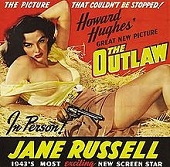
On Feb. 5, 1943 Howard Hughes' B&W The Outlaw (United Artists) debuts, starring Jack Buetel as Billy the Kid, Thomas Mitchell as Pat Garrett, Walter Huston as Doc Holliday, and is the debut and breakthrough role for Ernestine Jane Geraldine Russell (1921-2011) as Rio McDonald, who lounges seductively in the hay for publicity shots; does $5M box office.

On May 8, 1943 William A. Wellman's The Ox-Bow Incident (20th Cent. Fox) debuts, based on the 1940 Walter Van Tilburg Clark novel, set in 1885 Bridger's Wells, Nev. sees sleeping men Donald Martin (Dana Andrews), Juan Martinez (Anthony Quinn), and Alva Hardwick (Francis Ford, brother of dir. John Ford) lynched in Ox-Bow Canyon by a posse led by Maj. Tetley (Frank Conroy), and incl. Gil Carter (Henry Fonda) and Art Croft (Harry Morgan), who later learn that they were innocent; does $750K box office on a $565K budget.

On May 26, 1943 Harold D. Schuster's My Friend Flicka (20th Cent. Fox) debuts, based on the 1941 Mary O'Hara novel, starring Roddy McDowall as 10-y.-o. Wyo. rancher's son Ken McLaughlin, who nurses his 1-y.-o. colt filly back to health after being cut by barbed wire; the father Rob McLaughlin (Preston Foster) shoots his gun, but only to ward off a mountain lion, and the filly recovers.
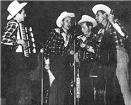

In 1943 Peter Potter's Hollywood Barn Dance country-western musical variety show debuts as a wartime replacement for Gene Autry's "Melody Ranch", hosted by Paris, Tex.-born Cottonseed Clark (S. Clark Fulks) (1909-92), known for Smoky River Serenade (1947), and The Arkansas Swing (1948); performers incl. Foy Willing and the Riders of the Purple Sage, who provide the music for the All-Star Western Theater, along with fiddler Charlie Linvalle, yodeler Carolina Cotton, comic Johnny Bond, Kirby Grant, singing cowboy Ken Curtis, Andy Parker and the Plainsmen, Clem Smith, Maureen O'Connor, Roy Rogers, even Bob Hope; ends in 1948.

On Jan. 15, 1945 after taking over from Jimmy Wakely at the Venice Pier Ballroom in Calif., Grand, Okla.-born part-Cherokee Western swing fiddler Donnell Clyde "Spade" Cooley (1910-69) and His Western Dance Gang release Shame on You (#1 in the U.S.), which becomes his signature song, going on to become known as "the King of Western Swing"; the first song pub. by Hill & Range Pub. Co. of Los Angeles, Calif., founded by Vienna, Austria-born Julian J. Aberbach (1909-2004) et al., which goes on to dominate country music (75% of the action in Nashville), contracting with Elvis Presley in 1955 to pub. all his songs, which keeps him from pub. his own material until the early 1970s. In 1945 Spade Cooley and His Orchestra release I've Taken All I'm Gonna Take from You (#4 country), followed by Detour (1946) (#2 country), You Can't Break My Heart (1946) (#3 country), and Crazy 'Cause I Love You (1947) (#4 country). In June 1948 Cooley begins hosting a radio show on KTLA-TV in Los Angeles, Calif, becoming the #1 draw on the West Coast. Too bad, in 1961 Cooley is convicted of the head-bashing stomach-stomping murder of his 2nd wife Ella Mae Evans, ending his career.


In 1945 Birmingham, Ala.-born Western Swing musician (banjo) Herbert Clayton "Hank" Penny (1918-92) releases his first country charter When You Cry, You Cry Alone, followed by Steel Guitar Stomp (featuring Merle Travis on guitar and Noel Boggs on steel guitar) (1946), Get Yourself a Redhead (1946), Hadacillin Boogie, Let Me Play with Your Poodle (1947), Hillbilly Be-Bop (1949) (King Records), and Bloodshot Eyes (1950), which is covered in 1951 by African-Am. Omaha, Neb.-born rock & roll singer Wynonie Harris (1915-69), making a fan of Elvis Presley. In 1954-61 Penny performs at the Golden Nugget Casino in Las Vegas, Nev., hiring steel guitar player Curly Chalker and banjo player Roy Clark, helping launch his career.
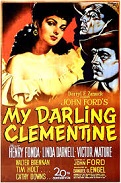
On Dec. 3, 1946 John Ford's B&W My Darling Clementine (20th Cent. Fox) debuts, based on the 1931 Stuart N. Lake novel "Wyatt Earp, Frontier Marshal" about the Oct. 26, 1881 Gunfight at the O.K. Corral, starring Henry Fonda as Wyatt Earp, Victor Mature as Doc Holliday, Walter Brennan as Old Man Clanton, Tom Holt as Virgil Earp, Ward Bond as Morgan Earp, Tim Holt as Virgil Earp, and John Ireland as Billy Clanton; features the 1884 Percy Montrose song Oh My Darling, Clementine; Linda Darnell plays Holliday's babe Chihuahua; favorite movie of Col. Potter in "M*A*S*H".


In 1946 after serving in the U.S. Navy in WWII, Plainsburg, Calif.-born Western Swing singing cowboy Steve "Dude" Martin (John Stephen "Steve" McSwain) (1915-91) and his Roundup Gang become popular on radio in the San Francisco, Calif. area, releasing Strawberry Roan (1948), Deepfreeze Dinah, and Pistol Boogie, hosting The Dude Martin Show on TV in 1949-51; his partner and bandleader is San Francisco, Calif.-born accordion player Harry Theodore "Ted" "Hezzie" Johnson (1916-2011) of the Nevada Night Herders.

In 1947 Bedford, Ind.-born Alfred Bertram "Bud" Guthrie Jr. (1901-91) (who moved to Choteau, Mont. at age 6 mo. so his father could be the first principal of the first h.s. in Montana Territory) pub. The Big Sky; 17-y.-o. Boone Caudhill stands up to his abusive father and leaves home, deciding to walk from Ky. to St. Louis then the Grand Tetons, where he hooks up with Teal Eye, daughter of a Blackfoot chief. In 1949 he pub. the sequel The Way West, which wins a Pulitzer Prize. He goes on to write the screenplay for "Shane" (1953), based on a 1949 novel by Jack Schaefer (1907-91).

On Jan. 6, 1948 John Huston's The Treasure of the Sierra Madre (Warner Bros.) debuts, based on the 1927 B. Traven novel and shot in Durango and Tampico, Mexico for a wallet-busting $2.5M , starring Humphrey Bogart (after Edward G. Robinson is turned down) and Tim Holt as losers Fred C. Dobbs and Bob Curtin in 1920s Mexico, who hook up with old timer gold prospector Howard (John Huston's father Walter Huston) to find the you know what, and cross paths with banditos, whose leader Gold Hat (Alfonso Bedoya) utters the soundbyte "We don't need no stinkin' badges" (actually, "I don't have to show you any stinkin' badges"); Robert Blake plays the boy lottery ticket seller who gets a glass of water in his face; John Huston plays White Suit, from whom Bogart keeps begging pesos; Barton McClain plays a cheating work boss; "Mrs. Mildred Pierce" Bruce Bennett plays hustling gold digger Cody; Tim Holt's father Jack Holt has a bit part in a saloon; the film typecasts Tim Holt in Western roles; "Oomph Girl" Ann Sheridan has a street walk-by part; real gold dust is too heavy to blow away in the wind?
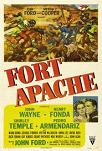

On Mar. 27, 1948 John Ford's Fort Apache (RKO Radio Pictures) debuts, the first of Ford's "Cavalry Trilogy" ("She Wore a Yellow Ribbon" in 1949, "Rio Grande" in 1950) based on stories by James Warner Bellah (1899-1976), starring John Guess Who Wayne as Capt. Kirby York, and Henry Fonda as fanatical Lt. Col. Owen Thursday, who tries to crush the Apaches under Cochise and ends up in a Custer-like massacre instead, only to have the Army cover it up and portray the dope as a hero; Ward Bond and John Agar play Sgt. Maj. Michael O'Rourke and his son Lt. Michael Shannon O'Rourke; Victor McLaglen plays Sgt. Festus Mulcahy; Miguel Inclan plays Cochise; has a small role for Agar's wife (1945-50), over-the-hill child actress Shirley Temple as Philadelphia Thursday; does $3M box office on a $2.1M budget.

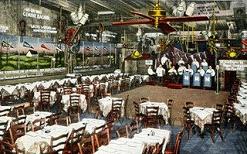

On May 24, 1948 the live weekly variety series Village Barn debuts on NBC-TV (until Sept. 1949), originating from the Village Barn nightclub in Greenwich Village, N.Y., becoming the first country music program on U.S. network TV; the debut episode features Tex Ruby, Curly Fox, and The Dixie Boys; later episodes feature Pappy Howard and His Tumbleweed Gang, Harry Ranch and His Kernels of Korn, Bill Long's Ranch Girls, Plute Pete, Romolo De Spirito, Shorty Warren and His Western Rangers, and Okla. gov. Roy J. Turner; when it closes in the late 1960s, the Village Barn becomes Electric Lady Studios, famous as the place where Jimi Hendrix records; above it is the 8th Street Playhouse.
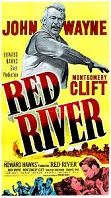

On Sept. 30, 1948 Howard Hawks' B&W Red River (United Artists) debuts, starring John Wayne as a reprehensible, obsessive father on a cattle drive, and Edward Montgomery Clift (1921-66) in his film debut as his son; Hawks' main rival John Ford sees the film and realizes for the first time that his boy Wayne can actually act, and beefs-up his roles?; does $9M box office on a $2.7M budget.
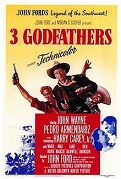
On Dec. 1, 1948 John Ford's 3 Godfathers (MGM) debuts, produced by Merian C. Cooper and filmed in Death Valley, Calif., a color remake of the 1936 film based on the 1913 Peter B. Kyne novel about modern Biblical Three Wise Men Wild West bank robbers Robert Marmaduke Hightower (John Wayne), William Kearney the Abilene Kid (Harry Carey Jr.) (his film debut), and Pedro (Pedro Armendariz), who try to take orphaned infant Robert William Pedro across the desert on foot while being chased by the posse of Sheriff Perley "Buck" Sweet (Ward Bond); does $2.8M box office on a $1.2M budget.

On Dec. 24, 1948 Norman Z. McLeod's Paleface debuts, starring 5'7" 38D-24-36 Ernestine Jane Geraldine Russell (1921-) as Calamity Jane, and Bob Hope as quack dentist Painless Potter, who sings the 1947 Jay Livingston-Ray Evans song Buttons and Bows, which becomes his biggest-selling hit, even though Dinah Shore upstages him in the charts.
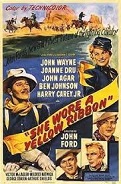
On July 26, 1949 John Ford's She Wore a Yellow Ribbon (RKO Radio Pictures) debuts, starring John Wayne as over-the-hill Capt. Nathan Cutting Brittles of C Troop, who shuns retirement to help the undermanned cavalry outpost of Ft. Starke make a stand against the Cheyenne and Arapaho Indians after the Battle of the Little Big Horn, first pow-wowing with old chief Pony-That-Walks (Chief John Big Tree) and trading remarks on how only young testosterone-soaked idiots like war and it the responsibility of wise old farts to stop them but they can't; also stars John Agar as Lt. Flint Cohill, Ben Johnson as Sgt. Tyree, Harry Carey Jr. as Lt. Ross Pennell, Victor McLaglen as Sgt. Quincannon, George O'Brien as Maj. Allshard, and Joanne Dru as Cohill's babe Olivia Dandridge; does $2.7M box office.

On Sept. 15, 1949 the Westerm drama series The Lone Ranger debuts on ABC-TV for 221 episodes (until June 6, 1957), starring former circus acrobat, model, and stuntman Jack Carlton "Clayton" Moore (1914-99) as the masked white hero, and Canadian Mohawk Indian Jay Silverheels (1912-80) as his Indian sidekick Toto, with the cavalry charge finale of Gioacchino Rossini's "William Tell Overture" as the theme music, and the voice of Frederick William "Fred" Foy (1921-2010) announcing: "A fiery horse with the speed of light, a cloud of dust, and a hearty 'Hi-ho Silver away!'... Return with us now, to those thrilling days of yesteryear"; in the 1952 season the producers replace Moore with similarly-built John Hart (1917-2009), until audience demand gets him back after one season.

In 1949 Willcox, Ariz.-born Western actor ("Last of the Silver Screen Cowboys") Rex Elvie Allen (1920-99) releases his debut single Afraid (#14 country), starring in 19 Westerns in 1950-4 beginning with "The Arizona Cowboy" (1950) with his white Stetson, horse Koko, and sidekick Buddy Ebsen or Slim Pickens, making the last singing Western, "Phantom Stallion" in 1954. In 1951 he releases Sparrow in the Treetop (#10 country) (#28 in the U.S.), followed by Crying in the Chapel (1953) (#4 country) (#8 in the U.S), and Son, Don't Go Near the Indians (1962) (#4 country) (#17 in the U.S.). In the 1960s he goes to work for Walt Disney Pictures as "the Voice of the West", narrating "The Incredible Journey" (1963), "Charlotte's Web" (1973), and Purina Dog Chow commercials.


On May 17, 1950 George Sidney's Annie Get Your Gun (MGM) debuts, based on the 1946 Rodgers and Hammerstein musical, starring Betty Hutton as Annie Oakley, and Howard Clifford Keel (1919-2004) as Frank Butler in his film debut; Louis Calhern (who replaced Frank Morgan after he died of a heart attack during filming) plays Buffalo Bill Cody, J. Carrol Naish plays Sitting Bull, Edward Arnold plays Pawnee Bill, and Keenan Wynn plays Charlie Davenport; Judy Garland was the first Annie, but had to pull out because of her health; does $7.7M box office on a $3.7M budget; incl. the songs There's No Business Like Show Business, Doin' What Comes Natur'lly, Anything You Can Do, You Can't Get a Man With a Gun.
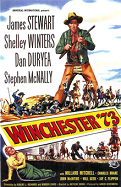
On June 7, 1950 Anthony Mann's B&W Winchester '73 (Universal Pictures) debuts, starring James Stewart as Lin McAdam, who with his friend Rankie "High-Spade" Wilson (Millard Mitchell) chase outlaw Dutch Henry Brown (Stephen McNally) to Dodge City, Kan., where McAdam beats Brown in a shooting competition, winning a "One of One Thousand Winchester 1873 rifle, which Brown steals, resulting in a long chase, after which McAdam kills Brown in Tascosa, Tex. and it is revealed that they're really brothers; also features Shelley Winters and Dan Duryea; Tony Curtis plays a cavalry trooper; Rock Hudson plays an Injun.

On June 23, 1950 Henry King's Western The Gunfighter (20th Cent. Fox) debuts, written by Nunnally Johnson based on a story by William Bowers and Andre de Toth, starring Gregory Peck as over-the-hill gunslinger Jimmy Ringo, who keeps trying to quit while every young Tom, Dick, and Harry or Skip Homeier (as Hunt Bromley) wants a piece of him, finally getting gunned down in the back and telling the sheriff the other guy drew first, while telling the new king of the hill that he's the new It, and he'll be waiting for him in Hell?; Helen Westcott plays Ringo's wife Peggy Walsh.
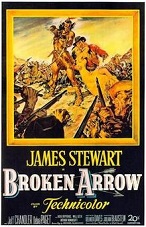
On July 20, 1950 Delmer Daves' Broken Arrow (20th Cent. Fox) debuts, filmed near Flagstaff, Ariz., the first major Hollywood Western since WWII to side with the Indians, based on the 1947 novel "Blood Brother" by Elliott Arnold, starring James Stewart as mailman Tom Jeffords, who walks into the camp of Cochise (Jeff Chandler) and negotiates safe passage to Tucson; Debra Paget plays Indian babe Sonseeahray (Morningstar); Basil Ruysdael plays "Christian Gen." Oliver Otis Howard; Jay "Tonto" Silverheels plays Geronimo; Will Geer plays rancher Ben Slade; real Apaches from the local rez are used as extras.
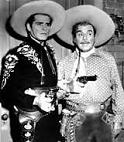
On Sept. 5, 1950 the 30-min. Western series The Cisco Kid, based on the 1907 O. Henry short story about two fugitives from justice who turn into Robin Hoods debuts in syndication for 156 episodes (until Mar. 22, 1956), becoming the first TV series to be filmed in color, starring Duncan Renaldo (Renault Renaldo Duncan) (1904-80) as the Cisco Kid, who roams the Wild West on his black-and-white horse Diablo, and Leopold Antonio "Leo" Carrillo (1880-1961) as his sidekick Pancho, who rides the horse Loco.
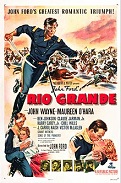
On Nov. 15, 1950 John Ford's B&W Rio Grande (Republic Pictures) debuts, last in Ford's Cavalry Trilogy, starring John Wayne as Lt. Col. Kirby Yorke, an ex-Civil War cavalry cmdr. on the Mexican border of Tex. campaigning against Apaches while dealing with unhappy wife Kathleen (Maureen O'Hara) and a new recruit, his son Trooper Jeferson Yorke (Claude Jarman Jr.); Ben Johnson plays Trooper Travis Tyree, who is running from the law; features folk songs sung by the Sons of the Pioneers incl. "Festus Haggen in Gunsmoke" Ken Curtis; studio pres. Herbert Yates forces Ford to make this film before "The Quiet Man", only to see the latter go #1; does $2.25M box office; "John Ford's greatest romantic triumph".

On Apr. 15, 1951 the Western series The Adventures of Wild Bill Hickock debuts on CBS-TV (ABC-TV in 1957-8) for 113 episodes (until May 16, 1958), starring Guy Madison (Robert Ozell Moseley) (1922-96) as U.S. Marshal James Butler "Wild Bill" Hicock (who rides the horse Buckshot), and 300-lb. Andrew Vabre "Andy" Devine (1905-77) as his comical raspy-voiced deputy Jingles P. Jones.
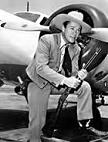
On Sept. 16, 1951 the Western series Sky King debuts on NBC-TV for 72 episodes (until Mar. 8, 1959), starring Kirby Grant (Kirby Grant Hoon Jr.) (1911-85) as Ariz. rancher-pilot Schuyler "Sky" King of the Flying Crown Ranch near Grover, Ariz., and his pilot niece Penny, played by Gloria Winters (1931-2010), who use his plane Songbird like a flying horse to catch bad guys and find lost hikers.



On July 24, 1952 Fred Zinnemann's High Noon (United Artists) debuts, based on the story "The Tin Star" by John W. Cunningham, about Hadleyville town marshal Will Kane (Gary Cooper) facing four prof. killers alone while his wife Amy Fowler Kane, played by Grace Patricia Kelly (1929-82) (film debut) melts down and the gutless townfolk do nothing; the action runs from 10:30 a.m. to 12:15 p.m; the theme song The Ballad of High Noon (Do Not Forsake Me, Oh My Darlin'), sung by Tex Ritter (1905-74) is composed by Ukrainian-born Dimitri Tiomkin (1894-1979) and Ned Washington (1901-76); Tiomkin becomes the first composer to receive two Oscars (score and song) for the same dramatic film; does $12M box office on a $730K budget.

On Apr. 23, 1953 George Stevens' Shane (Paramount Pictures) debuts, written by A.B. Guthrie Jr. based on the 1949 Jack Schaefer novel set in 1889 Wyo., and filmed in beautiful Jackson Hole, Wyo.; stars Alan Ladd as buckskin-wearing good guy gunfighter Shane, Van Heflin and Jean Arthur (last film performance) as married homesteaders Joe and Marian Starrett, and Jack Palance as bad guy ("lowdown Yankee liar") Jack Wilson in the finest Western movie ever made?; Emile Meyer plays ruthless cattle baron Rufus Ryker; Elisha Cook Jr. plays Ala. ex-Confederate homesteader Frank "Stonewall" Torrey: Brandon De Wilde (1942-72) plays the cute boy Joey, who at the end of the movie hauntingly cries "Shane, come back! Come back, Shane!"; the jury's still out on whether Shane dies of his wounds.

In 1953 Jamestown, N.D.-born ("Homer of the Oater" - Time mag.) Louis Dearborn L'Amour (LaMoore) (1908-88) pub. his first hit (his masterpiece?) Hondo, based on the story "The Gift of Cochise", about Hondo Lane, Angie Lowe, and Indian warrior Vittorio, establishing his genre of tough loner gunman and damsel in distress with period touches - give me a big fat hairy howl? In 1960 he pub. Daybreakers, followed in 1961 by Sackett, launching the Sackett Series, about the Sackett family, who come from The Fens of Cambridgeshire, England, and work their way W over the Atlantic to the Great Plains, Rockies, and Calif. In 1962 he pub. Lando; Orlando Sackett searches for his father's gold in Mexico and ends up in a horrible Mexican jail. In 1965 he pub. The Sackett Brand. In 1966 he pub. Mustang Man. In 1969 he pub. The Lonely Men, another Sackett novel. In 1972 he pub. Treasure Mountain; Orrin and Tell Sackett look for their lost father in La. In 1974 he pub. Sackett's Land. In 1976 he pub. To the Far Blue Mountains. In 1980 he pub. The Warrior's Path; Yance and Kin Sackett search for Yance's kidnapped sister-in-law. "The most interesting man in the world." - John Wayne.

In 1953 Detroit, Mich. advertising copywriter Elmore John Leonard Jr. (1925-2013) pub. his first novel The Bounty Hunters, and the short story Three-Ten (3:10) to Yuma (Mar.), filmed in 1957. In 1954 he pub. The Law at Randado. In 1956 he pub. Escape from Five Shadows. In 1957 he pub. The Captives. In 1959 he pub. Last Stand at Saber River. In 1961 he pub. Hombre; filmed in 1967. In 1969 he pub. The Moonshine War; also The Big Bounce; his first crime novel, rejected 84x by publishers before appearing in paperback. In 1970 he pub. Valdez is Coming. In 1972 he pub. Forty Lashes Less One, about Chiricahua Apache Raymond San Carlos and black ex-soldier Harold Jackson in Yuma Prison. In 1974 he pub. 52 Pickup; Detroit businesman Harry Mitchell is blackmailed over a sexual affair; also Mr. Majestyk; Vietnam vet tries to farm melons in Ariz. while fighting the local mob. In 1976 he pub. Swag; small-time criminal Ernest Stickley Jr. and used car salesman Frank Ryan. In 1977 he pub. Unknown Man No. 89; The Hunted. In 1978 he pub. The Switch; Ordell Robbie and Louis Garza get out of prison and plan a kidnapping of the wife of a wealthy Detroit businessman, only to find out he doesn't want her back, pissing her off and causing her to work with them for revenge. In 1979 he pub. Gunsights. In 1980 he pub. City Primeval: High Noon in Detroit; serial murderer Clement Mansell AKA the Okla. Wildman and homicide detective Raymond Cruz; Gold Coast; Fla. mob boss Frank DiCilia dies and leaves his gorgeous widow Karen everything on condition that she never has another man, tasking his thug Roland to watch her, but she tries it anyway with ex-con Cal Maguire. In 1981 he pub. Split Images. In 1982 he pub. Cat Chaser; Fla. hotel mgr. George Moran hooks up with the wife of Dominican ex-military enforcer Andres de Boya. In 1983 he pub. Stick; an ex-con tries to go straight but is tempted by a revenge scam; LaBrava; ex-Secret Service agent Joe LaBrava and ex-movie queen Jean Shaw. In 1985 he pub. Glitz; psycho mama's boy Teddy Magyk wants to get even with a Miami cop. In 1987 he pub. Bandits; Jack Delaney, Sister Lucy, and a Nicaraguan col.; Touch; Brother Juvenal becomes Charlie Lawson, caring for alcoholics in Detroit and developing Sigmata that cause miracles, attracting flashy promoter Bill Hill and right-winger August Murray and falling in love with Lynn Faulkner. In 1988 he pub. Freaky Deaky; ex-bomb squad member Chris Mankowski in Detroit, Mich. In 1990 he pub. Get Shorty, about Miami loan shark Chili Palmer; filmed in 1995. In 1999 he pub. Be Cool, about Chili Palmer's exploits in the LA music biz; filmed in 2005.
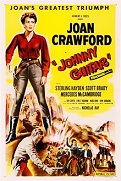
On May 7, 1954 Nicholas Ray's Johnny Guitar (Republic Pictures) debuts, starring Joan Crawford as Vienna, "Gun-Queen of the Arizona Frontier", Sterling Hayden as Johnny "Guitar" Logan, and Mercedes McCambridge as Emma Small in a Western with sensibilities that impresses Francois Truffaut; does $2.5M box office.

In 1954 Indiana, Penn.-born Edward Paul Abbey (1927-89) ("the Thoreau of the American West" - Larry McMurtry) pub. his first novel Jonathan Troy. In 1956 he pub. The Brave Cowboy. In 1962 he pub. Fire on the Mountain; John Vogelin vs. the govt. in the N.M. wilderness. In 1968 he pub. Desert Solitaire: A Season in the Wilderness; U.S. forest ranger inspires the modern environmentalist movement along with the ecoterrorist movement. In 1971 he pub. Black Sun; a fire lookout at a nat. park falls for a girl half his age, who then disappears, causing him to be blamed. In 1975 he pub. The Monkey Wrench Gang; bestseller (500K copies) about an underground group of ecoterrorists in the Am. West, inspiring the 1980 formation of the Earth First! org.; followed by "Fool's Progress" (1981). In 1980 he pub. Good News; society collapses. On Aug. 15, 1988 he pub. The Fool's Progress: An Honest Novel, about his alter ego Lightcap. In 1989 he pub. his last novel Hayduke Lives!

On July 3, 1955 Jacques Tourneur's Wichita (Allied Artists Pictures) debuts, starring Joel McCrea as Wyatt Earp, who reluctantly accepts the job of town marshal then demands all guns be surrendered; Peter Graves plays Morgan Earp; does $2.4M box office.
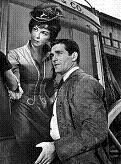
On Sept. 6, 1955 the Western series The Life and Legend of Wyatt Earp debuts on ABC-TV for 229 episodes (until June 27, 1961), starring Hugh O'Brien (Hugh Charles Krampe) (1925-), whose portraits allegedly resemble those of the real Wyatt Earp, and who carries a Buntline Special with a 12-in. barrel (unlike the real dude) (creating a toy craze), and set in Ellsworth, Kan., Dodge City, Kan., and Tombstone, Ariz., becoming the first adult TV Western; the last five episodes set up the fabled Oct. 26, 1881 Gunfight at the OK Corral; the theme song is by legendary songwriter Harry Warren.

On Sept. 10, 1955 the B&W TV Western series Gunsmoke debuts on CBS-TV for 633 episodes (until Mar. 31, 1975) (longest running scripted primetime U.S. TV series) (debut episode introduced by John Wayne) (switches to color in 1966), starring James King Arness (1923-2011) as Marshall Matt Dillon, William Dennis Weaver (1924-2006) as Chester Goode, Amanda Blake (1929-89) as Kitty Russell, Milburn Stone (1904-80) as Doc Galen Adams, and longtime Sons of the Pioneers singer Ken Curtis (Curtis Wain Gates) (1916-91) as Festus Haggin - white America can escape to a cozy, bleached white past coming from Hollywood into their living rooms, while the real world goes to Hell?

On Sept. 20, 1955 the Western series Cheyenne debuts on ABC-TV for 108 episodes (until Apr. 30, 1963), starring 6'6" Norman Eugene "Clint" Walker (1927-) as Cheyenne Brodie, a wandering cowboy raised by you know what Indians, featuring his baritone singing voice.

On Mar. 13, 1956 John Ford's The Searchers (Cornelius Vanderbilt Whitney) debuts, based on the 1954 Alan Le May novel, starring John Wayne as white racist Tex. Civil War vet Ethan Edwards, who searches for his Indian-kidnapped niece Debbie (Natalie Wood) and almost kills her to keep her from bearing half-breed kids; also stars Jeffrey Hunter as Martin Pawley, Ward Bond as Rev. Samuel Johnson Clayton, Vera Miles as Laurie Jorgensen, Lana Wood as young Debbie Edwards, and Ken Curtis as Charlie McCorry; the greatest Western of all time, and the classic study of the white Am. psyche?; Wayne's line "That'll be the day" (said 4x) is used by Buddy Holly as a song title.
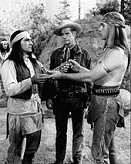
On Sept. 25, 1956 the B&W Western series Broken Arrow debuts on ABC-TV for 73 episodes (until Sept. 23, 1958), based on the 1950 film, starring Michael Ansara as Chiricahua Apache chief Cochise, who disses the role with the soundbyte: "Cochise could do one of two things - stand with his arms folded, looking noble; or stand with arms at his sides, looking noble."

On Mar. 18, 1957 (Mon.) the Western series Tales of Wells Fargo debuts on NBC-TV for 200 episodes (until June 2, 1962), starring Harrah, Okla.-born Dale (Dayle Lymoine) Robertson (1923-2013) (whose voice bears an amazing resemblance to that of "Jock Ewing" actor Jim Davis?) as roving 1870s-1880s Wells Fargo agent Jim Hardie, "the left-handed gun".
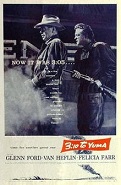
On Aug. 7, 1957 Delmer Daves' B&W Western 3:10 to Yuma (Columbia Pictures) debuts, based on the 1953 story by Elmore Leonard, starring Glenn Flord as 1880s Ariz. outlaw Ben Wade, and Van Heflin as rancher Dan Evans, who is talked into taking him to the you know what so he can be tried in Yuma; Felicia Farr plays barmaid Emmy; theme song by Dmitri Tiomkin and Ned Washington; remade in 2007 by James Mangold starring Russell Crowe and Christian Bale.
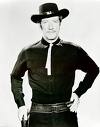
On Sept. 14, 1957 (Sat.) Have Gun - Will Travel debuts on CBS-TV for 225 episodes (until Apr. 20, 1963), starring snazzy black-dressing polyglot opera-loving gourmand former Army officer Richard Allen Boone (1917-81), who lives in the Carlton Hotel in San Francisco, Calif., and wears a holster with chess knight emblems plus a concealed derringer under his belt, and passes out calling cards saying "Have Gun Will Travel/Wire Paladin/San Francisco".

On Sept. 18, 1957 (Wed.) the Western series Wagon Train debuts on NBC-TV for 284 episodes (switching to ABC-TV in 1962) (until May 2, 1965), based on the 1950 John Ford film "Wagon Master" and the 1930 John Wayne flick "The Big Trail", starring Wardell Edwin "Ward" Bond (1903-60) as wagonmaster Maj. Seth Adams, and Robert Horton (Meade Howard Horton Jr. (1924-) as scout Flint McCullough, with other actors subbing after Bond's death, incl. Robert Fuller (1933-) as scout Cooper Smith.
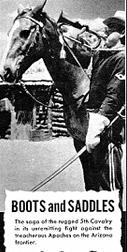
On Sept. 19, 1957 (Thur.) Robert A. Cinader's Western series Boots and Saddles debuts in syndication for 38 episodes (until May 29, 1958), set in 1871 in Ft. Lowell in Arizona Territory, about the 5th Cavalry fighting the fierce Apaches, starring John M. "Jack" Picard (1913-93) as Capt. Shank Adams, Patrick "Pat" McVey (McVeigh) (1910-73) as Lt. Col. Wesley Hayes, and George Cadogan Gardiner McKay (1932-2001) as Lt. Dan Kelley.

On Sept. 24, 1957 (Tue.) the Western series The Californians debuts on NBC-TV for 54 episodes (until May 26, 1959), set in 1850s San Francisco, Calif., starring Adam Kennedy (1922-97) as Irish newspaperman Dion Patrick, who helps the local vigilante committee fight the unruly Forty-Niner miners.

On Sept. 27, 1957 (Fri.) the Western comedy Maverick (B&W) (Warner Bros.) debuts on ABC-TV for 124 episodes (until Apr. 22, 1962), starring Okla.-born James Garner (1928-), Queens, N.Y.-born John Augustus "Jack"Kelly (1927-92), and Long Beach, Calif.-born Robert Colbert (1931-) (season 4), as Tex.-born high-stakes poker-playing traveling Maverick brothers Bret, Bart, and Brent; after season 3 Garner leaves after a winning a lawsuit freeing him to go into movies; no more than two brothers appear in the same episode, often only one; after Sean Connery turns the part down, London-born Roger George Moore (1927-) (season 4) (who suffers from hoblophobia, fear of guns, blinking when he touches on) plays their English cousin Beau; after uttering the soundbyte: "Put me in a dress and call me Brenda, but don't do this to me!", Colbert is deliberately palmed-off as Garner, lasting only two seasons when the voice gives him away.

On Oct. 4, 1957 (Fri.) "the thinking man's Western" series Trackdown debuts on CBS-TV for 70 episodes (until Sept. 23, 1959), starring Robert Martin Culp (1930-2010) as Texas Ranger Hoby Gilman in 1870s Porter (NE of Houston), Montgomery County, Tex.

On Oct. 16, 1957 (Wed.) the Western series Tombstone Territory debuts on ABC-TV for 93 episodes (until July 8, 1960), starring Patrick Douglas "Pat" Conway (1931-81) (son of dir. Jack Conway) as Sheriff Clay Hollister of "the Town Too Tough to Die"; the theme song is Whistle Me Up a Memory by William M. Backer.
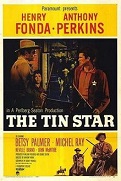
On Oct. 23, 1957 Anthony Mann's Western The Tin Star (Paramount Pictures) debuts, starring Henry Fonda as ex-sheriff bounty hunter Morg Hickman, who schools greenhorn sheriff Ben Owens (Anthony Perkins); "A decent man doesn't want to kill, but if you're going to shoot, shoot to kill."
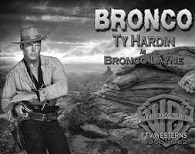
On Sept. 23, 1958 (Tues.) after Clint Walker er, walks out of Warner Bros over his contract, causing them to hire him, the B&W Western series Bronco debuts on ABC-TV for 68 episodes (until Apr. 30, 1962), starring Ty Hardin (Orison Whipple Hungerford Jr.) (1930-2017) as ex-Confed. officer Bronco Layne, who roams the Wild West meeting celebs incl. Wild Bill Hickock, Jesse James, Billy the Kidd, Belle Starr, Cole Younger, John Wesley Hardin, and Theodore Roosevelt.

On Sept. 30, 1958 (Tue.) the B&W Western series The Rifleman debuts on ABC-TV for 168 episodes (until Apr. 8, 1963), starring tall, lanky lefty Irish-faced former cavalry lt. (8th Indiana Infantry Regiment) Chuck Connors (1921-92) as widower Lucas McCain (whose wife Margaret died in 1875 in Enid, Okla.), and 10-y.-o. (b. 1869) former Mousketeer John Ernest "Johnny" Crawford (1946-) as his angel-voiced son Mark (born in 1869), who move to North Fork, N.M. from Claypool, Wyo., a town where there seems to be a gunfight every day?; the great Rifleman Theme by Herschel Burke Gilbert sets the mood; the opening scene shows him pumping off 13 straight shots with his trick rifle; the debut episode "The Sharpshooter" features a story by Sam Peckinpah, who also directs; another early episode stars Michael Landon quitting a bank robbing gang; later episodes introduce Paul Fix (1901-83) as on-again off-again sheriff-drunk (bad right arm) Micah Torrance, and Patricia Blair (1931-) as his feisty babe Lou Mallory; Sammy Davis Jr. stars in one episode as a famed gunfighter who's really a big-mouthed phony, and is saved by guess who's trick shooting - the original Barack Obama?

On Oct. 1, 1958 William Wyler's The Big Country (United Artists) debuts, a sprawling Western saga based on the 1958 Donald Hamilton novel, starring Gregory Peck as retired sea Capt. James McKay, who heads west to marry Patricia Terrill (Carroll Baker) on the ranch of her daddy Maj. Terrill (Charles Bickford), then clashes with ranch foreman Steve Leech (Charlton Heston) and joins in a water rights feud with neighbor Rufus Hannassey (Burl Ives); meanwhile Patricia's best friend Julie Maragon (Jean Simmons) owns the Big Muddy, a ranch with the key source of water, allowing her to play peacemaker; Chuck Connors plays eldest son Buck Hannessey, who lusts after Julie; Mexican actor Alfonso Bedoya (Gold Hat in "The Treasure of the Sierra Madre") plays Ramon Guiteras, and dies after filming; a favorite of Ike because it's all really a fable about the Cold War, and how diplomacy beats mutually-assured destruction (MAD)?

On Oct. 5, 1958 (Sun.) the Western series Lawman debuts on ABC-TV for 156 episodes (until June 24, 1962), starring John Lawrence Russell (1921-91) as marshal Dan Troop, and Peter Brown (Pierre Linde de Lappe) (1935-) as deputy marshal Johnny McKay in 1879 Laramie, Wyo.; in season 2 Peggie Castle (Peggy Blair) (1927-73) joins the cast as Dan's babe Lily Merrill, owner of the Birdcage Saloon; the two main stars do spots endorsing sponsors Camel cigarettes and Cheerios breakfast cereal.
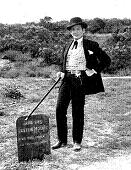
On Oct. 8, 1958 (Wed.) the Western series Bat Masterson debuts on NBC-TV for 107 episodes (until June 1, 1961), starring Gene Barry (Eugene Klass) (1919-2009) as the Wild West gambler dandy marshal who dresses in expensive East Coast clothing and often uses his cane instead of his gun.

On Mar. 18, 1959 Howard Hawks' Rio Bravo (Warner Bros.) debuts, shot in Tucson, Ariz., starring John Wayne as Presidio County, Tex. sheriff John T. Chance, Dean Martin as his drunken deputy Dude, John Russell and Claude Akins as ranchers Nathan and Joe Burdette, Ward Bond as wagon train boss Pat Wheeler, Walter Brennan as gimpy deputy Stumpy, Angie Dickinson as Feathers, and Ricky Nelson as Colorado Ryan, who performs the song "Get Along Home, Cindy".
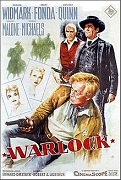
On Apr. 1, 1959 Edward Dmytryk's Warlock (The Man with the Golden Colts) (20th Cent. Fox) debuts, a Western based on the 1958 novel by Oakley Hall about a town called Warlock in early 1880s Utah (really Tombstone, Ariz.), which Hollywood Ten member Dmytryk turns into a commentary on the witch-hunting of HUAC, starring Richard Widmark, Henry Fonda, Anthony Quinn, and DeForest Kelley.
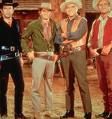
On Sept. 12, 1959 (Sat.) the TV series Bonanza debuts on NBC-TV for a whopping 430 episodes (until Jan. 16, 1973), becoming the first network TV series in color and first color Western on TV, reaching #1 in1964-7 after it switches to Sun. nights in 1961; its plot echoes real events in Nevada exactly 100 years earlier, and stars Lorne Greene (Lyon Hilman Green) (1915-87) as rich trice-widowed Swedish immigrant landowner Ben "Pa" Cartwright, who owns the 600K acre Ponderosa ranch situated between Lake Tahoe, Virginia City, and Carson City S of Reno, Pernell Roberts (1928-2010) (last to die) as eldest son Adam Cartwright, Dan Blocker (1928-72) as middle son Eric "Hoss" Cartwright, and Michael Landon (Eugene Maurice Orowitz) (1936-91) as youngest son Joseph "Little Joe" Cartwright (after the role is turned down by Robert Blake), going on to experiment with social injustice themes as far as sponsors would allow; San Francisco, Calif.-born Victor Sen Yung (1915-80) plays Chinese cook Hop Sing.

In Sept. 1959 the Hanna-Barbera animated series The Quick Draw McGraw Show debuts in syndication for 45 episodes (until 1962), starring the voice of Daws Butler, who also voices his sidekick debuty Baba Looey (a Mexican burro) and his bloodhount Snuffles; another segment features Butler vocing the dachshund Augie Doggie, and Doug Young voicing his father Doggie Daddy.

On Oct. 1, 1959 the B&W Western TV series Law of the Plainsman debuts on NBC-TV for 30 episodes (until May 5, 1960), starring Michael Ansara as U.S. Deputy Marshal Sam Buckhart, an Apache who saved the life of a U.S. Cavalry officer, who left him money to go to Harvard U.
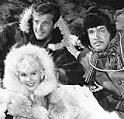
On Oct. 4, 1959 (Sun.) the Western series The Alaskans debuts on ABC-TV for 37 episodes (until June 19, 1960), starring Roger George Moore (1927-) in his first U.S. TV role as Silky Harris, who with buddy Reno McKee (Jeff York) tries to swindle travellers bound for the Yukon during the Klondike Gold Rush in Skagway, Alaska, while hooking up with Rocky Shaw (Dorothy Provine) (whom he hooks up with off-camera).
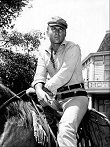
On Oct. 4, 1959 (Sun.) the B&W Goodson-Todman Western TV series The Rebel debuts on ABC-TV for 76 episodes (until June 18, 1961), starring Nick Adams (1931-68) as Confed. Army vet Johnny Yuma, who roams the Am. West esp. Tex. to fight injustice with his dead daddy's sawed-off double-barreled shotgun while keeping a journal.
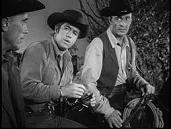
On Sept. 10, 1960 (Sat.) the B&W Western series The Tall Man debuts on NBC-TV for 75 episodes (until Sept. 1, 1962), set in Lincoln, N.M., starring 6'3" Patrick Barry Sullivan (1912-94) as Sheriff Pat Garrett, and William Martin "Clu" Gulager (1928-) as Billy the Kid (William H. Bonney); an episode depicting Garrett killing the Kid is never filmed.
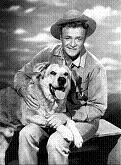
On Sept. 30, 1960 Sam Peckinpah's highbrow B&W Western series The Westerner debuts on NBC-TV for 13 episodes (until Dec. 30, 1960), starring Brian Keith (1921-97) as drifter cowhand Dave Blassingame, who ditches his dog Brown (Spike of "Old Yeller" fame, trained by Frank Weatherwax) after stealing a lost govt. payroll.
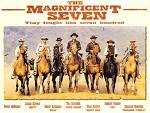
On Oct. 23, 1960 John Sturges' Western The Magnificent Seven (Mirisch Co.) (United Artists) debuts, based on Akira Kurosawa's 1954 film "Seven Samurai" set in a Mexican village, starring Russian-born Yul Brynner as Chris Adams, New York City-born Jewish actor Eli Wallach as bandit leader Calvera, Steve McQueen as Vin, Charles Bronson as Bernardo O'Reilly, Robert Vaughan as Lee, James Coburn as knife-throwing Britt, Brad Dexter as Harry Luck, German-Am. actor Horst Buchholz as Chico, and Rosenda Monteros as Petra; Robert J. Wilke fights Britt in a knife-vs.-gun battle; Chris and Vin charge to the cemetery in a hearse; Russian-born Vladimir Sokoloff plays the wise old man; musical score by Elmer Bernstein; remade in 2016.



On Nov. 16, 1960 Am. "Rhett Butler in Gone With the Wind" actor Clark Gable (b. 1901) dies in Hollywood, Calif. of a heart attack a few days after the film "The Misfits" wraps; "He was as masculine as any man I've ever known, and as much a little boy as a grown man could be; it was this combination that had such a devastating effect on women" (Doris Day); on Feb. 1, 1961 John Huston's The Misfits (Seven Arts Productions), written by Arthur Miller for his wife Marilyn Monroe debuts on the birthday of dead star Clark Gable (as Gay Langland), who woos Marilyn Monroe (as Roslyn Taber) and tries to catch wild mustangs near Reno along with rodeo rider Montgomery Clift (as Perce Howland) while she pussy-whips them into letting them go so they won't end up as dog food; Eli Wallach plays Guido, and Thelma Ritter plays Isabelle Steers: Gable wears a snap-style Western shirt manufactured in Denver, Colo. by Rockmount Ranch Wear, founded by future centenarian Jack A. Weil (1901-2008), which has been marketing them since the 1950s; they are later worn by Elvis, Bob Dylan, Ronald Reagan, Nicolas Cage et al.; Monroe's drug and pill habit and cheating ways finally cause Miller to divorce her after the filming, and marry Austrian-born photographer Inge Morath (1923-2002) on Feb. 17, 1962. On July 23, 1966 Am. actor Montgomery Clift (b. 1920) dies in New York City of heart failure after uttering his last words: "Absolutely not" when asked if he wants to watch "The Misfits".

On Mar. 30, 1961 Marlon Brando's One-Eyed Jacks (Paramount Pictures) debuts, written by Sam Peckinpah et al. loosely based on "The Authentic Death of Hendry Jones" by Charles Neider (1956), set in 1880s Sonora, Mexico and Monterrey, Calif., starring Brando (in his dir. debut) and Karl Malden as gringo bank robbers Rio and Daddy Longworth, who fall out after mentor Longworth leaves him in the lurch to steal two sacks of gold, allowing Rio to be captured by the Rurales and suffer five years in the stinkin' pen, after which he escapes to track him down, finding out he went straight and became a sheriff using the loot, resulting in a deadly cat-and-mouse game; meanwhile Rio falls in love with Longworth's stepdaughter Louisa (Pina Pellicer), complicating things; also stars Ben Johnson as Rio's crooked new partner Bob Emory, and Slim Pickens as weasly deputy sheriff Lon Dedrick, who has the hots for Louisa; Katy Jurado plays Maria "Mother" Longworth, and Larry Duran plays Rio's partner Chico Modesto; the way this Western turns a lying, back-shooting, bank-robbing villain into a killer hero is later copied by Sergio Leone et al.; Brando fired original dir. Stanley Kubrick; "You're a one-eyed jack around here, Dad, I seen the other side of your face" (Rio); does $4.3M box office on a $6M budget.

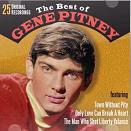
On Apr. 22, 1962 John Ford's The Man Who Shot Liberty Valance (Paramount Pictures) debuts, based on a 1953 short story by Dorothy M. Johnson, becoming the last of John Ford's B&W Westerns (the last great film of the Golden Age of Movies?), starring John Wayne as rancher Tom Doniphon of Shinbone, James Stewart as inept Eastern lawyer Ransom "Ranse" Stoddard, Vera Miles as his babe Hallie, and Lee Marvin as badass outlaw Liberty Valance, who Doniphon shoots and kills from a hidden position to make it look like Stoddard did it, causing him to become a hero and rise to state gov. and U.S. sen.; does $8M box office on a $3.2M budget; the hit Hal David-Burt Bacharach theme song The Man Who Shot Liberty Valance by Gene Pitney (1940-2006) is released after the film comes out; first movie where John Wayne uses the word "pilgrim", which becomes a standard for Wayne impersonators; "This is the West, sir. When the legend becomes a fact, print the legend"; offscreen Ford needles Wayne for not serving in WWII while Stewart was a war hero, with "How rich did you get while Jimmy was risking his life?"; "When Liberty Valance rode to town the womenfolk would hide, they'd hide/ When Liberty Valance walked around the men would step aside/ 'cause the point of a gun was the only law that Liberty understood/ When it came to shootin' straight and fast - he was mighty good/ From out of the East a stranger came, a law book in his hand, a man/ The kind of a man the West would need to tame a troubled land/ 'cause the point of a gun was the only law that Liberty understood/ When it came to shootin' straight and fast - he was mighty good./ Many a man would face his gun and many a man would fall/ The man who shot Liberty Valance, he shot Liberty Valance/ He was the bravest of them all" - gives Lee Harvey Oswald ideas, or LBJ?
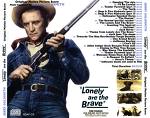
On May 24, 1962 David Miller's Western Lonely Are the Brave (Universal Pictures) debuts, written by Dalton Trumbo based on the 1956 Edward Abbey novel "The Brave Cowboy", starring Kirk Douglas (his favorite movie) as cowboy John W. "Jack" Burns, who arranges to get locked up in jail to escape with old friend Paul Bondi (Michael Kane), who doesn't want to escape, so Burns goes it alone on his horse Whisky while being chased by Sheriff Morey Johnson (Walter Mattthau); Gena Rowlands plays Bondi's wife Jerry.

On June 20, 1962 Sam Peckinpah's Ride the High Country (Guns in the Afternoon) (MGM) debuts, starring Joel McCrea as Gil Westrum, an ex-lawman hired to transport gold through dangerous territory, only to find that out his partner Gil Westrum (Randolph Scott) is going to doublecross him.
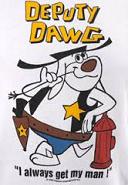
On Sept. 8, 1962 Terrytoons' animated series Deputy Dawg debuts on CBS-TV for 34 episodes (until May 25, 1963), about Fla. deputy sheriff Deputy Dawg (voiced by Dayton Allen), and "varmints" Muskie Muskrat, Moley Mole, Possible Possum, Ty Coon, Vincent van Gopher, and Pig Newton.
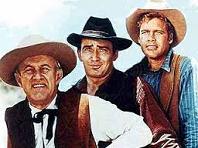
On Sept. 19, 1962 the color Western series The Virginian (The Men from Shiloh) debuts on NBC-TV for 249 episodes (until Mar. 24, 1971), based on the 1902 Owen Wister novel and set in 1898, starring James Child Drury Jr. 91934-) as the tough foreman of the Shiloh Ranch in Medicine Bow, Wyo., known only as the Virginian, and Douglas Osborne "Doug" McClure (1935-95) as top hand Trampas; Lee J. Cobb (Leo Jacob) (1911-76) plays ranch owner Judge Garth.

On Feb. 20, 1963 John Ford's and Henry Hathaway's and George E. Marshall's How the West Was Won (Cinerama Releasing Corp.) (MGM) (164 min.) debuts, written by James R. Webb and John Gay, about three generations of a New England farm family heading West starting in 1839 thru 1889 incl. the Erie Canal, U.S. Civil War, frontier Colo., and transcontinental railroad, and finishing with aerial shots of freeways in modern L.A., featuring an impressive cast list, incl. John Wayne (as Gen. William Tecumseh Sherman), James Stewart, Henry Fonda, Gregory Peck, Debbie Reynolds, Walter Brennan, Robert Preston, Eli Wallach, and George Peppard; "This land has a name today, and is marked on maps, but the names and the marks and the maps all had to be won, won from Nature and from primitive man"; "24 great stars in the mightiest adventure ever filmed!"; does $50M box office on a $14.48M budget.
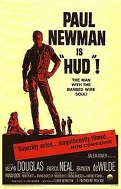
On May 29, 1963 Martin Ritt's B&W Hud (Paramount Pictures) debuts, filmed on location in the Tex. Panhandle incl. Claude, Tex., starring Paul Newman as alienated youth Hud Bannon, Melvyn Douglas as his stern daddy Homer Bannon, and Patricia Neal as neighbor Alma Brown, whom he assaults; does $10M box office on a $2.35M budget; "The man with the barbed wire soul"; "I always say the law was meant to be interpreted in a lenient manner."
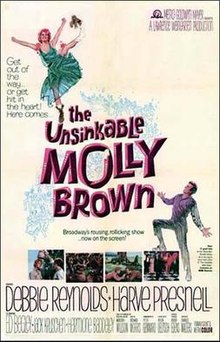
On June 11, 1964 Charles Walters' The Unsinkable Molly Brown (MGM) debuts, written by Helen Deutsch based on the 1960 Meredith Willson and Richard Morris musical, starring Debbie Reynolds (after Shirley MacLaine pulls out) as Molly Brown, and Harve Presnell as her wealthy hubby Johnny Brown; exteriors are filmed in the Black Canyon of the Gunnison Nat. Park in Colo.; does $11M box office.
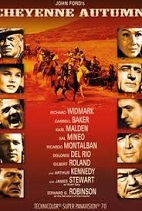
On Oct. 3, 1964 John Ford's Cheyenne Autumn (Warner Bros.) (Ford's 101st film of 102, and last Western) debuts, based on the 1941 Howard Fast novel "The Last Frontier" based on a true story by Mari Sandoz about 300 Cheyennes migrating from Okla. to Wyo. in 1878-9, a rare Ford Western sans Wayne, starring Richard Widmark as Capt. Thomas Archer, James Stewart as Wyatt Earp, Carroll Baker as pacifist Quaker schoolteacher (Archer's babe) Deborah Wright, Edward G. Robinson as U.S. interior secy. Carl Schurz, and Sal Mineo as Red Shirt; does $3.5M box office on a $4M budget.

On Oct. 20, 1964 Sergio Leone's A Fistful of Dollars (Per un Pungo di Dollari) (United Artists) (a remake of Akira Kurosawa's 1961 "Yojimbo") debuts, launching the made-in-Spain Spaghetti Western genre where the good guy is no longer good, and makes a star of San Francisco, Calif.-born Clinton "Clint" Eastwood Jr. (1930-), who plays the cheeroot-chomping "Man with No Name", dealing death with his never-failing guns and doing that patented thing with his face and eyes that says steely rage as he plays the Baxters off against the Rojos in San Miguel with the help of coffin maker Piripero (Joseph Egger) and saloonkeeper Salvanito (Jose Calvo); Charles Bronson turned down Eastwood's part; does $14.5M box office on a $225K budget; the wistful rockish Fistful of Dollars Theme by Italian composer Ennio Morricone (1928-) is influenced by the guitar style of Dick Dale, and scores the sequels, incl. For a Few Dollars More (1965), The Good, the Bad, and the Ugly (1966), comprising the Dollars Trilogy, and Once Upon a Time in the West (1968).

In Dec. 1964 after giving his seat to J.P. "the Big Bopper" Richardson on the Day the Music Died, former bass player for Buddy Holly, Littlefield, Tex.-born Waylon Arnold Jennings (1937-2002), known for adopting the Lubbock Sound of Buddy Holly and the Red Dirt sound of Stillwater, Okla. releases his debut album Waylon at JD's. In 1969 he marries country singer Jessi Colter. In 1971 he releases the album Cedartown, Georgia, which features Cedartown, Georgia (#14 country). In Feb. 1972 after going outlaw, he releases the album Good Hearted Woman (RCA Records), which features Good Hearted Woman (co-written by Willie Nelson), followed in 1972 by Ladies Love Outlaws (RCA Records) (#11 country), coining the term outlaw for country music; it features Under Your Spell Again (w/Jessi Colter) (#39 country). In July 1973 he releases the album Honky Tonk Heroes (#14 country), with almost all of the songs co-written by Billy Joe Shaver, injecting a rock & roll attitude into Nashvilly honky tonk music; it features You Ask Me To (#8 country), and We Had It All (#28 country). Album #22 Dreaming My Dreams (June 1975) (#1 country) features Dreaming My Dreams with You (by Allen Reynolds) (#10 country), and Are You Sure Hank Done It This Way (#1 country). On Jan. 12, 1976 he releases the album Wanted! The Outlaws with Willie Nelson, Jessi Colter, and Tompall Glaser, reaching #1 on the country charts and #10 on the pop charts, becoming the first platinum country music album, featuring the singles Suspicious Minds (#2) and Good Hearted Woman (#1). In Jan. 1978 he and Willie Nelson release the album Waylon & Willie (#1 country) (#12 in the U.S.), which features Mamas Don't Let Your Babies Grow Up to Be Cowboys (#1 country), Lookin' for a Feeling (#1 country), I Can Get Off on You (#1 country), The Wurlitzer Prize (I Don't Want to Get Over You) (#1 country), and If You Can Touch Her At All (#5 country). In Sept. 1978 he releases the album I've Always Been Crazy (#1 country) (#48 in the U.S.), which features I've Always Been Crazy.
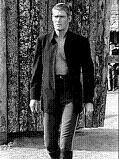
On Jan. 24, 1965 (Sun.) (8:30 p.m.) the Western series Branded debuts on NBC-TV for 48 episodes (until Sept. 4, 1966), starring Kevin Joseph "Chuck" Connors (1921-92) as U.S. Army Cavalry Capt. Jason McCord, who was drummed out of the service for a false charge of cowardice; features the Branded Theme by Dominic Frontiere and Alan Alch; "All but one man died...There at Bitter Creek...and they say he ran away./ Branded! Marked with a coward's shame./ What do you do when you're branded, will you fight for your name?/ He was innocent . . . not a charge was true . . . but the world would never know./ Branded! Scorned as the one who ran./ What do you do when you're branded, and you know you're a man?/ Wherever you go for the rest of your life you must prove ... you're a man."
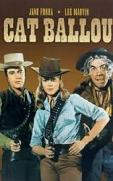
On June 24, 1965 Elliot Silverstein's Cat Ballou (Columbia Pictures) debuts, starring Lee Marvin (after Kirk Douglas turns it down) as gunfighter twins Kid Shelleen and Tim Strawn, Jane Fonda (after Ann-Margret's mgr. turns it down without her knowledge) as Catherine "Cat" Ballou, John Marley as her father Frankie Ballou, Michael Callan as cattle rustler Clay Boone, Dwayne Hickman as his uncle Jed, Nat King Cole (who dies of lung cancer 4 mo. before release) as Shouter, and Bruce Cabot as Sheriff Maledon; does $20.6M box office.
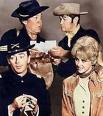
On Sept. 14, 1965 (Tues.) the wacky Western sitcom F-Troop debuts on ABC-TV for 65 episodes (until Apr. 6, 1967), starring Kenneth Ronald "Ken" Berry (1933-) as U.S. Army Pvt. Wilton Parmenter, "the Scourge of the West", who won a Medal of Honor for instigating the final charge at the Apr. 9, 1865 Battle of Appomattox by sneezing and being mistaken for giving the order to charge, getting him a promotion to capt. in charge of remote Ft. Courage, a dumping ground for goof-offs, incl. Sgt. Morgan Sylvester O'Rourke, played by 6'4" actor Forrest Tucker (1919-86), and Corp. Randolph Agarn, played by Lawrence Samuel "Larry" Storch (1923-), who deal with the local Hekawi ("Where the heck are we?") Indian tribe (played mainly by Yiddish comedians as an in-joke that they're the 13th tribe of Israel), while Parmenter's babe, shopkeeper "Wrangler" Jane Angelica Thrift, played by Melody Patterson (1949-) (who is only 16-y.-o. when the series starts) is always trying to hook him into marriage.
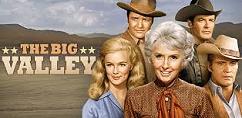
On Sept. 15, 1965 (Wed.) the Western series The Big Valley debuts on ABC-TV for 112 episodes (until May 19, 1969), starring Barbara Stanwyck (Ruby Catherine Stevens) (1907-90) as wealthy widow Victoria Barkley who owns the Barkley Ranch in Calaveras County, Calif. near Stockton, based on the 30K acre Hill Ranch (1955-1931), her sons Jarrod Thomas Barkley (atty.), played by Richard Long (1927-74), Nicholas Jonathan "Nick" Barkley, played by Joseph Peter Breck (1929-2012), known for dressing in black, and Heath Barkley, played by Lee Majors (Harvey Lee Yeary) (1939-), and her daughter Audra Barkley, played by Linda Evans (1942-).
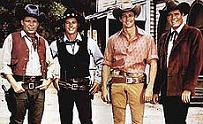
On Sept. 16, 1965 (Thur.) the Western color series Laredo debuts on NBC-TV for 56 episodes (until Apr. 7, 1967) as a spinoff from "The Virginian", set in Laredo, Tex., starring Lawrence Neville Brand (1920-92) as Texas Ranger Reese Bennett, Peter Brown (Pierre Lind de Lappe) (1935-) as Texas Ranger Chad Cooper, 6'2" bodybuilder William Smith (1933-) as Texas Ranger Joe Riley, and Eugene Joseph "Philip" Carey (1925-2009) as Capt. Edward Parmalee; 14-y.-o. Kurt Russell appears in an episode as Indian boy Grey Smoke.

On Sept. 17, 1965 (Fri.) the semi-wacky Old Western spy show ("James Bond on horseback") The Wild Wild West debuts on CBS-TV for 104 episodes (until Apr. 4, 1969), starring handsome athletic playboy Robert "Bob" Conrad (Conrad Robert Norton Falk) (1935-) as Secret Service agent James West, and Polish-Am. Jewish actor Ross Martin (1920-81) as his partner Artemus Gordon, a master of easy-to-see-thru disguises and Shakespearean ham, who protect Pres. Ulysses S. Grant from Victorian mad scientists while travelling in their own luxury train "Wanderer".
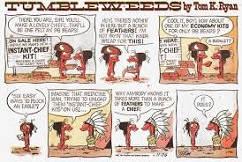
In Sept. 1965 the wacky Old West comic strip Tumbleweeds by Tom K. "T.K." Ryan (1926-) debuts in the Register and Tribune Syndicate, later acquired by the King Features Syndicate; set in Grimy Bulch (pop. 49), the nearby village of the Poohawk tribe, and U.S. Army Ft. Ridiculous, manned by the 6/7/8 Cavalry, it chronicles the life of lazy cowboy Tumbleweeds, who is always running from Hildegard Hamhocker, his first horse Blossom, second horse Epic, best pal (prof. gambler) Ace, yo-yo-carrying Deputy Knuckles, handlebar-mustachioed Sheriff, for-sale Judge Horatio Curmudgeon Frump, Tex. lawman Quiet Burp, Hildegard's adopted niece Echo and her lazy dog Pajamas, undertaker Claude Clay and gravedigger Wart Wimble; "Garfield" creator is Ryan's asst. in 1969-78; the series ends on Dec. 30, 2007.
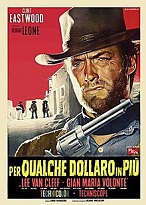
On Dec. 30, 1965 Sergio Leone's For a Few Dollars More ("Per qualche dollaro in piu") (United Artists) debuts, #2 in the Dollars Trilogy, starring Clint Eastwood ("the Man with No Name"), Lee Van Cleef ("the Man in Black), Gian Maria Volonte ("El Indio") (known for smoking weed and playing his musical pocketwatch when he wants to kill somebody), and Klaus Kinski; does $15M on a $600K budget; "Where life had no value, death, sometimes, had its price. That is why the bounty killers appeared".

In 1965 Providence, R.I.-born Cormac (Charles) McCarthy (1933-) pub. his first novel The Orchard Keeper In 1968 he pub. Outer Dark. In 1973 he pub. Child of God, about an E Tenn. backwoodsman who is a necrophiliac murderer. In 1979 he pub. Suttree, a semi-autobio. novel about Cornelius Suttreee in 1951 Knoxville, Tenn. In 1985 he pub. Blood Meridian, or the Evening Redness in the West; the Kid vs. the scalp-hunting Glanton Gang in the Mexican borderlands in 1849-50; Judge Holden; based on Samuel Chamberlain's "My Confession"; his masterpiece? In May 1992 he pub. All the Pretty Horses, the first of the Border Trilogy ("The Crossing", "Cities of the Plain"); bestseller; 16-y.-o. cowboy John Grady Cole moves from Tex. to Mexico with best friend Lacey Rawlins, meet Jimmy Blevins, and Alejandra, whom Cole hooks up with. In June 1994 he pub. The Crossing, 2nd in the Border Trilogy; teenie cowboy Billy Parham and his younger brother Boyd hunt a pregnant female wolf. On May 12, 1998 he pub. Cities of the Plain, last in the Border Trilogy; John Grady Cole meets Billy Parham in 1952, and Cole tries to rescue ho Magdalene in Juarez by taking on Eduardo. In 2005 he pub. No Country for Old Men; title comes from the poem Sailing to Byzantium by William Butler Yeats; Vietnam vet Llewelyn Moss discovers a cache of $2M drug money in big bad Tex. near the Mexican border, causing its owners to send killer Anton Chigurh (the next Hannibal Lecter?); filmed in 2007. In 2006 he pub. his 10th novel The Road, which wins a Pulitzer Prize; the Veteran, the Wife, and the Son try to survive in the apocalyptic remains of cannibal-filled Appalachia; his take on "The Road Warrior"?
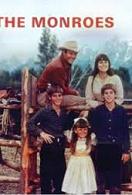
On Sept. 7, 1966 (Wed.) the Western series The Monroes debuts on ABC-TV for 26 episodes (until Mar. 15, 1967), starring set in Grand Teton Nat. Park near Jackson, Wyo., about five orphans trying to survive after their parents die in an accident, starring English actor Michael Joseph Anderson Jr. (1943-) as eldest male Clayton Monroe, and Barbara Hershey (Barbara Lynn Herzstein) (1948-) as eldest female Kathy Monroe.

On Sept. 12, 1966 (Mon.) the Western series The Iron Horse debuts on ABC-TV for 47 episodes (until Jan. 6, 1968), filmed on the Sierra Railroad in Sonora, Calif., starring Daryl Lymoine "Dale" Robertson (1923-2013) as gambler Ben Calhoun, who wins the incomplete Buffalo Pass, Scalplock & Defense Railroad in a poker game.
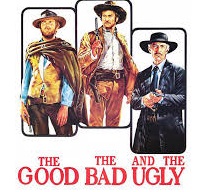
On Dec. 23, 1966 Sergio Leone's The Good, the Bad and the Ugly (Il Buono, il Brutto, il Cattivo) (cattivo means bad and brutto ugly) debuts, #3 in the made-in-Spain Dollars Trilogy, starring Clint Eastwood as the Man with No Name (Good), Elich Wallach as bandito Tuco Benedicto Pacifico Juan Maria Ramirez (who calls Eastwood "Blondie") (Ugly), and Eli Wallach as the Man in Black (whom Tuco calls "Angel Eyes") (Bad) (Bad and Ugly are mixed-up in the English vers. because the English title has the words reversed), who get in a struggle to find some stolen Confed. gold in a cemetery in a grave in Sad Hill marked Unknown next to Arch Stanton's, passing through Betterville POW Camp (based on Andersonville); the ensemble of Italian actors who play Union and Confed. soldiers and U.S. and Mexican citizens plus 1.5K Spanish militia members in a Spanish setting gives the whole movie an eerie unreality, adding to the effect of the futility of the U.S. Civil War; "the best-directed film of all time" (Quentin Tarantino); does $25.1M box office on a $1.2M budget; banned in Norway until 1982; Ennio Morricone's Theme from The Good, the Bad, and the Ugly is a hit; Leone, who is lax on safety at the set tops himself when Wallach drinks from a bottle of acid left accidentally next to his soda bottle by a studio technician, after which his horse runs away with him for a mi., and then he is almost decapitated by an iron step on a railroad car; the bridge that is blown up onscreen is first blown up by accident and has to be rebuilt.
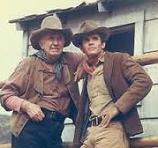
On Sept. 8, 1967 (Fri.) the Western series The Guns of Will Sonnett debuts on ABC-TV for 50 episodes (until Sept. 16, 1969), starring Walter Andrew Brennan (1894-1974) as "No brag, just fact" Will Sonnett, and Dack Rambo (Norman Jay Rambeau) (1941-94) as his grandson Jeff, who are searching for Will's son (Jeff's father) James.
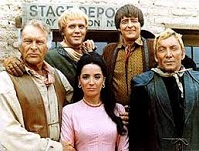
On Sept. 10, 1967 (Sun.) David Dortort's Western series The High Chaparral debuts on NBC-TV for 98 episodes (until Mar. 12, 1971), starring Leif Erickson (William Wycliffe Anderson) (1911-86) as "Big John" Cannon, a rancher in 1870s Arizona who runs the High Chapparal Ranch with his brother Buck Cannon, played by Cameron Mitchell (Cameron MacDowell Mitzell) (1918-94), and his son Billy Blue Cannon (Blue Boy), played by Mark Van Blarcom Slade (1939-).
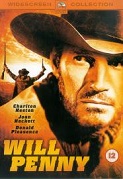
On Feb. 16, 1968 Tom Gries' Will Penny (Paramount Pictures) debuts, starring Charlton Heston as an aging loner bad penny cowboy who gets hooked by love-hungry Catherine Allen (Joan Hackett) while fighting off the Quint family led by Preacher Quint (Donald Pleasence); a box office flop, although Heston considers it his best work?; also features Ben Johnson, Lee Majors, Bruce Dern, Slim Pickens, and Anthony Zerbe; does $1.8M box office on a $1.4M budget.

On Aug. 3, 1968 Ted Post's Hang 'Em High (United Artists) debuts, starring Clint Eastwood (the first production of his new Malpaso Co., named after a creek near his home of Carmel, Calif.) as ex-lawman Jed Cooper, who is wrongly lynched in 1889 Okla. Territory, then becomes a U.S. marshal and goes after the nine lynchers led by Capt. Wilson (Ed Begley), incl. Stone (Alan Hale Jr.), Charlie Blackfoot (Ned Romero), and weasly Miller (the real killer) (Bruce Dern); Inger Stevens plays widow Rachel Warren, who helps him, and Pat Hingle plays Eastwood's new boss, hanging judge Adam Fenton (based on Hanging Judge Isaac Parker of Ft. Smith, Ark.); Dennis Hopper plays the Prophet; a scene between Stevens and Eastwood where he kisses her and she doesn't seem to be turned on, then explains that she was raped by white men has an eerie meaning in the light of the fact that she secretly goes for black er, guys and ends up committing suicide?; does $6.8M box office on a $1.6M budget; watch trailer.
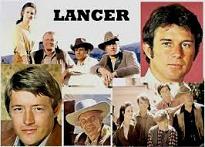
On Sept. 24, 1968 (Tues.) the Bonanza-wannabe Western color series Lancer debuts on CBS-TV for 51 episodes (until June 23, 1970), starring Andrew Duggan (1923-88) as Lancer family patriarch Murdoch Lancer, James "Jim" Stacy (Maurice William Elias) (1936-) as half-Mexican gunslinger son Johnny Madrid Lancer, and Wayne E. Maunder (1937-) as educated older son Scott Lancer.


On Dec. 21, 1968 Sergio Leone's Once Upon A Time in the West (C'era una Volta il West) (Paramount Pictures) debuts, a Spaghetti Western about a band of ruthless gunmen trying to murder mysterious widow Jill McBain (Claudia Cardinale) in desert town Sweetwater, filmed in Italy, Spain, and Monument Valley, Ariz., casting Henry Fonda against type as villain Frank, while smiling harmonica-playing Charles Bronson is cast as leading man Harmonica (after Clint Eastwood turns it down, reversing the situation in "A Fistful of Dollars"); Jason Robards plays bandit Cheyenne; features some of the longest opening credits ever; musical score by Ennio Morricone; big hit in Europe, but a flop in the U.S.; Canadian actor Al Mulock (1925-68), who had a part in this movie and "The Good, the Bad and the Ugly" jumps from a hotel window in full movie costume and commits suicide in Guadix, Spain in May 1968.

On June 11, 1969 (Chinese Year of the Rooster) Henry Hathaway's True Grit (Paramount Pictures) debuts, written by Marguerite Roberts based on the 1968 Charles Portis novel and filmed in Ridgway, Colo., starring John Wayne as cranky alcoholic U.S. deputy marshal Reuben J. "Rooster" Cogburn, and Kim Darby as 14-y.-o. ingenue Mattie Ross of Dardanelle, Yell County, Ark., who hires him to find her daddy's killer Tom Chaney (Jeff Corey), telling him "They tell me you are a man with true grit"; after a trek joined by Texas Ranger La Boef (Glen Campbell) (after Elvis turned down the part because they wouldn't give him top billing), she finds, shoots and wounds him in Indian Territory (Okla.), is taken prisoner by the Pepper gang, led by Lucky Ned Pepper (Robert Duvall), and Cogburn takes them on single-handed in the movie's climax: "I call that bold talk for a one-eyed fat man" (Ned Pepper); "Fill your hand, you son of a bitch!" (Cogburn); spawns 1975 sequel "Rooster Cogburn"; refilmed in 2010 by the Coen Brothers.
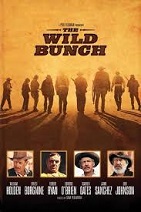
On June 18, 1969 Sam Peckinpah's The Wild Bunch (Warner Bros.) debuts, written by Walon Green and Roy N. Sickner stars William Holden, Robert Ryan, Ernest Borgnine, Warren Oats, Strother Martin et al. in a Western masterpiece (greatest of all time?) about aging outlaws with a sense of justice on a final rampage against time itself, using lyrical slo-mo ballet-like photography of violence; does $11.1M box office on a $6M budget.
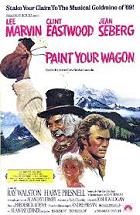
On Oct. 15, 1969 Joshua Logan's Western musical Paint Your Wagon (Paramount Pictures) debuts, based on the 1951 Lerner-Loewe musical, starring singing Lee Marvin and singing Clint Eastwood, who share Mormon wife Jean Seberg, whose singing is dubbed; does $31.7M box office on a $20M budget; features the songs They Call the Wind Maria, and I Was Born Under a Wandering Star.

On Oct. 24, 1969 George Roy Hill's Butch Cassidy and the Sundance Kid (20th Cent. Fox) debuts, written by William Goldman, starring Paul Newman (Butch) and Robert Redford as Am. Wild West outlaws going on the lam in Bolivia with school teacher Etta Place (Katharine Ross), while the hit song "Raindrops Keep Falling on My Head" plays; Redford has a fistfight with "Lurch" actor Ted Cassidy; #1 grossing film of 1969 ($102.3M box office in the U.S. on a $6M budget).
In the late 1960s the Outlaw Country Music movement is founded as a reaction to the Bakersfield Sound and law in order in general by ex-con Johnny Cash, Waylon Jennings, Merle Haggard, Kris Kristofferson, Willie Nelson, ex-con David Allan Coe, the Eli Radish Band et al., and named after David Allan Coe, a member of the Outlaws Motorcycle Club.
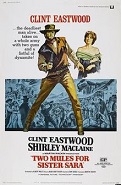
On June 16, 1970 Don Siegel's Two Mules for Sister Sara (The Malpaso Co.) (Universal Pictures) debuts, starring Clint Eastwood as ex-Civil War soldier Hogan, and Shirley MacLaine (who replaced Elizabeth Taylor) as a nun, who get in an adventure over a French fort in Mexioo and then hook up; does $4.7M box office on a $2.5M budget.

On Sept. 16, 1970 (Wed.) McCloud debuts on NBC-TV for 46 episodes (until Apr. 17, 1977), starring Dennis Weaver (1924-2006) as rustic country deputy marshal Sam McCloud from Taos, N.M., who is assigned to NYPD's 21st precinct, and rides his horse through Manhattan traffic wearing a sheepskin coat and Stetson hat, calling it "the most satisfying role of my career."
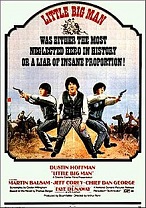
On Dec. 23, 1970 Arthur Penn's Little Big Man (Nat. Gen. Pictures), based on the 1964 Thomas Berger novel stars Dustin Hoffman as 121-y.-o. Jack Crabb, who reminisces about his life starting at age 17, ending with his days with vainglorious golden haired Gen. George Armstrong Custer (Richard Mulligan); Chief Dan George plays Old Lodge Skins, and Faye Dunaway plays Mrs. Louise Pendrake AKA Lulu Kane; takes the Native Am. side against the U.S. Cavalry, indirectly protesting the Vietnam War; Hoffman sets a record for portraying a 104-year age span (until ?); does $31.6M box office on a $15M budget; "Little Big Man was either the most negelected hero in history or a liar of insane proportion!"
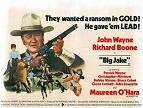
On May 26, 1971 George Sherman's Big Jake (Batjac Productions) (Nat. Gen. Pictures) debuts, written by Harry Julian Fink and Rita M. Fink, filmed in Durango, Mexico, starring John Wayne as Jacob McCandles, Maureen O'Hara as his estranged wife Martha, and Richard Boone as John Fain, leader of a gang of outlaws who wound Big Jake's son Jeff (Bobby Vinton) and kidnap his grandson Little Jake (Ethan Wayne), causing him to go after them along with his sons James (Patrick Wayne) and Michael (Christopher Mitchum, son of Robert Mitchum), and old injun Sam Sharpnose (Bruce Cabot); debuts at the John Wayne Theater at Knott's Berry Farm; Laddie plays Wayne's dog; the last of five films pairing Wayne and O'Hara (first in 1950); "They wanted a ransom in gold. He gave them lead"; does $7.5M on a $4.8M budget.
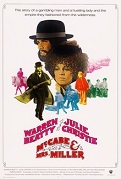
On June 24, 1971 Robert Altman's McCabe & Mrs. Miller (June 24) (Warner Bros.), based on the 1959 Edmund Naughton novel stars Warren Beatty as whorehouse owner John McCabe in the mining town of Presbyterian Church, Wash. in the Old Am. West, and Julie Christie as the opium-addicted British cockney madame Constance Miller, who fight the Harrison Shaughnessy Mining Co. in Bearpaw in a film that's better than it sounds?; does $8.2M box office.

On Jan. 13, 1972 Mark Rydell's The Cowboys (Warner Bros.) debuts, based on the novel by William Dale Jennings, starring John Wayne as aging Mont. rancher Wil Andersen, who loses his regular cowboys to a gold rush and takes a bunch of adolescent cowboys on a 400-mi. cattle drive to Belle Fourche while being pursued by rustlers led by snakey dern ornery ex-con Asa "Long Hair" Watts (Bruce Dern), who gets the delicious unique movie thrill of shooting and killing John Wayne, after which the teenies turn hero-worshipper and get revenge; also stars Roscoe Lee Brown as cook Jebediah Nightslinger, and Colleen Dewhurst as Kate; does $7.5M box office on a $6M budget; "America will hate you for this" (Wayne); "Yeah, but they'll love me in Berkeley" (Dern); the source of the eternal fight between Agent Smith and Mr. Anderson in "The Matrix"?
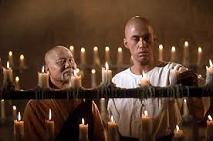
On Oct. 14, 1972 (Sat.) after a full-length pilot on ABC Movie of the Week on Feb. 22 (Tues.), the martial arts Western drama series Kung Fu debuts on ABC-TV for 63 episodes (until Apr. 16, 1975), starring David (John Arthur) Carradine (1936-2009) as peace-loving Shaolin monk Kwai Chang Caine, orphaned son of Am. man Thomas Henry Caine and Chinese woman Kwai Lin, and Keye Luke (1904-91) as blind Master Po (who calls him "grasshopper"), who is murdered by the emperor's nephew, causing Caine to kill him and flee China for the Wild West, where he seeks his half-brother Danny Caine while experiencing anti-Chinese prejudice and kicking lily white ass.

In June 1973 after moving to Nashville in 1960 and recording his first album in 1962, then signing with RCA Victor and joining the Grand Ole Opry in 1965, then moving to Austin, Tex. in 1973 and signing with Atlantic Records, Abbott, Tex.-born ("Red Headed Stranger") Willie Hugh Nelson (1933-) releases his breakthrough album Shotgun Willie (#1 in the U.S.), marking his transition to Outlaw Country Music, which isn't popular with the country music market yet, but gains mainstream acceptance; it features Shotgun Willie (#60 in the U.S.), and Stay All Night (Stay a Little Longer) (#22 in the U.S.). In May 1975 after switching to Columbia Records, he releases his album The Red Headed Stranger (#1 country), which features Blue Eyes Crying in the Rain (#1 country) (#21 in the U.S.), and Remember Me (#2 country) (#67 in the U.S.). On July 18, 1980 he releases the Honeysuckle Rose Soundtrack album (#1 country) (#11 in the U.S.), which features On the Road Again. In 1983 he and Merle Haggard release Pancho & Lefty (by Townes Van Zandt) (#1 country). In 1984 he and Julio Iglesias release To All the Girls I've Loved Before (#1 country) (#5 in the U.S.). Too bad, in 1990 the IRS seizes his assets, claiming he owes them $16M, causing him to release the double album The IRS Tapes: Who'll Buy My Memories? in 1992 to pay them back.
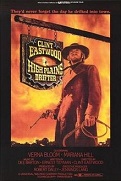
On Aug. 22, 1973 Clint Eastwood's High Plains Drifter (The Malpaso Co.) (Universal Studios) debuts, written by Ernest Tidyman and filmed in Mono Lake, Calif., starring Eastwood as the Drifter, who avenges a sheriff's death in Lago by turning it into Hell; does $15.7M box office on a $5.5M budget.


On Nov. 21, 1973 Michael Crichton's Westworld (MGM), written by Crichton debuts, about the Delos adult amusement park, which costs guests $1K/day to play with the robots, until something goes wrong, and the Gunslinger (Yul Brynner) becomes a Terminator; does $10M box office on a $1.25M budget; "Have we got a vacation for you!" On July 28, 1976 Richard T. Heffron's sequel Futureworld debuts, starring Peter Fonda and Blythe Danner as reporters Chuck Browning and Tracy Ballard, who are invited to tour the new improved Delos robot amusement park, and discover that they're cloning replacements for the visitors; the first feature film to use 3-D computer-generated imagery (CGI); in 1979 it becomes the first modern U.S. film to be screened in Red China.
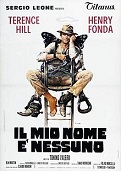
On Dec. 13, 1973 Tonino Valerii's and Sergio Leone's My Name Is Nobody (Il Mio Nome E Nessuno) (Titanus) debuts, a Spaghetti Western set in 1899 New Orleans, La., starring Terence Hill as Nobody, and Henry Fonda as Jack Beauregard; "Jack Beauregard 1848-1899 Nobody was faster on the draw."
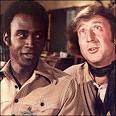
On Feb. 7, 1974 Mel Brooks' Blazing Saddles (Warner Bros.) debuts, a lampoon of Hollywood Westerns, starring Gene Wilder as Jim the Waco Kid, Madeline Kahn as Lili von Shtupp the Teutonic Titwillow, Harvey Korman as Hedley Lamarr (causing Hedy Lamarr to successfully sue), Mel Brooks as Gov. William J. Le Petomane (named after French prof. flatulist Le Petomane), Slim Pickens as Taggart, David Huddleston as Olson Johnson, John Hillerman as Howard Johnson, and Cleavon Little as Sheriff Bart, who likes whippin' it out on white women in an all- white Old West town; dumb strong Mongo (Alex Karras) knocks a horse out with one punch; "Mongo only pawn in game of life"; incl. the Famous Farting Scene ("How about some more beans, Mr. Taggart? I'd say you had enough"); #1 grossing film of 1974 ($119.5M box office on a $2.6M budget).

On Nov. 13, 1974 the TV series The Life and Times of Grizzly Adams debuts on CBS-TV fo 38 episodes (until Feb. 21, 1982), based on the 1974 novel by Charles Edward Sellier Jr. and the 1974 film, starring Dan Haggerty as frontier woodsman James "Grizzly" Adams, who fled into the mountains to escape a false murder rap, and saves orphaned grizzly bear cub Ben, who grows to a huge size and becomes his best friend, along with trader Mad Jack (Denver Pyle) and native American Nakoma (Don Shanks).
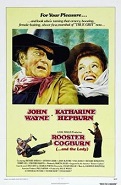
On Oct. 17, 1975 Stuart Millar's Rooster Cogburn (Universal Pictures) debuts, starring John Wayne as an aging 1-eyed U.S. marshal Reuben J. Cogburn in Fort Smith, Indian Territory (Okla.), who has been stripped of his badge by Judge Parker (John McIntire) because he's "gone to seed", and is given one last chance to track some outlaws incl. Hawk (Richard Jordan) and Breed (Anthony Zerbe) while hooking up with spinster Miss Eula Goodnight (Katharine Hepburn); does $17.6M box office on a $10M budget.

On May 18, 1976 Arthur Penn's The Missouri Breaks (United Artists) debuts, starring Marlon Brando as Creedmoor rifle regulator Robert E. Lee Clayton, who is hired by land baron David Braxton (John McLiam) to hunt down bandit Tom Logan (Jack Nicholson) in the Missouri Breaks of NC Mont.; Kathleen Lloyd (film debut) plays daughter Jane Braxton; too bad, too many horses are injured during filming, causing the Am. Humane Assoc. to blacklist it; does $14M box office.

On June 30, 1976 Clint Eastwood's The Outlaw Josie Wales (The Malpaso Co.) (Warner Bros.), based on the 1972 Forrest Carter novel stars Eastwood as Josey, Chief Dan George as Lone Watie, Sondra Locke as Laura Lee, John Russell as Bloody Bill Anderson, and Will Sampson as Ten Bears; does $31.8M box office on a $3.7M budget.

On Aug. 20, 1976 Don Siegel's The Shootist (Paramount Pictures) debuts, based on the 1975 Glendon Swarthout novel, starring John Wayne as aging cancer-stricken gunfighter John Bernard "J.B." Brooks, "the most celebrated shootist extant", who arrives in Carson City, Nev. on Jan. 22, 1901 and laments that the Old West is dying and that he has to have one more gunfight; Lauren Bacall plays widow Bond Rogers, and Ron Howard plays his worshipful son Gillom Rogers; does $13.4M box office; "He's got to face a gunfight once more to live up to his legend once more. To win just one more time."


On Apr. 2, 1978 (Sun.) the super-popular CBS-TV evening soap opera series Dallas debuts for 357 episodes on CBS-TV (until May 3, 1991) becoming a hit in 90 of 91 countries (exception: Japan) with its portrayal of rich and beautiful people who have as many if not more problems than ordinary folk, starring Larry Martin Hagman (1931-2012) as mean slimy Texas oilman John Ross "J.R." Ewing Jr., Linda Gray (1940-) as his alcoholic former Miss Texas wife Sue Ellen, Patrick Duffy (1949-) as his good brother Bobby, Victoria Principal (1950-) as Bobby's wife Pamela Barnes Ewing (Romeo and Juliet?), Jim Davis (1909-81) as patriarch Jock Ewing, Barbara Bel Geddes (1922-2005) as his wife Miss Ellie, Keenan Wynn (1916-86) as Jock's alcoholic ex-partner Digger Barnes, Ted Shackelford (1946-) as Jock's misfit 3rd son Gary, Charlene Tilton (1959-) as Jock's vixen daughter Lucy, Steve Kanaly (1946-) as ranch foreman and everhard stud Ray Krebbs, and Ken Kercheval (1935-) as Pam's brother Cliff Barnes, who spends his life trying to get J.R. for what he did to his daddy Digger; when Davis dies suddenly in 1981, he is portrayed as dying in a plane crash in South Am.; Hagman holds out for more money in 1981, and wins after Robert Culp and Robert Colbert are suggested as his replacements in vain.
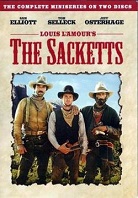
On May 15, 1979 Robert Totten's The Sacketts debuts on NBC-TV, based on the Louis L'Amour novels, starring Tom Selleck as Orrin Sackett, Sam Elliott as Tell Sackett, and Jeff Osterhage as Tyrel Sackett, brothers who leave their Tenn. home to start a new life in Santa Fe, N.M. in 1869; Glenn Ford plays Tom Sunday.
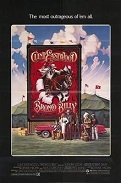
On June 11, 1980 Clint Eastwood's Bronco Billy (Warner Bros.) debuts, starring Eastwood as seedy traveling circus star Bronco Billy McCoy, "the fastest gun in the West", who hires runaway heiress Antoinette Lily (Sondra Locke), who is being chased by wannabe hubby John Arlington (Geoffrey Lewis); does $24.2M box office on a $6.5M budget.

On May 7, 1983 John Badham's WarGames (United Artists) (MGM/UA Entertainment Co.) (originally "The Genius") debuts, starring Matthew Broderick as teenie computer game hacker David Lightman of Seattle, Wash., who stumbles and war-dials into the secret U.S. military WOPR supercomputer in NORAD's Cheyenne Mountain Complex in Colo. Springs, Colo. and almost starts WWII; Ally Sheedy play his babe Jennifer Mack; Dabney Coleman plays NORAD mgr. John McKittrick, and John Wood plays pterosaur-loving Dr. Stephen Falken, who lives on an island in Ore. (really Big Bear Lake 100 mi. E of Los Angeles); spawns the term "war dialing"; grosses $79.6M on a $12M budget (#5); the film causes a mini-scare over the absence of computer security; the final launch code is "CPE1704TKS".

On May 10, 1985 Hugh Wilson's Rustlers' Rhapsody (Paramount Pictures) debuts, a parody of Western singing cowboy films, starring Tom Berenger as Rex O'Herlihan, who comes alive out of a B&W film; co-stars John Wayne's son Patrick Wayne, Andy Griffith, Fernando Rey, Marilu Henner, and Sela Ward; features Lasso the Moon by Gary Morris (#9 country); does $6M box office on a $15M budget.
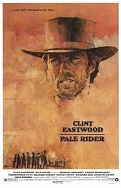
On June 26, 1985 Clint Eastwood's Pale Rider (The Malpaso Co.) (Warner Bros.) stars Clint Eastwood as The Preacher, who rides into the snowy mountain town of Lahood, Calif. and defends a group of prospectors from the thugs of miner Coy LaHood (Richard Dysart) after a prayer by 14-y.-o. Megan Wheeler (Sydney Penny); Carrie Snodgress plays her mother Sarah, and Michael Moriarty plays her beau Hull Baret; does $41.4M box office on a $6.9M budget.
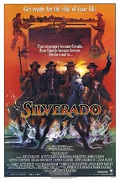
On July 9, 1985 Lawrence Kasdan's Silverado (Columbia Pictures) debuts, about the Wild West town of you know what, starring Kevin Kline as Paden, Scott Glenn as Emmett, Kevin Costner as Jake, Danny Glove as Mal Johnson, and Brian Dennehy as Sheriff Cobb; the score by Bruce Broughton wins a best original score Oscar; does $32.1M box office on a $23M budget.

In 1985 Archer City, Tex.-born Larry Jeff McMurtry (1936-) pub. Lonesome Dove (Pulitzer Prize), about retired Texas Rangers Capt. Augustus "Gus" McCrae and Capt. Woodrow F. Call, who run the Hat Creek Cattle Co. and Livery Emporium in the Tex. border town of Lonesome Dove and decide to drive a herd of cattle to begin the first cattle ranch N of the Yellowstone River and visit Gus' sweetheart Clara on the Platte River near Ogallala Neb.; based on the cattle drive of Charles Goodnight and Oliver Loving, where Loving is attacked by Indians and dies of blood poisoning; turned into a TV miniseries in 1989 starring Robert Duvall and Tommy Lee Jones; followed by "Streets of Laredo", "Dead Man's Walk", and "Comanche Moon".
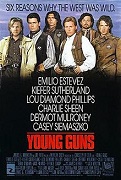
On Aug. 12, 1988 Christopher Cain's Young Guns (Morgan Creek Productions) (20th Cent. Fox), a ripoff of "The Wild Bunch" written by John Fusco and set during the 1877-8 Lincoln County War in N.M. recycles young handsome Brat Packers Emilio Estevez as Billy the Kid, Kiefer Sutherland as Josiah Gordon "Doc" Scurlock, Charlie Sheen as Richard "Dick" Brewer, Lou Diamond Phillips as Jose Chavez y Chavez, and Dermot Mulroney as Dirty Steve Stephens; Terence Stamp plays cattle rancher John Tunstall; does $45.6M box office on an $11M budget; followed by "Young Guns II" (1990).
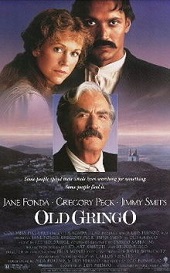
On Oct. 6, 1989 Luis Puenzo's Old Gringo (Columbia Pictures)) debuts, based on the 1985 novel by Carlos Fuentes, starring Gregory Peck as Ambrose Bierce, Jane Fonda as Am. spinster Harriet Winslow, and Jimmy Smits as Pancho Villa's gen. Tomas Arroyo in the 1910 Mexican Rev.; after it is booed in Cannes and Jane Fonda receives a Razzie nominaton for worst actress, it flops, doing $3.5M box office on a $27M budget.
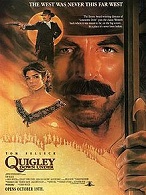
On Oct. 17, 1990 Simon Wincer's Quigley Down Under (MGM) debuts, starring Tom Selleck as Am. cowboy marksman Matthew Quigley, who is hired in Australia by Elliott Marson (Alan Rickman) to eradicate Aborigines but balks and joins them instead, along with Crazy Cora (Laura San Giacomo) from Tex., who calls him Roy; does $21.4M box office on an $18M budget.


On Nov. 21, 1990 Kevin Costner's Dances with Wolves (Majestic Films) (Orion Pictures) debuts, based on the 1988 Michael Blake novel about why palefaces shoulda loved rather than hated the injuns, starring Costner as Civil War Union Lt. John Dunbar, who exiles himself to a remote outpost in Sioux country, and goes injun with white babe Stands With a Fist (Mary McDonnell), Kicking Bird (Graham Greene), Wind In His Hair (Rodney A. Grant), Ten Bears (Floyd "Red Crow" Westerman) et al.; the most pro-Indian Western ever, incl. Sioux language lessons; film score by James Bond Theme man John Barry; #3 movie of 1990 ($185M U.S. and $424M worldwide box office on a $22M budget).

On Aug. 7, 1992 Clint Eastwood's Unforgiven (Warner Bros.) debuts, written by David Webb Peoples, starring Eastwood as aging outlaw William Munny, who takes on one more job along with partner Ned Logan (Morgan Freeman) to avenge a disfigured ho in Big Whiskey, Wyo., and comes up against cruel sheriff Little Bill Daggett (Gene Hackman); Richard Harris plays gunfighter Richard Harris, and Saul Rubinek plays pulp fiction writer W.W. Beauchamp; grosses $159M on a $14.4M budget.

On Dec. 24, 1993 George P. Cosmatos' Tombstone (Hollywood Pictures) debuts, written by Kevin Jarre and shot in Ariz., starring Kurt Russell as Wyatt Earp, Val Kilmer as Doc Holliday, Sam Elliott as Vigil Earp, Bill Paxton as Morgan Earp, Powers Boothe as Curly Bill Brocius, Thomas Haden Church as Billy Clanton, Stephen Lang as Ike Clanton, Michael Biehn as Johnny Ringo, Charlton Heston as Henry Hooker, and John Philbin as Tom McLaury; a little too overdressed and stagy?; does $56.5M box office on a $25M budget; "Justice Is Coming."
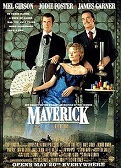
On May 20, 1994 Richard Donner's Maverick (Icon Productions) (Warner Bros.) debuts, starring Mel Gibson as Bret Maverick, the greatest gambler in the West, Jodie Foster as Annabelle Bransford, James Garner (TV's Maverick) as Marshal Zane Cooper, and Graham Greene as Indian Joseph; Mel Gibson's "Lethal Weapon" Danny Glover has a cameo part where he says he's getting too old for this; country singers Clint Black, Carlene Carter, Vince Gill, Waylon Jennings, and Kathy Mattea also cameo; #10 movie of 1994 ($102M box office U.S. and $183M worldwide on a $75M budget).

On Feb. 10, 1995 Sam Raimi's The Quick and the Dead (TriStar Pictures) debuts, starring Sharon Stone as the Lady Ellen, who rides to the frontier town of Redemption to kill its boss John Herod (Gene Hackman), and teams up with Cort (Russell Crowe) and Herod's son Fee "the Kid" (Leonardo DiCaprio); does $18.6M box office on a $35M budget.
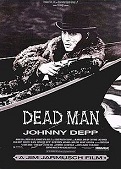
On May 26, 1995 Jim Jarmusch's B&W Dead Man (Miramax Films) debuts, a postmodern "Psychedelic Western" with soundtrack by Neil Young, starring Johnny Depp as meek Cleveland, Ohio accountant William Blake, who arrives in the Western frontier town of Machine to take a new job, only to be chased out by owner John Dickinson, waking up with a bullet lodged in his chest, hooking up with Native Am. Nobody (Gary Farmer); does $1M box office on a $9M budget.
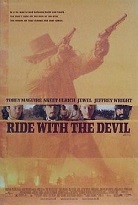
On Nov. 26, 1999 Ang Lee's Ride with the Devil (Universal Pictures) debuts, based on the novel "Woe to Live On" by Daniel Woodrell about the Confed. 1st Mo. Irregulars AKA Bushwackers and the Lawrence Kan. Massacre, starring Tobey Maguire as Jake "Dutch" Roedel, Skeet Ulrich as Jack Bull Chiles, Simon Baker as George Clyde, Jeffrey Wright as freed slave Daniel Holt, and Jewel as Sue Lee; does only $635K box office on a $38M budget.
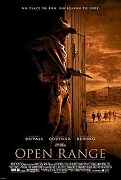
On Aug. 15, 2003 Kevin Costner's Open Range (Touchstone Pictures) (Buena Vista Pictures) debuts, based on the Lauran Paine novel set in 1882 Mont., starring Robert Duvall as Boss Spearman, Kevin Costner as Charley Waite, and Annette Bening as Sue Barlow in a film that tries hard not to look like "Lonesome Dove" and fails; does $68.3M box office on a $22M budget.
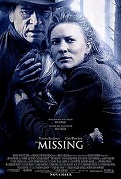
On Nov. 26, 2003 Ron Howard's The Missing (Revolution Studios) (Imagine Entertainment) (Columbia Pictures), based on the 1996 Thomas Edison novel "The Last Ride" stars Tommy Lee Jorenes as Samuel Jones in 1885 N.M., who goes Injun as Chaa-duu-ba-its-iidan then returns to his daughter, medicine woman Magdalena "Maggie" Gilkeson (Cate Blanchett), who doesn't want him back until her daughter Lilly Gilkeson (Evan Rachel Wood) is kidnapped by Apaches who start taking her to Mexico to become a white blonde ho; actors spend long hours studying to speak the Apache language; does $38.4M box office on a $60M budget.
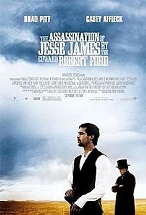
On Sept. 2, 2007 Andrew Dominik's The Assassination of Jesse James by the Coward Robert Ford (Virtual Studios) (Warner Bros.) debuts, based on the 1983 Ron Hansen novel, starring Brad Pitt as Jesse James (1847-82), Sam Shepard as Frank James (1843-1915), Cassey Affleck as "dirty little coward" Robert "Bob" Ford (1862-92), and Sam Rockwell as his brother Charley Ford (1857-84), who whack him on Apr. 3, 1882; coulda been an Oscar contender if it wasn't so long (160 min.)?; does $15M box office on a $30M budget.

On Nov. 9, 2007 Ethan Coen's and Joel Coen's No Country for Old Men (Miramax Films) (Paramount Vantage) debuts, based on the 2005 Cormac McCarthy novel set in 1980 Sanderson, Tex., starring Josh Brolin as Vietnam vet and welder Llewelyn Moss, who comes upon a bad drug deal in the Tex. desert and steals a suitcase stuffed with $2M and a devilish transponder (which he is too dumb to find until it's way too late, yet seems to know about as he plays games with it in a motel air duct, one of many plot problems?); Spanish star Javier Bardem plays ultimate hired assassin Anton Chigurh, who wears a silly pageboy haircut and carries a bulky air gun (used in slaughterhouses) because it leaves no bullets behind (like nobody sees him carrying the equipment around?), and who channels the dark morality of the ancient Aztecs while ruthlessly hunting Moss, leaving a trail of corpses who called the coin flip wrong; Woody Harrelson stars as fallible white knight Carson Wells, and Tommy Lee Jones as old man sheriff Ed Tom Bell, who is caught in the middle and fails like an old man, while bad guy Bardem gets away with everything, modulo a few unlikely accidents?; Kelly Macdonald plays Brolin's innocent babe Carla Jean Moss, who is allowed to call heads or tails to save her life, and isn't resolved onscreen until Bardem leaves her and checks his boots for blood on her porch; Gene Jomes play gas station clerk Thomas Thayer, who calls it correctly; Beth Grant plays Carla's mother; the whole flick leaves an impression of an ancient morality play turned inside out?; does $171.6M box office on a $25M budget; "Some of the old-time sheriffs never even wore a gun, some folks find that hard to believe... You can't help but compare yourself against the old-timers"; "There are no laws left. You can't stop what's coming"; "There are no clean getaways"; watch trailer.
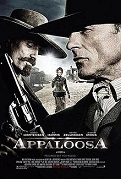
On Sept. 19, 2008 Ed Harris' Appaloosa (New Line Cinema) debuts, based on the 2005 novel by Robert B. Parker channeling Tombstone, Ariz., starring Harris as lawman Virgil Cole, who is hired along with deputy Everett Hitch (Viggo Mortensen) to protect the lawless town of 1882 Appaloosa, N.M. from rancher Randall Bragg (Jeremy Irons); Renee Zellweger plays Hitch's babe Allie French; does $27.7M box office on a $20M budget.

On Nov. 6, 2011 (Sun.) the Western series Hell on Wheels debuts on AMC for 57 episodes (until July 23, 2016), about the building of the Union Pacific Railroad after the 1865 assassination of Pres. Lincoln, starring Anson Adams Mount IV (1973-) as chief engineer Cullen Bohannon, Colm J. Meaney (1953-) a mean investor Thomas "Doc" Durant, and Common (Lonnie Rashid Lynn Jr.) (1972-) as freed slave Elam Ferguson.
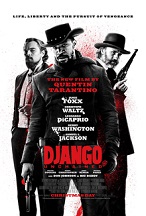
On Dec. 11, 2012 Quentin Tarantino's Django Unchained (A Band Apart) (The Weinstein Co.) (Columbia Pictures) debuts, a stylized tribute to Spaghetti Westerns esp. the 1966 film "Django" by Sergio Corbucci, set in the antebellum Deep South and Old West stars Christoph Waltz as a bounter hunter chasing freed slave Jamie Foxx, who's trying to rescue his wife Kerry Washington from cruel plantation owner Leonardo DiCaprio, turning the Western inside-out and upside-down; "Django" star Franco Nero has a cameo; does $425.4M box office on a $100M budget.
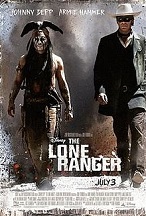
On June 22, 2013 Gore Verbinski's The Lone Ranger (Walt Disney Pictures) debuts, starring Armie Hammer as Tex. Ranger John Reid AKA the Lone Ranger, and Johnny Depp as Tonto in a PC version twisted against the palefaces; does $260.5M box office on a $250M budget, making it a big flop after spending $150M on marketing.
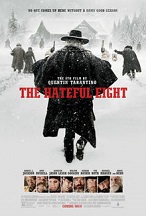
On Dec. 7, 2015 Quentin Tarantino's The Hateful (H8ful) Eight (The Weinstein Co.) debuts, his 2nd Western after "Django Unchained" (2012), filmed in Telluride, Colo., starring Samuel L. Jackson, Kurt Russell, Jennifer Jason Leigh et al. in a yarn set in Wyo. after the U.S. Civil War, about eight you know whats seeking refuge in a stagecoach stop on a mountain pass during a blizzard; music by Ennio Morricone; does $155.8M box office on a $54M budget.
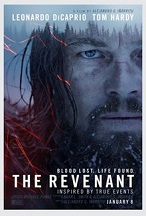
On Dec. 16, 2015 Alejandro G. Inarritu's The Revenant (20th Cent. Fox) debuts, based on the 2002 Michael Punke novel about Am. frontiersman Hugh Glass in 1823 Missouri Territory, starring Leonardo DiCaprio as Glass, who is mauled by a bear and left for dead by John Fitzgerald (Tom Hardy), and gets revenge; does $533M box office on a $135M budget.
In Jan. 2016 there are 556 legally-recognized Native Am. tribes in the U.S., down from 1K+ before the Euro palacefaces first moved in.